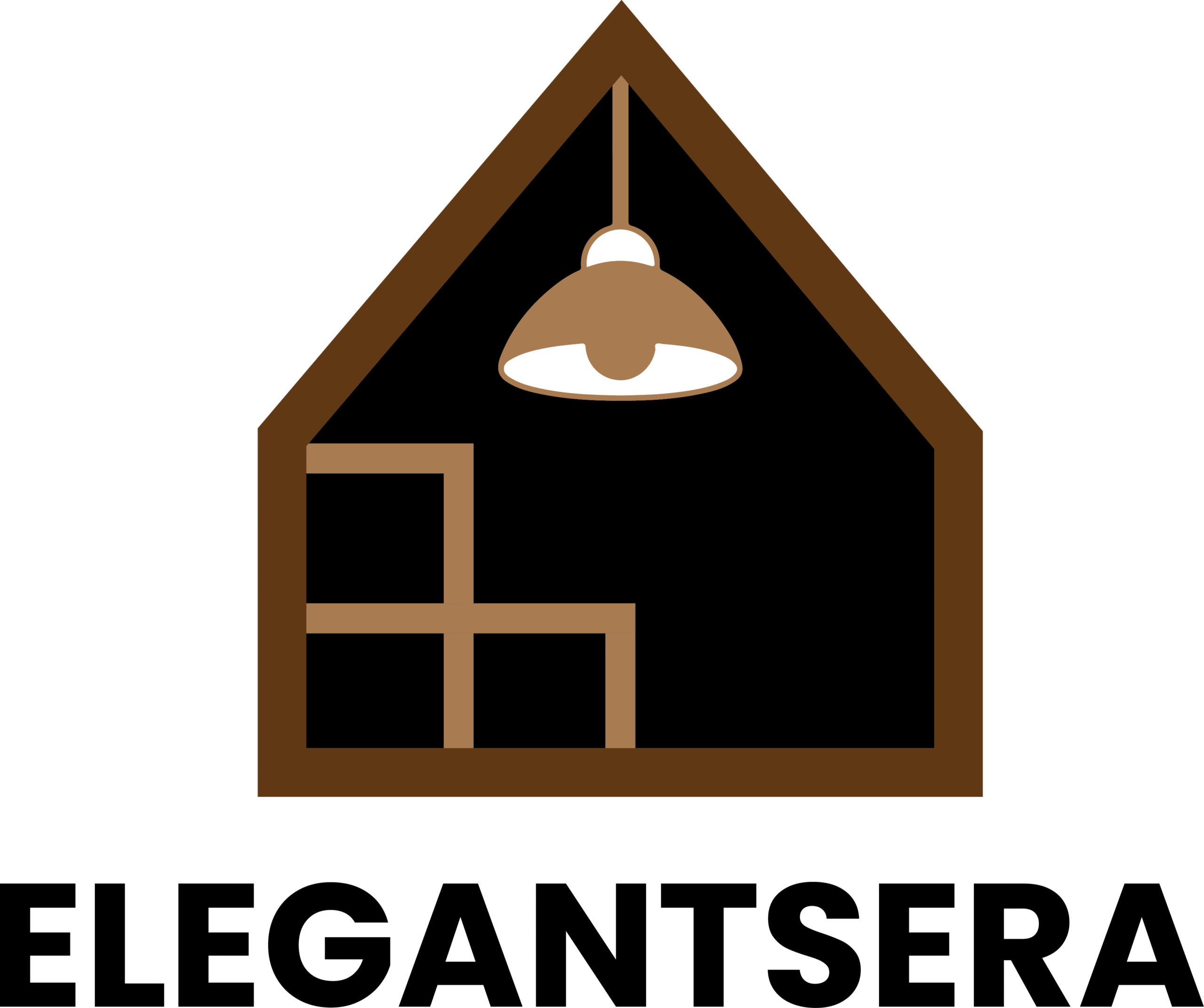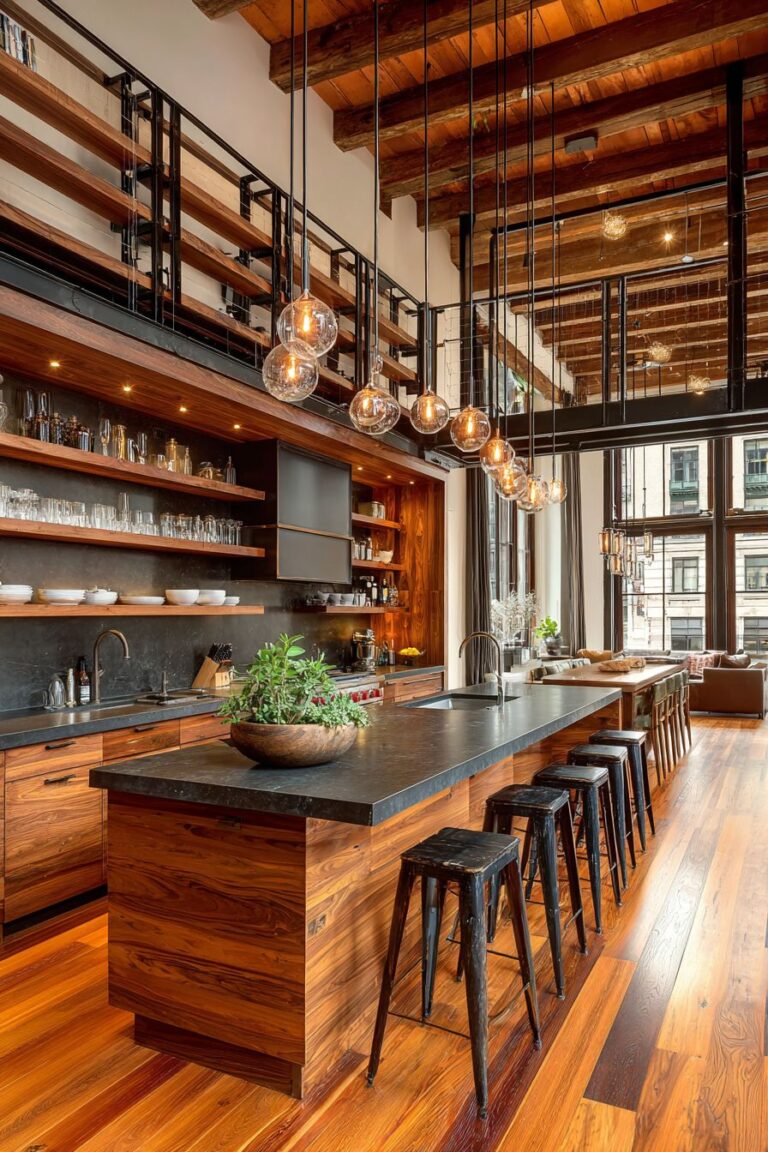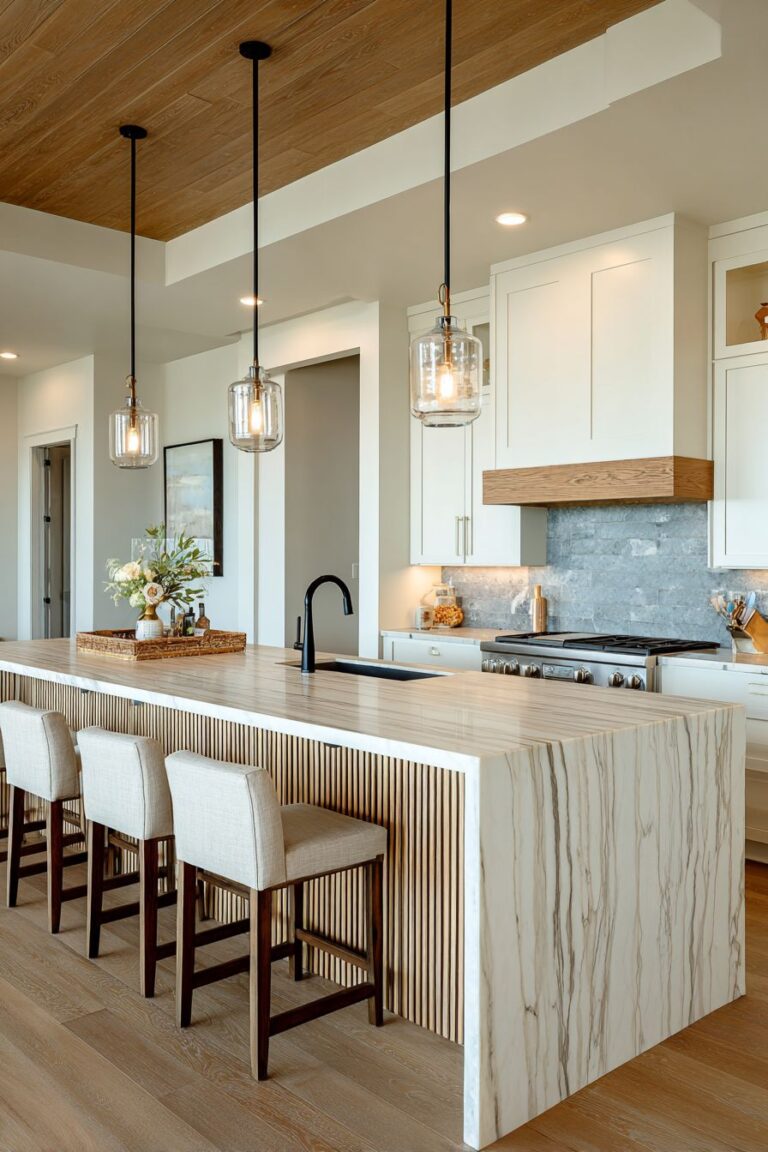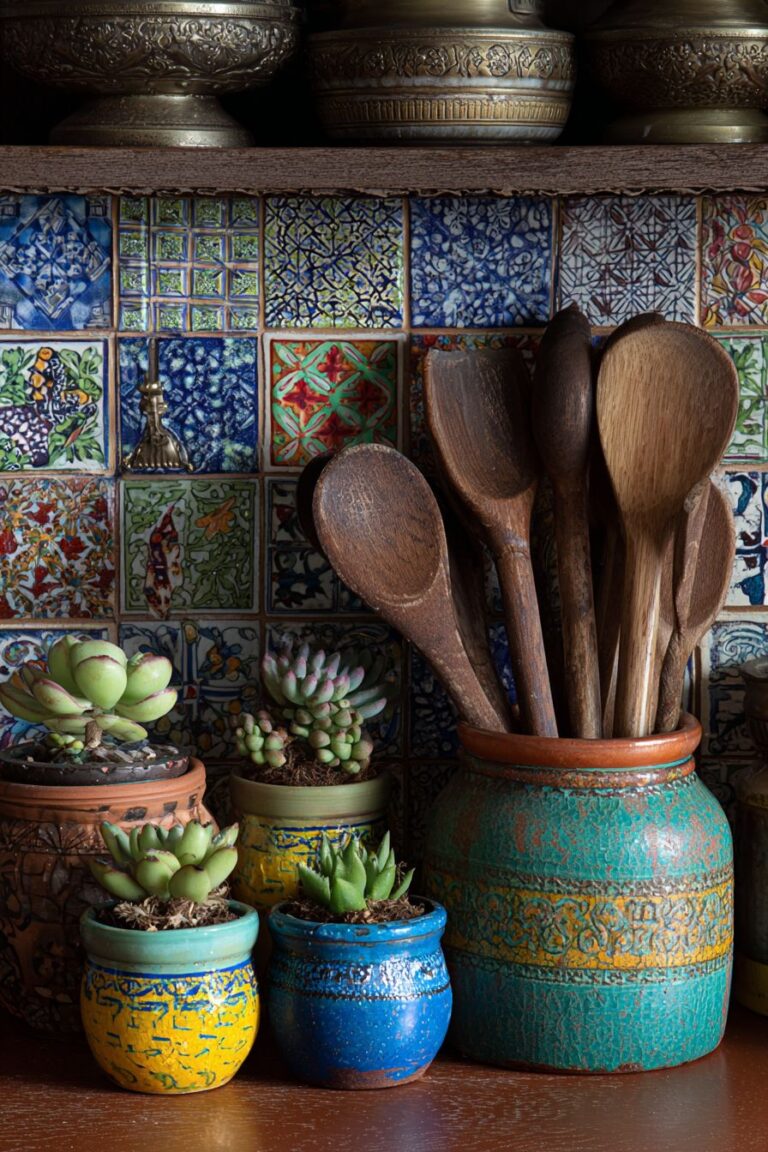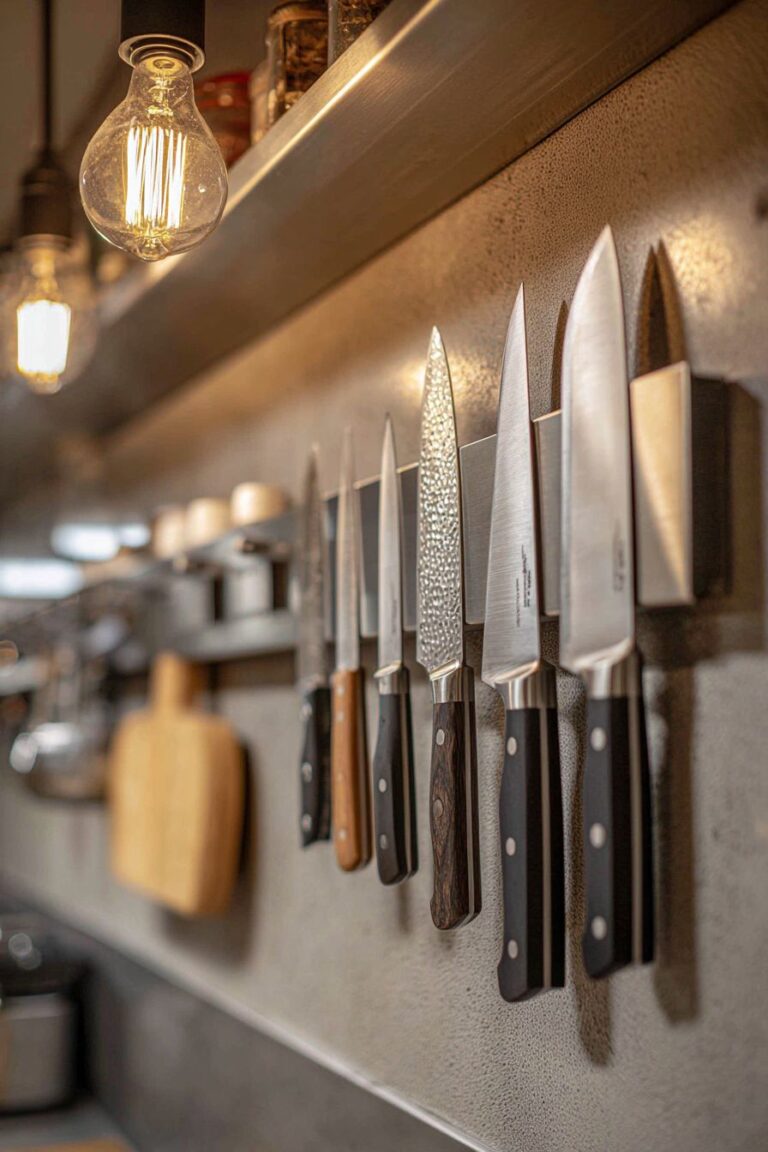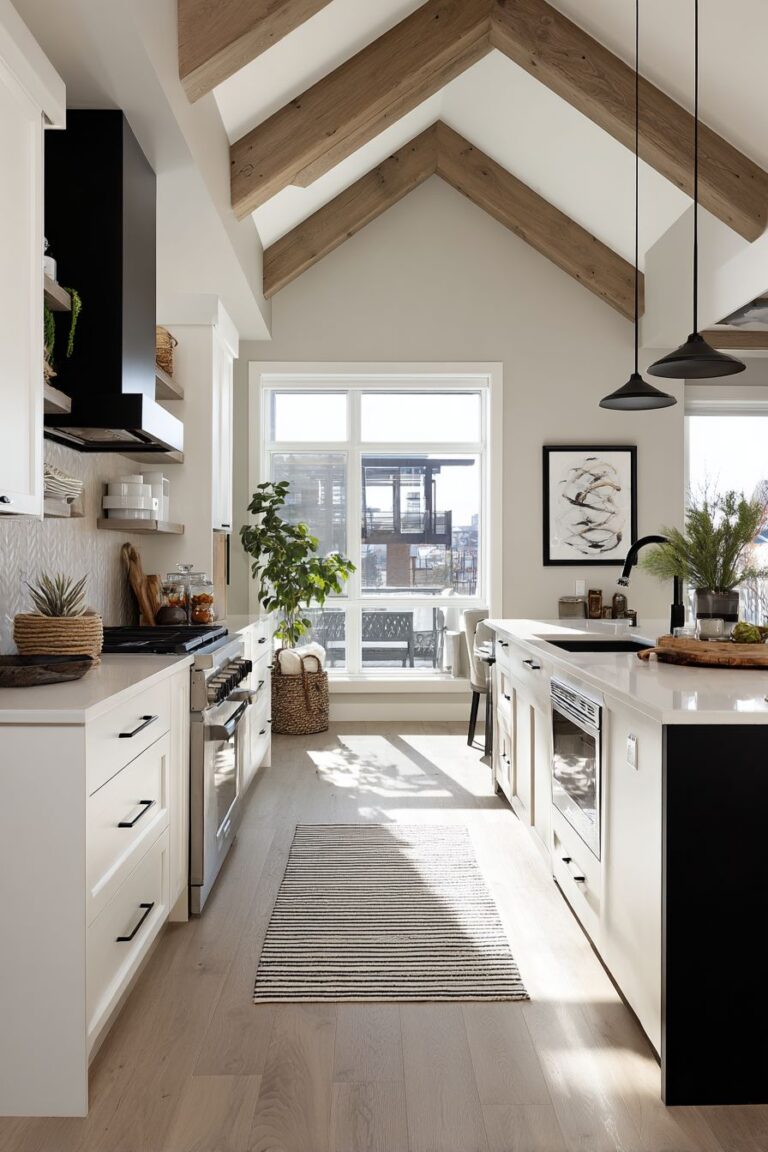Kitchen Utensils Ideas: 20 Essential Designs for Every Culinary Space
The heart of every home beats strongest in the kitchen, where culinary dreams transform into delicious realities through the artful arrangement of essential tools and thoughtful design. Kitchen utensils represent far more than mere functional implements – they embody the soul of cooking, reflecting personal style, cultural heritage, and the intimate relationship between chef and craft. The careful selection and organization of these indispensable tools can elevate any kitchen from a simple workspace into an inspiring culinary sanctuary that beckons creativity and nourishes both body and spirit.
Modern interior design has embraced the concept that kitchen utensils deserve as much aesthetic consideration as any decorative element, recognizing that beauty and functionality need not be mutually exclusive. Today’s discerning homeowners understand that the visual presentation of cooking tools contributes significantly to the overall ambiance of their culinary spaces, creating environments that inspire confidence and joy in the cooking process. From sleek contemporary displays to rustic farmhouse collections, the world of kitchen utensil design offers endless possibilities for personal expression while maintaining the practical efficiency that serious cooking demands.
This comprehensive exploration delves into twenty distinct approaches to kitchen utensil design and organization, each representing a unique philosophy of culinary living. These carefully curated concepts demonstrate how different materials, storage solutions, and aesthetic principles can transform ordinary cooking implements into extraordinary design statements that enhance both the functionality and visual appeal of any kitchen space, regardless of size, style, or budget constraints.
1. Modern Magnetic Wall Organization
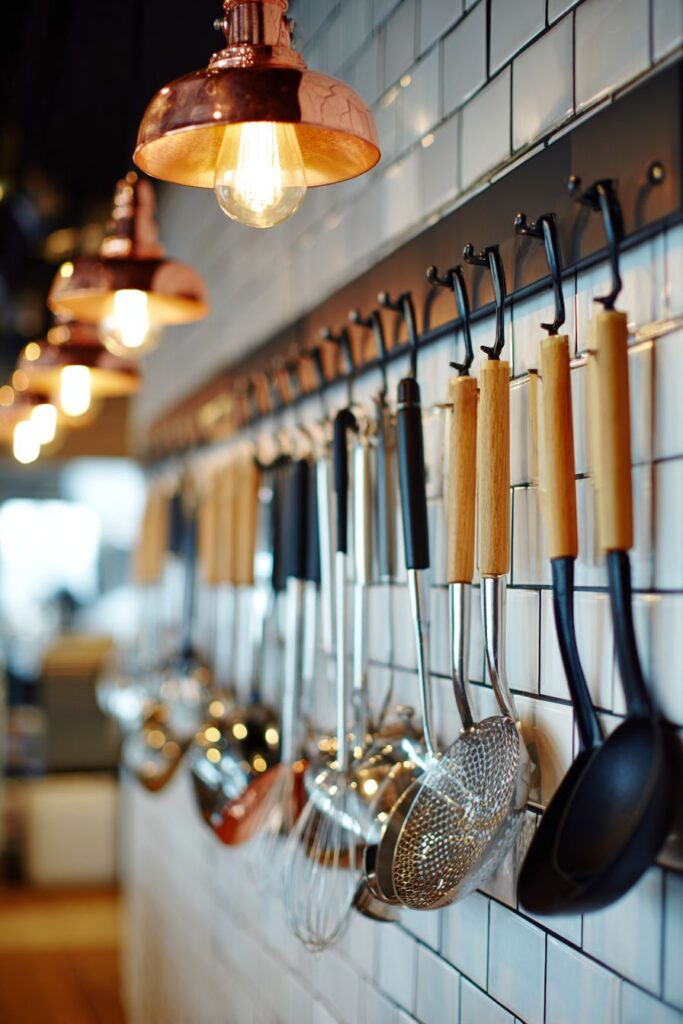
The contemporary kitchen embraces minimalism without sacrificing functionality, and magnetic wall storage represents the pinnacle of this design philosophy. Stainless steel and copper utensils suspended from sleek magnetic strips create a floating display that combines artistic visual appeal with immediate accessibility. The interplay between different metallic finishes adds depth and sophistication to the space, while the clean lines of professional-grade tongs, whisks, and ladles demonstrate the beauty inherent in well-designed tools.
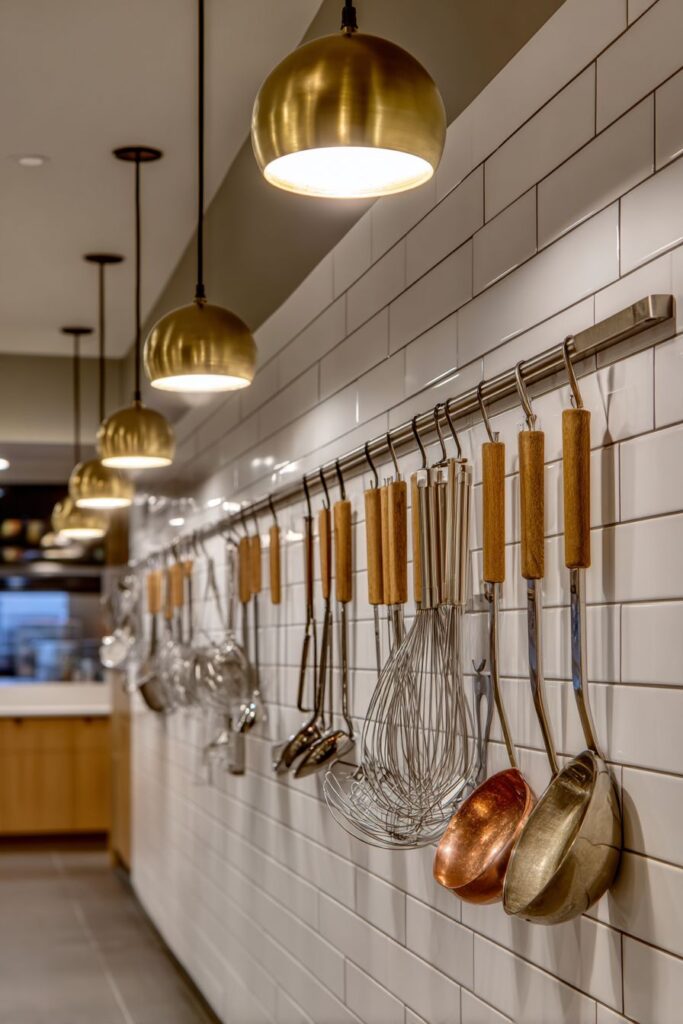
The strategic placement of these magnetic organizers against white subway tile backsplashes creates a stunning contrast that highlights each utensil’s unique form and finish. Natural wood handles provide warmth and tactile comfort, softening the industrial edge of metal surfaces while maintaining the overall contemporary aesthetic. The absence of bulky storage containers allows the kitchen to feel more spacious and uncluttered, with each tool earning its place through both beauty and utility.

Warm pendant lighting plays a crucial role in this design approach, creating subtle reflections that dance across metallic surfaces throughout the day. The changing light conditions transform the utensil display from a purely functional element into a dynamic art installation that evolves with the kitchen’s natural rhythms. This lighting strategy also ensures that tools remain easily identifiable and accessible during cooking activities, eliminating the frustration of rummaging through crowded drawers.
The magnetic system offers unparalleled flexibility, allowing cooks to rearrange their tools based on current projects or seasonal cooking preferences. Professional-grade copper utensils develop a beautiful patina over time, adding character and history to the display while maintaining their superior heat conductivity and antimicrobial properties.
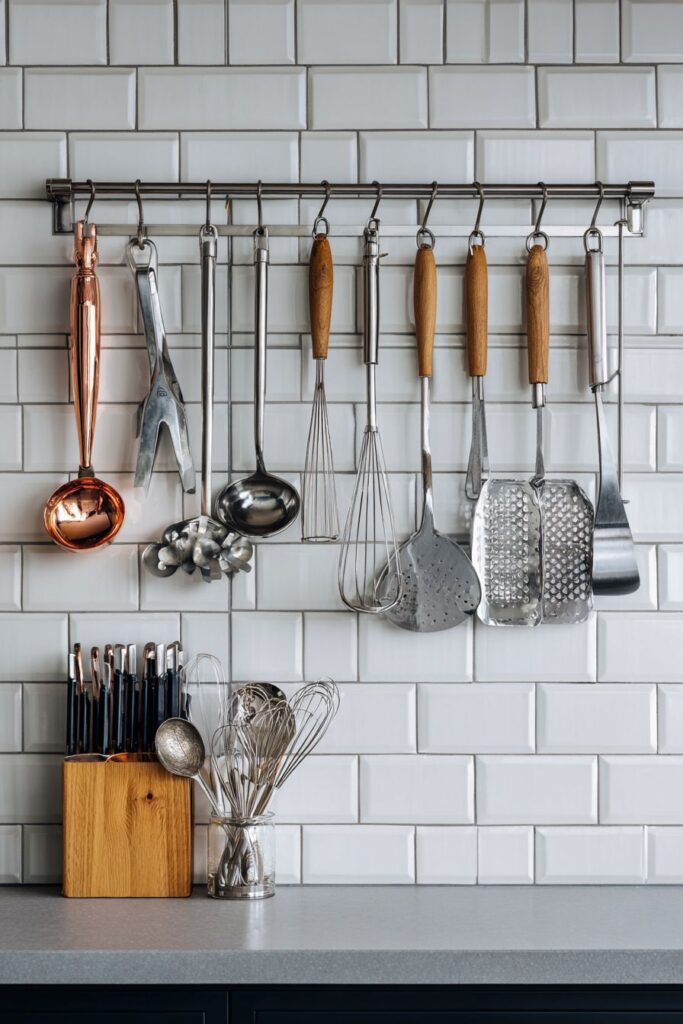
Key Design Tips:
- Install magnetic strips at varying heights to accommodate different utensil lengths and create visual interest
- Choose tools with complementary handle materials to maintain cohesive aesthetic appeal
- Position strips near cooking zones for maximum efficiency and workflow optimization
- Invest in high-quality magnetic strips that can support heavier implements without sagging
- Consider the reflection patterns when planning lighting placement to enhance the metallic displays
2. Farmhouse Ceramic Crock Collection
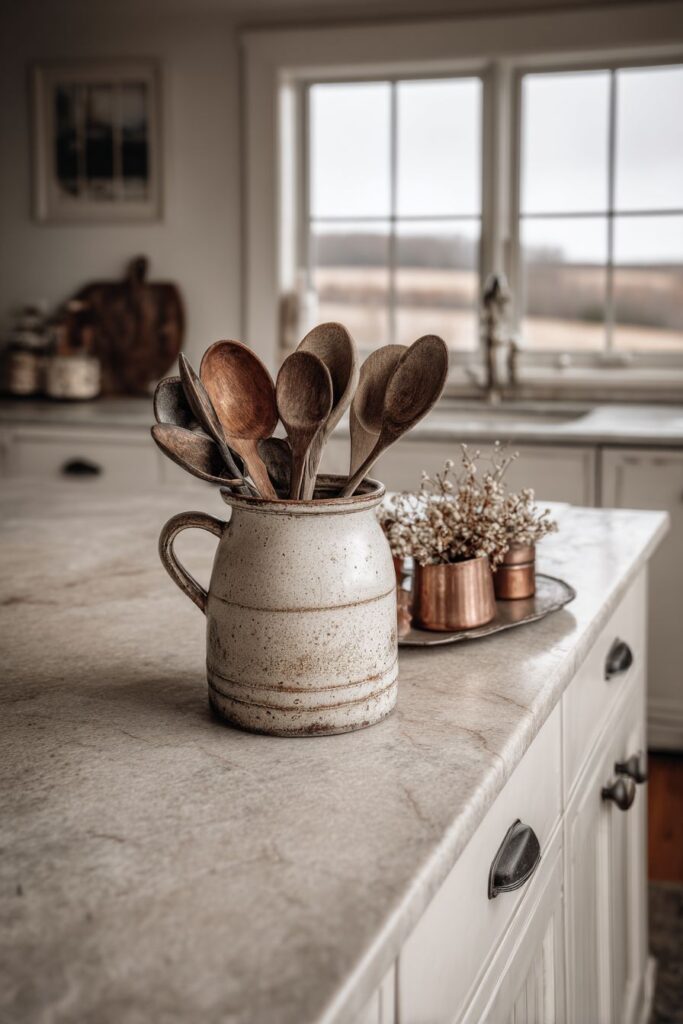
The timeless appeal of farmhouse design finds perfect expression in vintage-inspired ceramic crocks that showcase kitchen utensils with rustic elegance and authentic charm. These handcrafted ceramic containers with weathered patinas tell stories of generations past while providing practical storage for an eclectic collection of traditional cooking implements. The organic irregularities and subtle color variations inherent in artisanal ceramics create a warm, inviting atmosphere that celebrates the imperfect beauty of handmade objects.
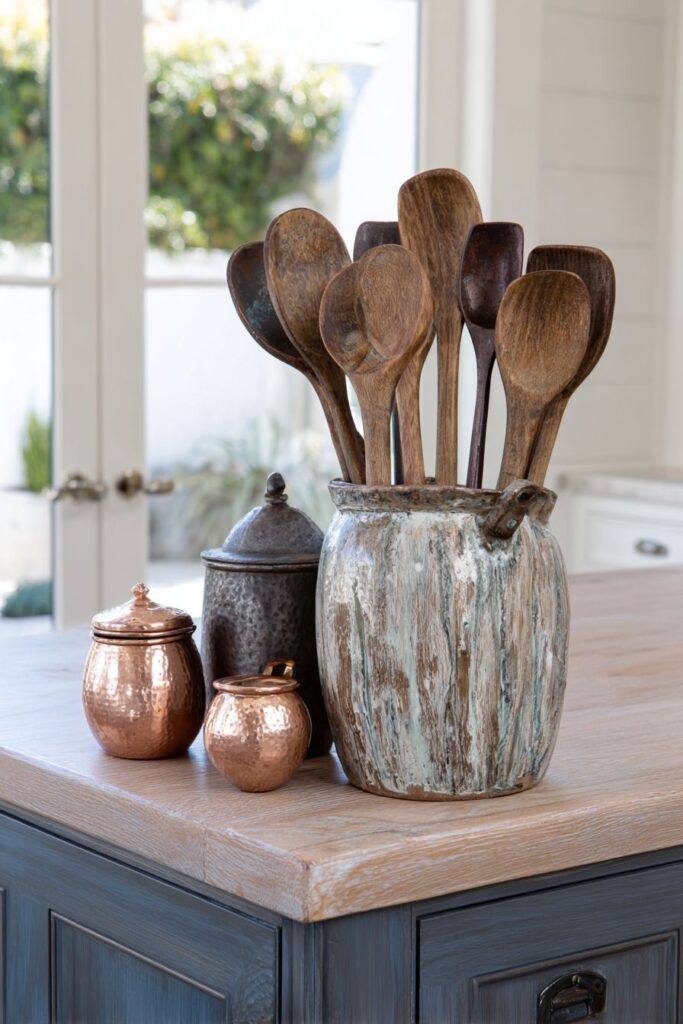
Wooden spoons with natural grain variations nestle alongside antique copper measuring cups, creating a tactile symphony of materials that speaks to the soul of traditional cooking. The honest wear patterns and gentle aging of these implements reflect years of faithful service, transforming everyday tools into cherished heirlooms. Cast iron serving pieces add substantial weight and historical gravitas to the collection, their dark surfaces providing dramatic contrast against lighter ceramic backgrounds.
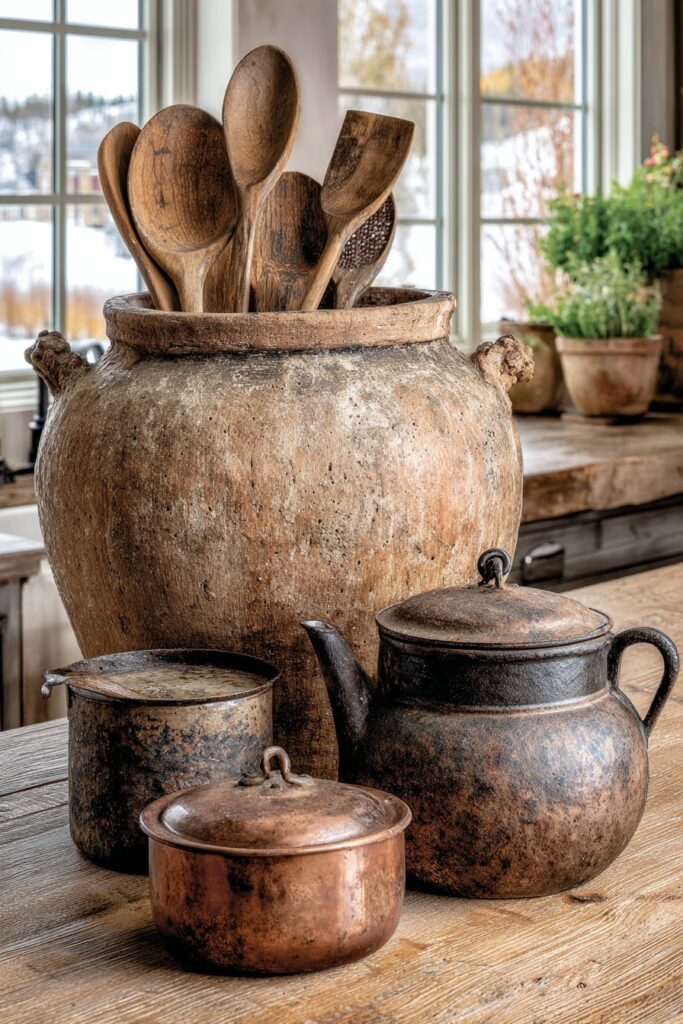
Natural daylight streaming through nearby windows illuminates the authentic textures and brings out the subtle color nuances in aged finishes. The interplay between light and shadow across irregular ceramic surfaces creates an ever-changing display that maintains visual interest throughout the day. This natural lighting approach honors the farmhouse tradition of working with available light while showcasing the inherent beauty of well-used cooking tools.
The ceramic crock system offers generous storage capacity while maintaining easy access to frequently used implements. Vintage copper measuring cups develop distinctive verdigris patinas that add color and character to the collection, while their superior heat conductivity makes them practical choices for serious baking endeavors. The substantial weight and satisfying feel of traditional materials provide a grounding connection to culinary heritage that plastic alternatives simply cannot match.
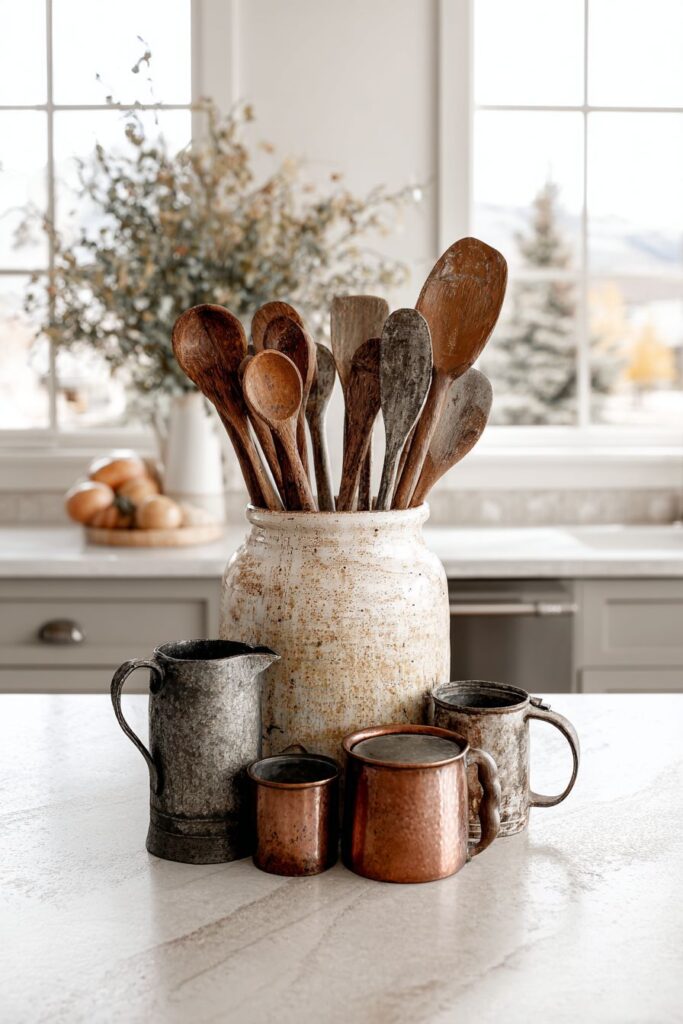
Key Design Tips:
- Select crocks with varying sizes to accommodate different tool types and create visual hierarchy
- Embrace the patina and wear patterns that develop naturally over time as part of the design aesthetic
- Position collections near natural light sources to highlight material textures and colors
- Mix different ceramic glazes and finishes to add depth while maintaining color harmony
- Include a few pristine pieces alongside aged items to create intriguing visual contrast
3. Scandinavian Drawer Divider System
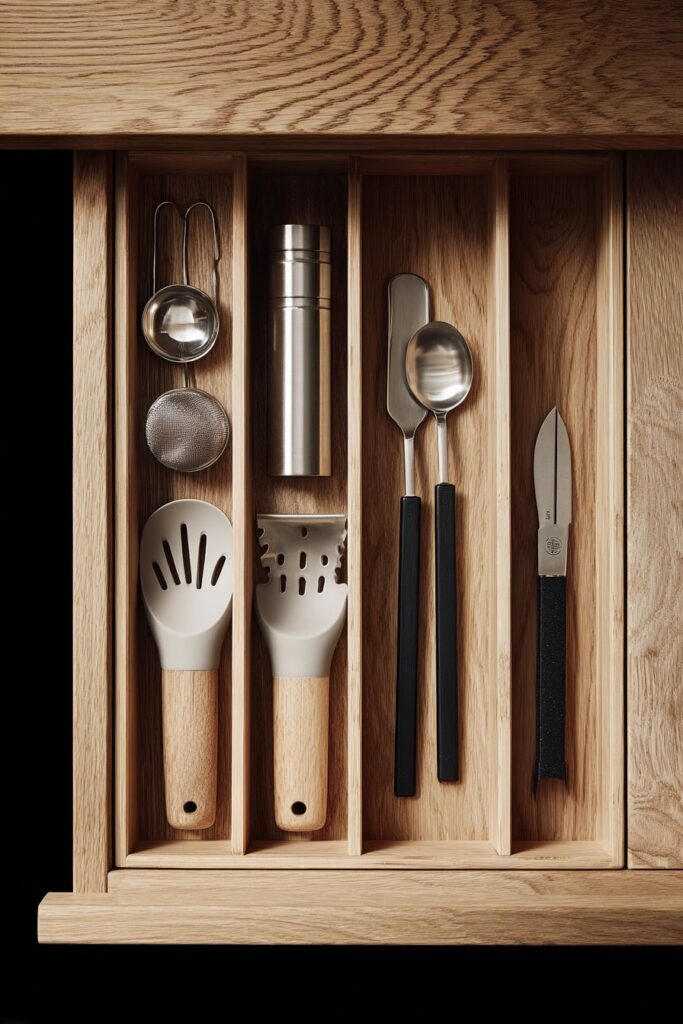
The essence of Scandinavian design philosophy shines through in meticulously organized drawer systems that celebrate clean lines, sustainable materials, and functional beauty. Bamboo dividers create perfect compartments for essential kitchen utensils, demonstrating how thoughtful organization can transform hidden storage into a source of daily joy and efficiency. The natural warmth of light oak drawer interiors provides a beautiful contrast to the cool precision of stainless steel measuring spoons and the modern sophistication of sleek silicone spatulas.
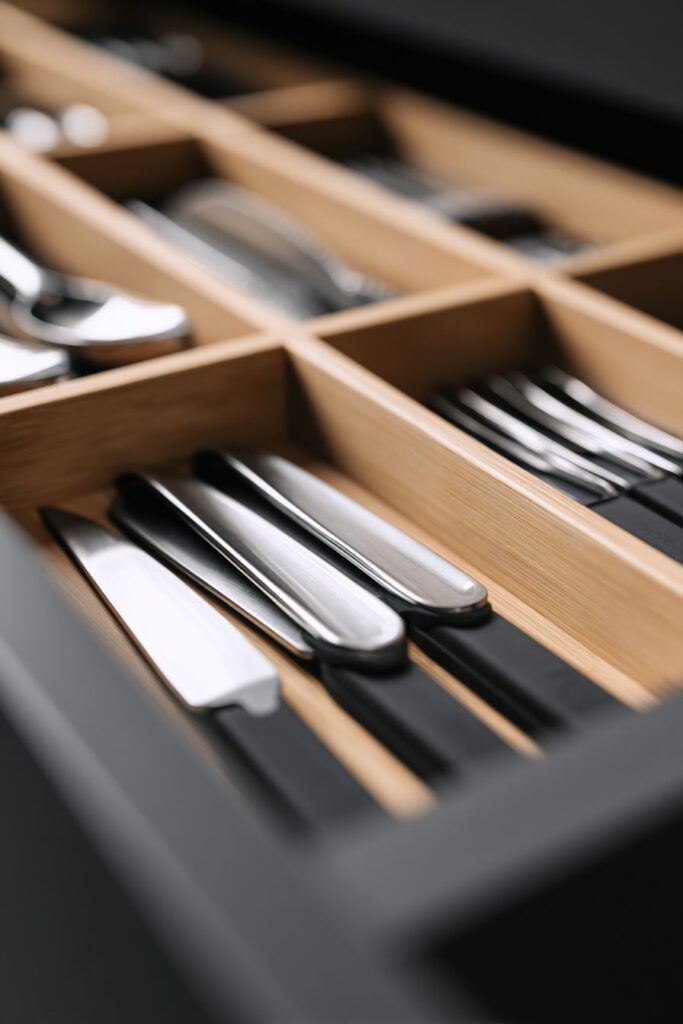
This approach to utensil storage reflects the Scandinavian principle of lagom – the concept of having just enough, nothing more, nothing less. Each tool earns its designated space through careful consideration of function, frequency of use, and aesthetic contribution to the whole. Precision kitchen shears with matte black handles exemplify this philosophy, combining superior functionality with understated visual appeal that complements rather than competes with surrounding elements.
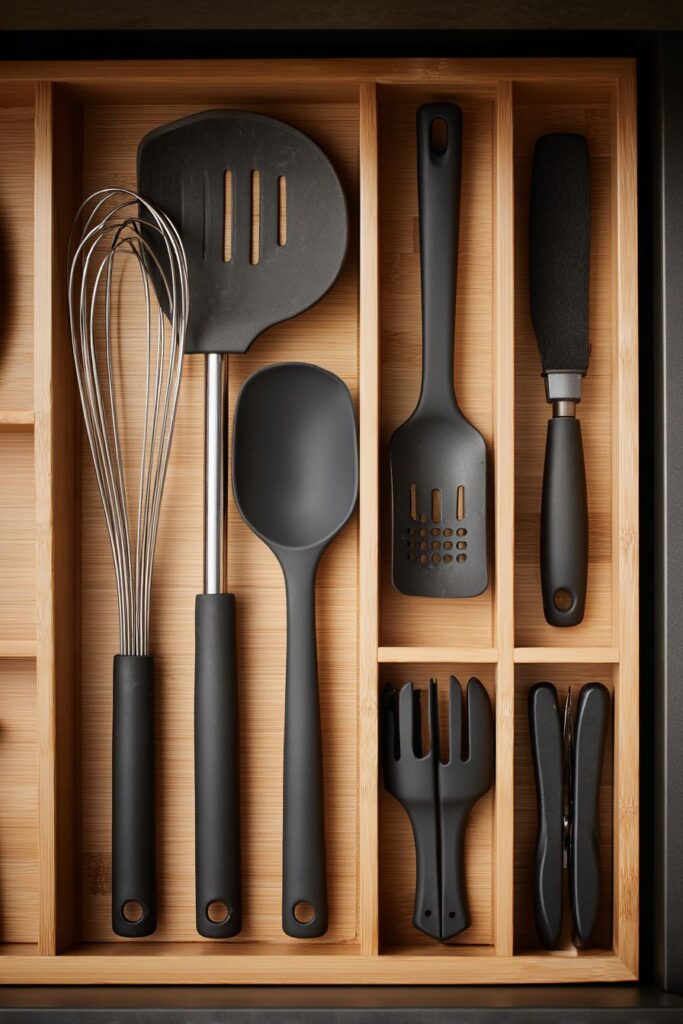
The custom compartmentalization allows for precise organization that maintains its integrity over time, unlike loose drawer organizers that shift and slide with use. Soft diffused lighting, whether natural or artificial, emphasizes the orderly arrangement and highlights the sustainable materials that form the foundation of this storage philosophy. The interplay between organic bamboo textures and smooth manufactured surfaces creates visual interest while maintaining the serene simplicity that defines Scandinavian design.
Sustainable materials take center stage in this organizational approach, reflecting growing environmental consciousness while delivering superior performance and longevity. Bamboo’s rapid renewability and natural antimicrobial properties make it an ideal choice for kitchen applications, while its warm golden tones add life to otherwise sterile storage spaces. The precision-fit nature of custom dividers eliminates wasted space and prevents the accumulation of debris that plagues poorly designed storage systems.
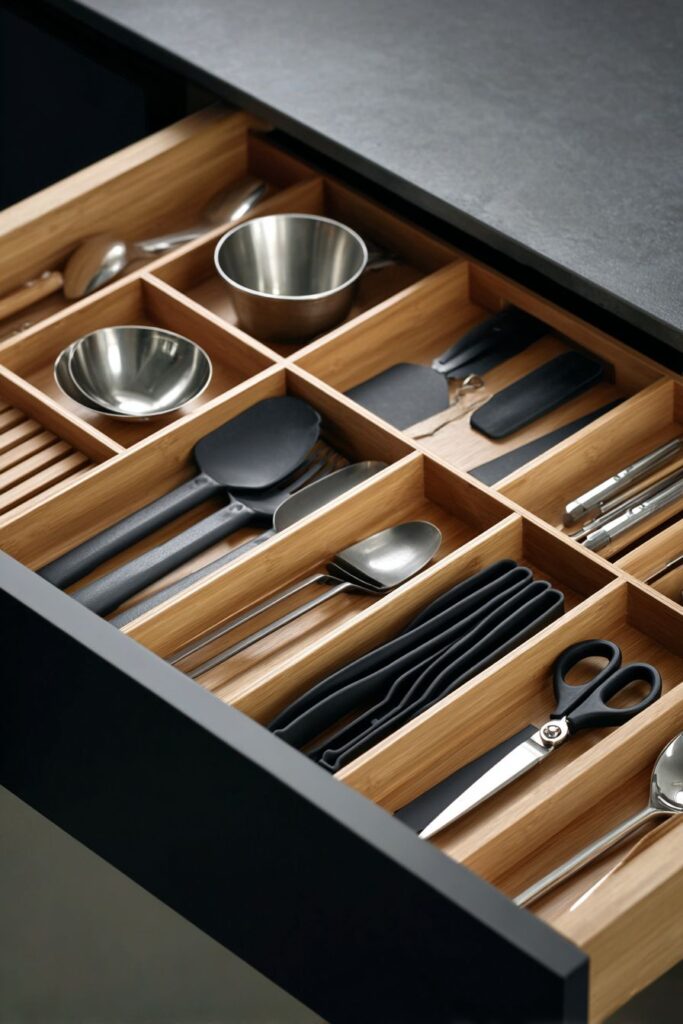
Key Design Tips:
- Measure utensils carefully before designing compartments to ensure perfect fit without wasted space
- Choose tools with complementary handle colors and materials to maintain visual cohesion
- Position frequently used items in the most accessible locations within the drawer system
- Include a few empty compartments for future tool acquisitions or seasonal rotation
- Consider drawer depth carefully to prevent tools from jumping compartments during opening and closing
4. Contemporary Floating Shelf Display
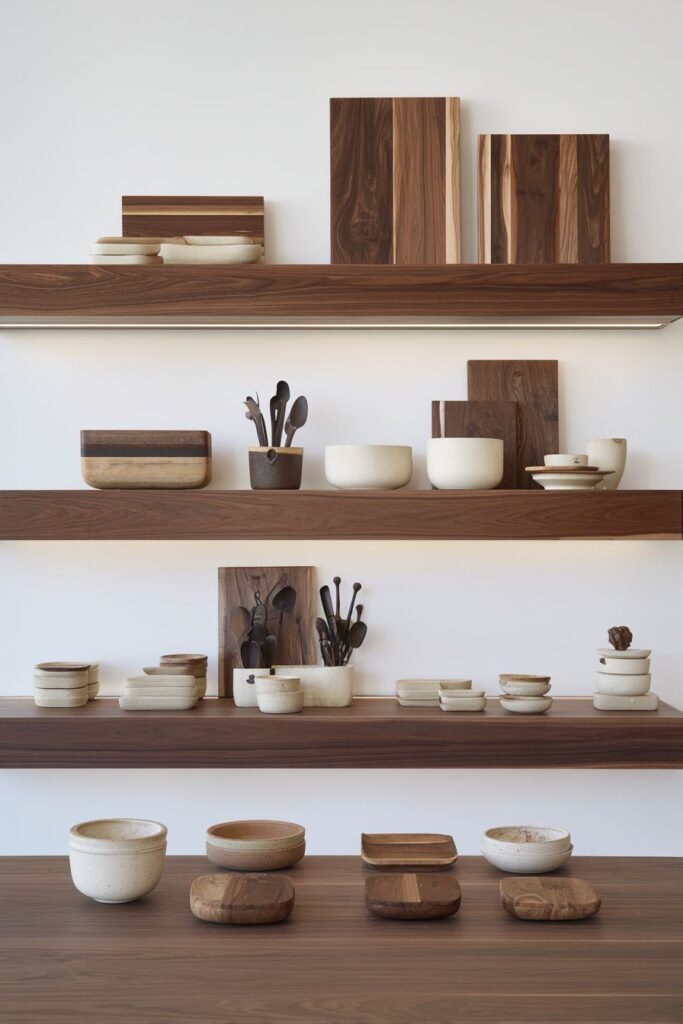
Contemporary kitchen design embraces the concept of functional art, and floating walnut shelves with integrated LED strip lighting transform kitchen utensils into a sophisticated display worthy of museum-quality presentation. The rich grain patterns and warm undertones of walnut wood provide an organic counterpoint to clean white walls, creating a visual anchor that grounds the space while maintaining contemporary elegance. This approach celebrates the inherent beauty of well-designed tools by presenting them as sculptural elements rather than hiding them away in drawers or cabinets.

Artisanal wooden cutting boards become focal points when displayed vertically, their unique grain patterns and edge details creating natural artwork that changes with viewing angle and lighting conditions. Hand-forged iron serving spoons demonstrate the marriage of traditional craftsmanship with contemporary presentation, their irregular surfaces and oxidized finishes adding texture and character to the curated collection. Ceramic mixing bowls in neutral earth tones provide gentle color variation while maintaining the sophisticated restraint that defines contemporary design aesthetics.
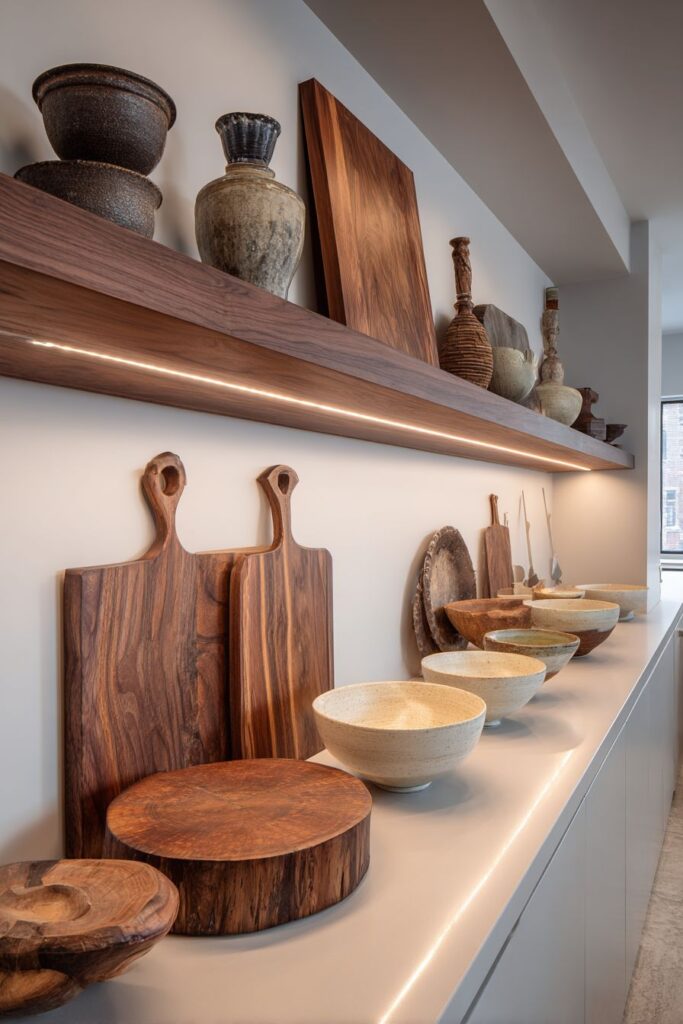
The integrated LED strip lighting serves multiple functions beyond mere illumination, creating dramatic shadow play that emphasizes the three-dimensional qualities of displayed objects. This sophisticated lighting approach transforms the shelf system into an ever-changing art installation that responds to different times of day and seasonal light variations. The warm color temperature of LED strips complements the natural warmth of walnut while ensuring that tools remain easily identifiable for practical use.
The floating shelf concept maximizes visual impact while minimizing physical intrusion into the kitchen workspace, maintaining the clean lines and open feel that contemporary design demands. Material interplay between warm wood, cool metal, and neutral ceramics creates visual richness without overwhelming the senses, demonstrating how thoughtful curation can elevate everyday objects into extraordinary displays.
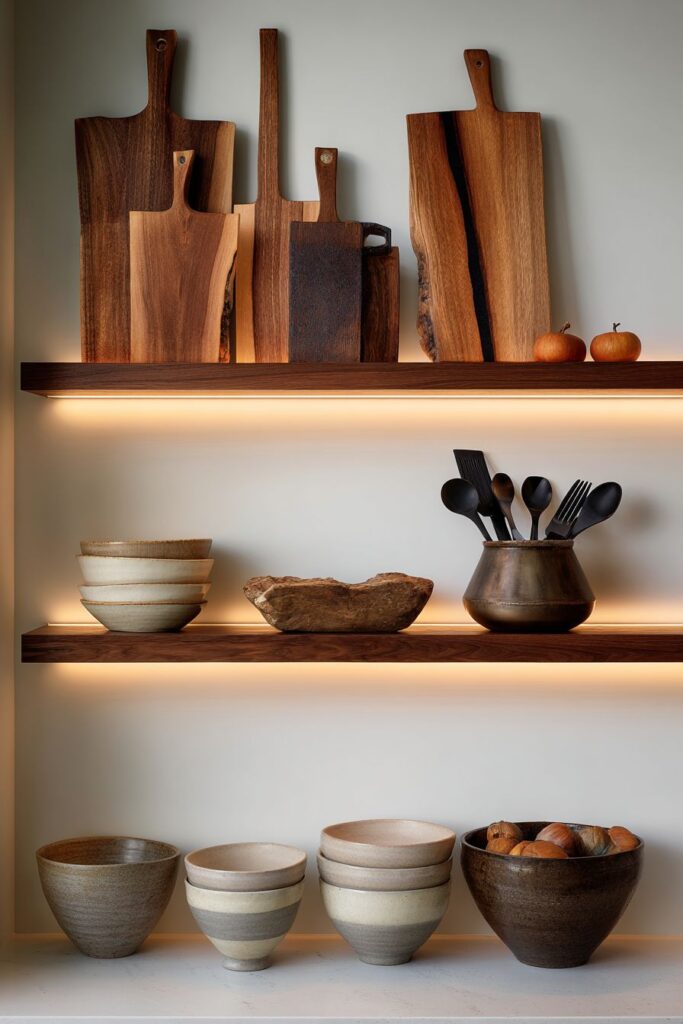
Key Design Tips:
- Install shelves at varying heights to create dynamic visual rhythm and accommodate different object sizes
- Use LED strips with dimming capabilities to adjust lighting intensity based on time of day and occasion
- Group objects in odd numbers and vary heights within groupings for optimal visual appeal
- Leave breathing space between objects to prevent cluttered appearance and maintain contemporary cleanliness
- Consider the view from multiple angles when arranging displays to ensure appeal from all perspectives
5. Vertical Space Maximization Solutions
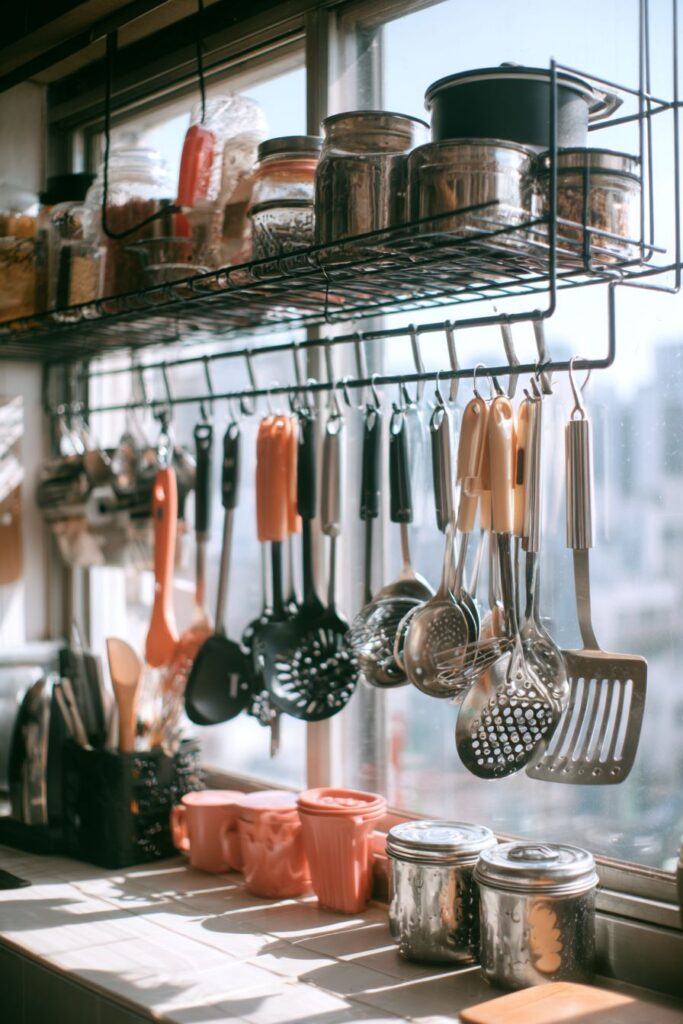
Small apartment living demands creative solutions that maximize every square inch of available space, and multi-tier vertical storage systems represent the triumph of intelligent design over spatial limitations. Matte black steel construction provides industrial strength and visual sophistication while maintaining the clean lines essential for small-space success. The strategic combination of hooks and shelves accommodates utensils of varying sizes and shapes, creating a comprehensive storage solution that transforms vertical wall space into highly functional culinary real estate.
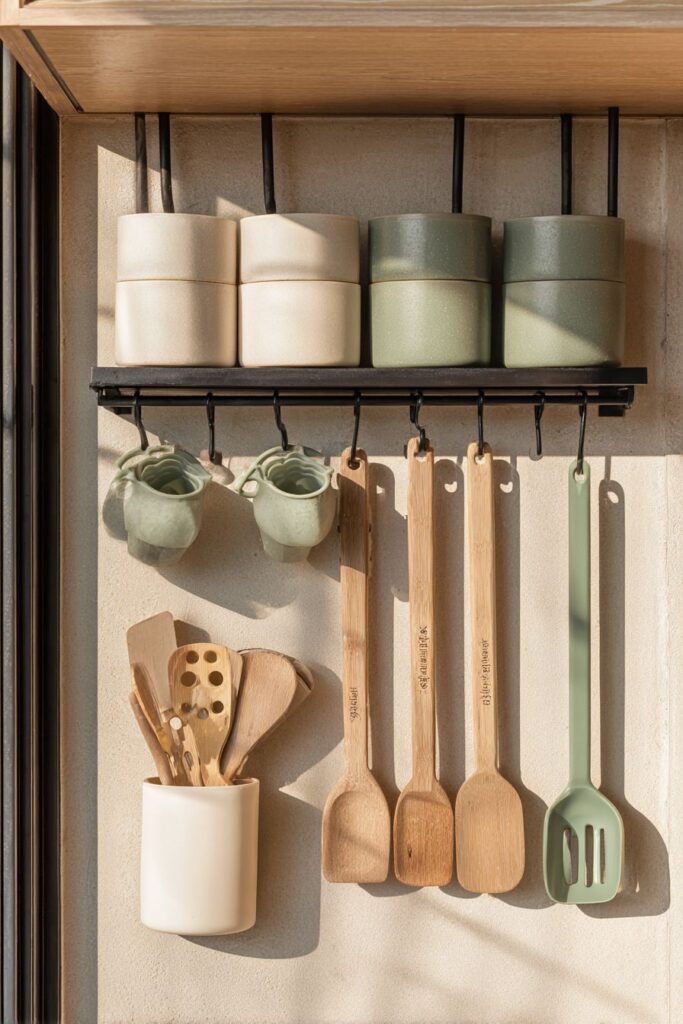
Nested measuring cups demonstrate the principle of space-efficient design, occupying minimal storage footprint while providing complete functionality for serious cooking endeavors. Collapsible silicone tools further exemplify this philosophy, expanding when needed for use but compacting to minimal dimensions for storage. Multi-functional utensils that serve multiple purposes reduce the total number of tools required while maintaining culinary versatility, making them essential elements of successful small-space kitchens.

Natural morning light creates gentle shadows that define the practical storage solution while adding visual interest to what might otherwise appear purely utilitarian. The interplay between light and shadow across the multi-level organization system creates depth and dimension, preventing the vertical display from appearing flat against the wall. This lighting consideration transforms functional storage into an attractive design element that enhances rather than detracts from the overall kitchen aesthetic.
The vertical approach to utensil storage keeps countertops clear and uncluttered, creating the illusion of more space while improving workflow efficiency. Urban living functionality demands that every element serve multiple purposes, and this storage system succeeds by providing organization, accessibility, and visual appeal simultaneously.
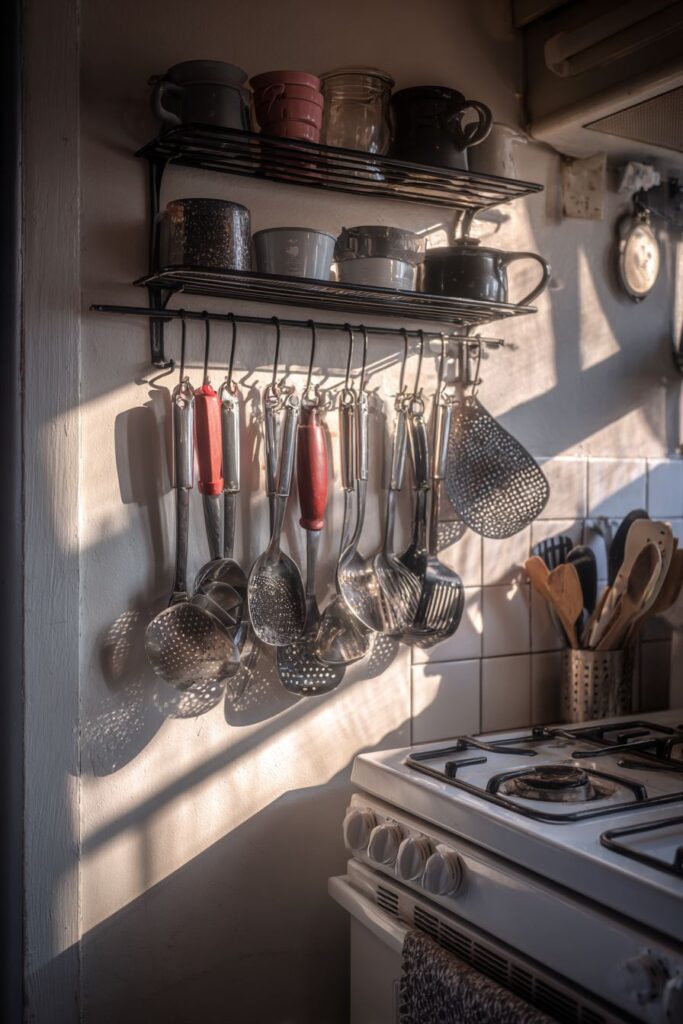
Key Design Tips:
- Position the most frequently used tools at eye level and within easy reach for optimal workflow
- Use consistent spacing between tiers to create visual rhythm and prevent cluttered appearance
- Choose tools with similar color palettes or handle materials to maintain cohesive aesthetic appeal
- Include adjustable elements that can accommodate changes in tool collection over time
- Consider the swing radius of doors and drawers when positioning vertical storage to prevent conflicts
6. French Country Copper Collection
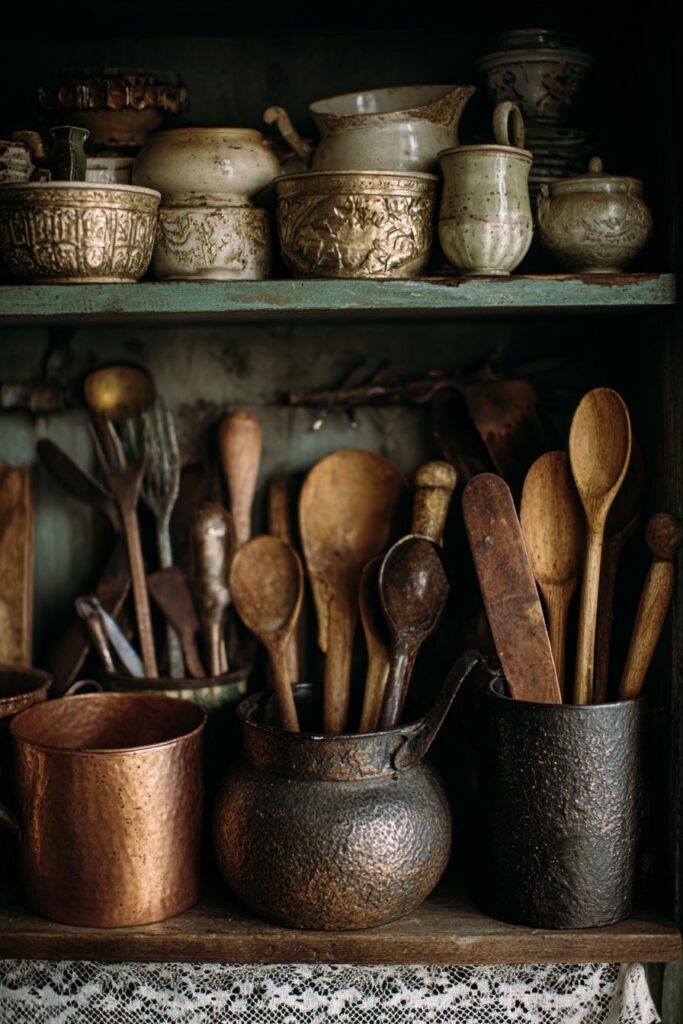
The timeless elegance of French country design celebrates the beauty of aged materials and the wisdom of traditional craftsmanship, finding perfect expression in kitchen utensils displayed within vintage copper pots and aged ceramic containers. This approach to kitchen organization honors the principle that beautiful tools deserve beautiful presentation, creating displays that rival any formal decorative arrangement while maintaining complete practical functionality. Well-patinated wooden spoons showcase the honest wear patterns that develop through years of faithful service, their smooth surfaces and gentle curves speaking to countless meals prepared with love and care.
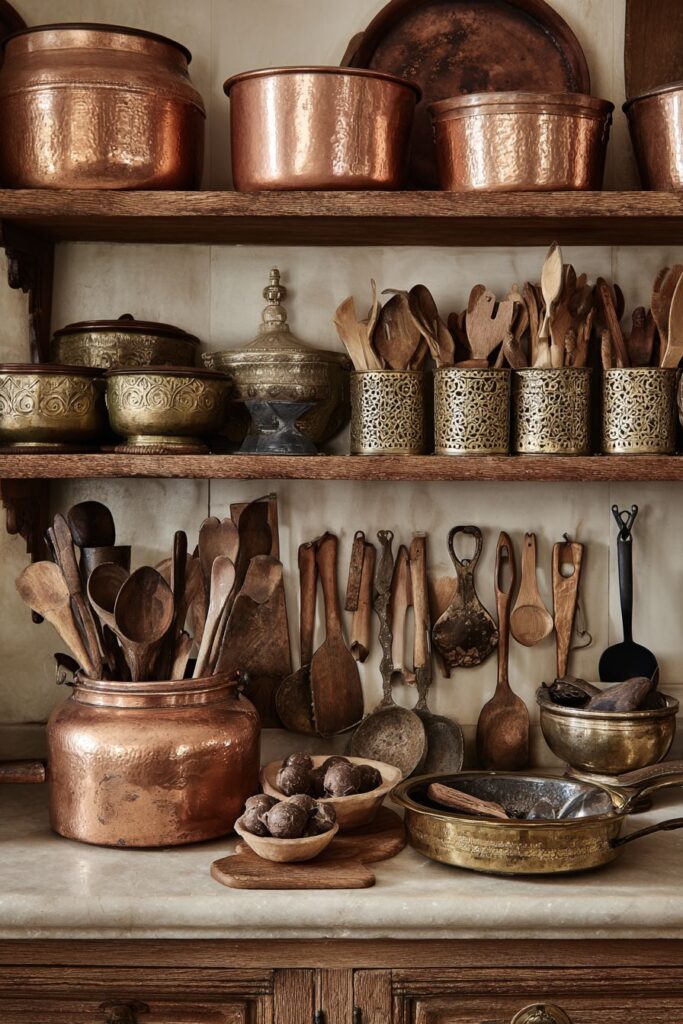
Antique brass measuring tools develop complex surface patinas that tell stories of generations past, their warm golden tones adding richness and depth to the overall collection. The natural oxidation processes that create these distinctive finishes cannot be replicated artificially, making authentic vintage pieces treasured additions to any French country kitchen. Time-worn cast iron implements provide substantial weight and gravitas, their dark surfaces creating dramatic contrast against lighter ceramic backgrounds while maintaining the heat retention and distribution properties that make them superior cooking tools.
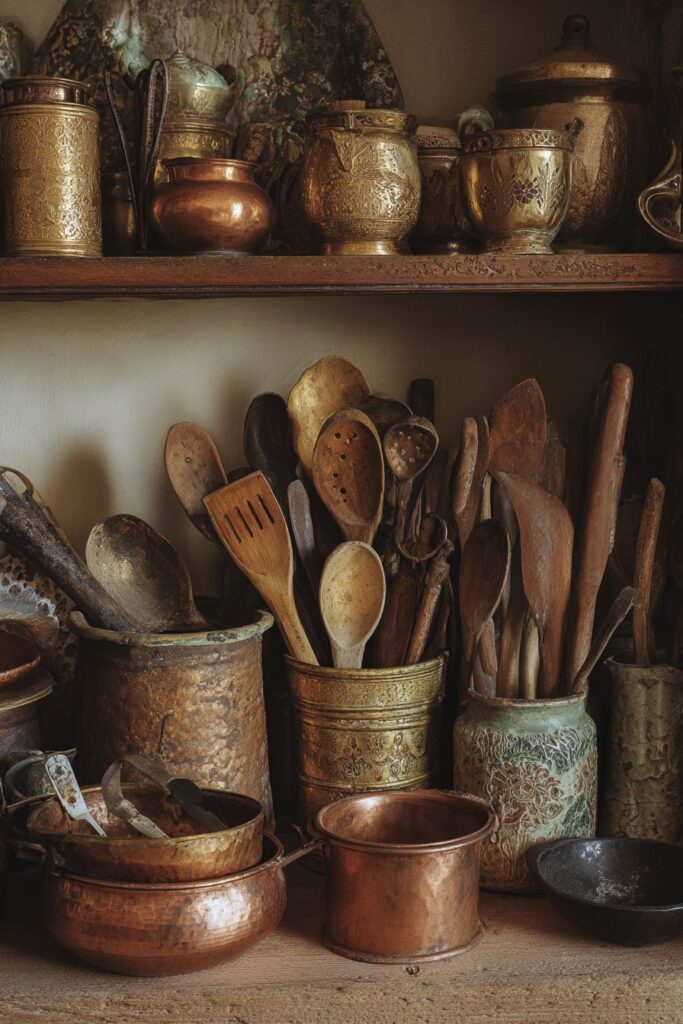
Warm golden hour lighting filters through lace curtains, creating the soft, romantic atmosphere that defines authentic French country interiors. This natural lighting approach changes throughout the day, casting different shadows and highlighting various aspects of the tool collection as the sun moves across the sky. The interplay between natural light and aged materials creates an ever-changing display that maintains visual interest while celebrating the inherent beauty of well-used cooking implements.
European charm permeates every aspect of this organizational philosophy, from the selection of materials to the casual arrangement that suggests tools are used daily rather than merely displayed. The lived-in elegance of this approach reflects the French appreciation for objects that improve with age and use, creating kitchen environments that feel like they have evolved naturally over time rather than being artificially styled.
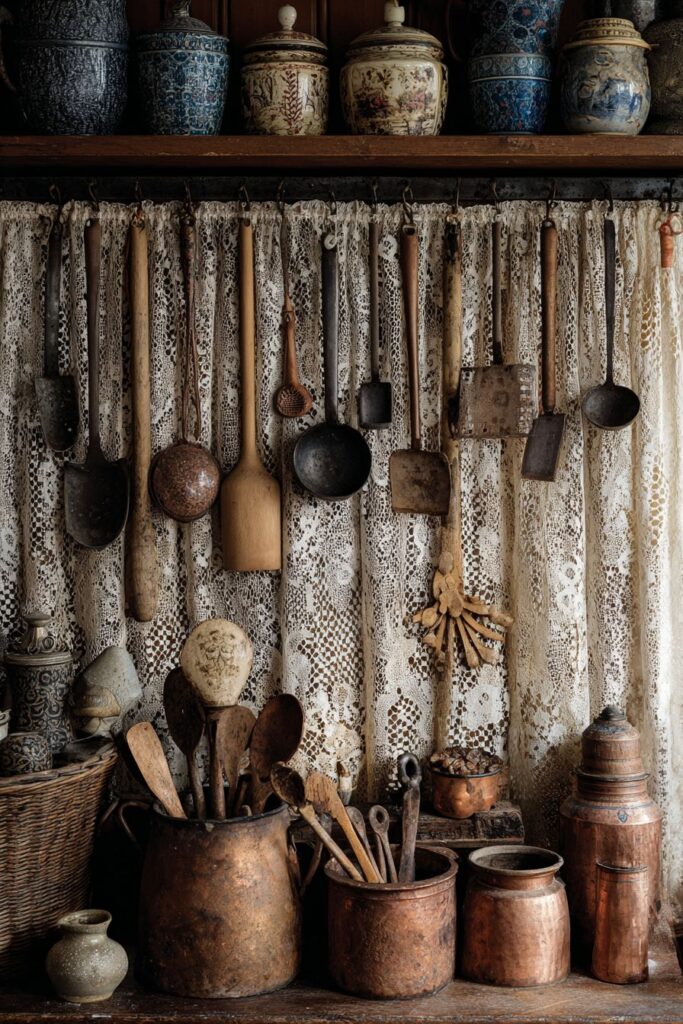
Key Design Tips:
- Embrace the natural aging process and patina development as essential elements of authentic French country style
- Mix different metals and ceramics to create visual richness while maintaining warm color harmony
- Position collections near windows to take advantage of natural lighting changes throughout the day
- Include both highly polished and well-worn pieces to create intriguing contrast and depth
- Allow for casual, slightly irregular arrangements that suggest daily use rather than museum display
7. Industrial Loft Aesthetic
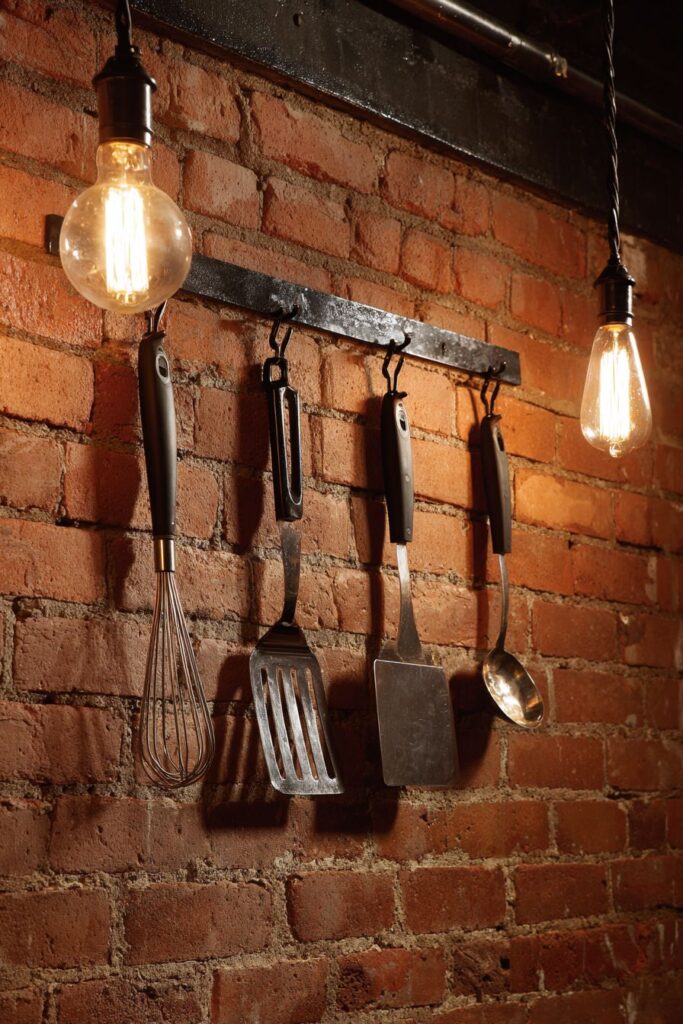
The raw honesty of industrial design philosophy transforms exposed brick walls and utilitarian fixtures into sophisticated backdrops for serious cooking tools, creating kitchen environments that celebrate function over ornamentation while maintaining undeniable aesthetic appeal. Black iron hooks and magnetic strips mounted against weathered brick surfaces provide sturdy support for commercial-grade implements while contributing to the overall industrial narrative. This approach recognizes that professional-quality tools possess inherent beauty that requires no additional decoration or concealment.
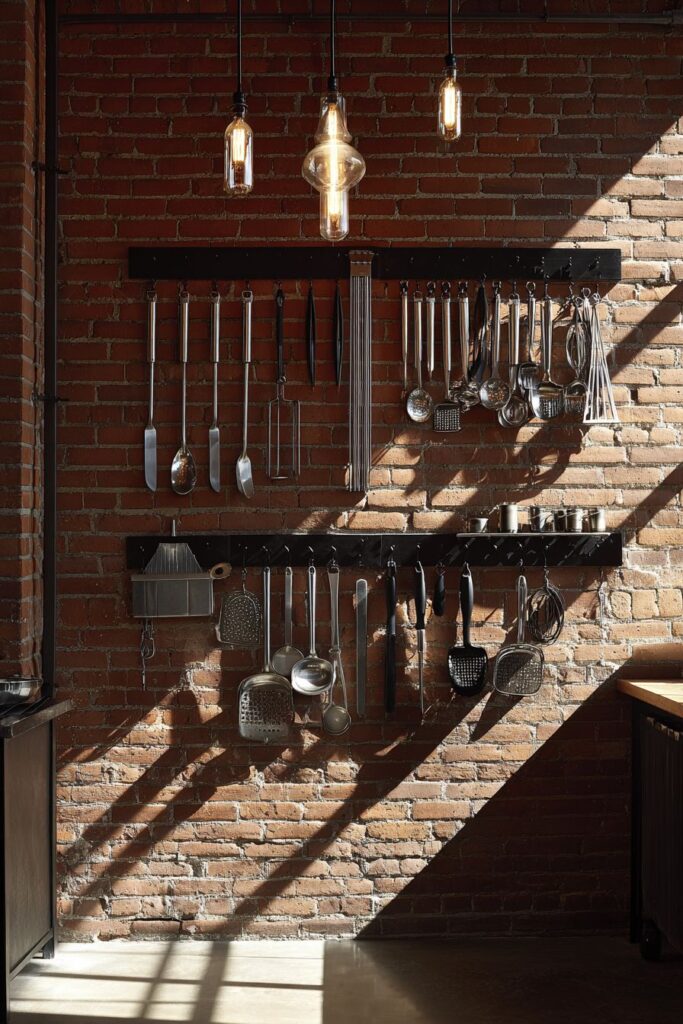
Commercial-grade stainless steel tools with heavy-duty rubber grip handles demonstrate the marriage of form and function that defines successful industrial design. These implements, designed for demanding professional environments, bring restaurant-quality performance to home kitchens while contributing to the authentic industrial atmosphere. Professional chef implements showcase the serious culinary intentions of the space, elevating home cooking to professional standards through superior tool selection and presentation.
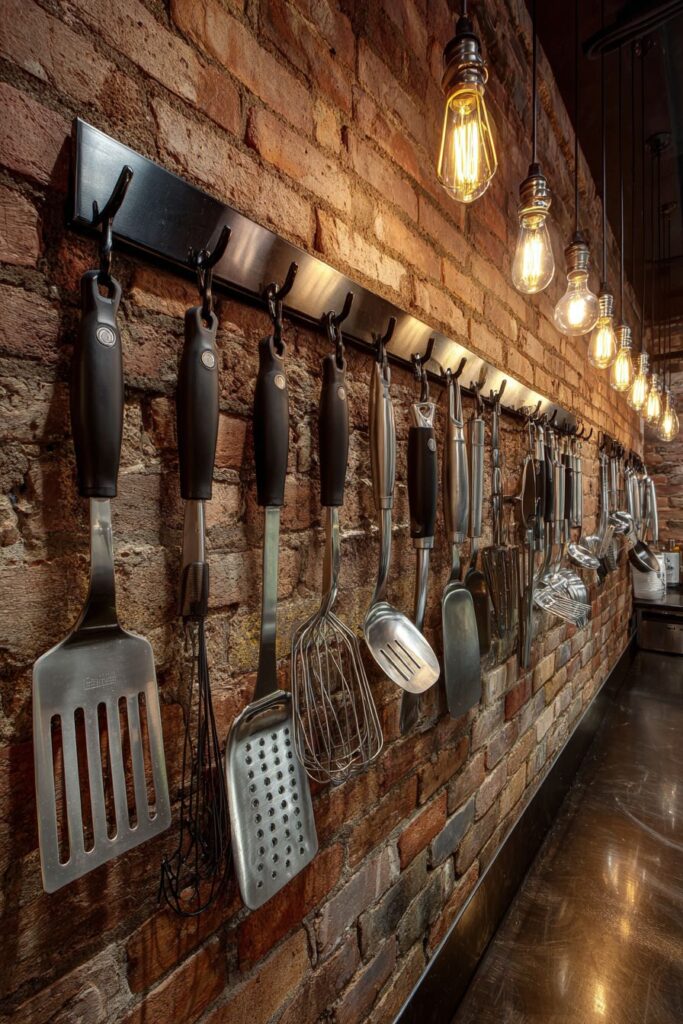
Edison bulb pendant lighting creates dramatic shadows and highlights across raw textures, emphasizing the three-dimensional qualities of both tools and architectural elements. This lighting choice pays homage to the industrial heritage while providing the warm illumination necessary for comfortable living spaces. The interplay between harsh architectural elements and warm lighting creates the perfect balance between industrial authenticity and residential comfort.
The urban loft aesthetic embraces imperfection and celebrates the honest expression of structural elements, creating environments that feel authentic rather than contrived. Functional design elements take precedence over purely decorative considerations, resulting in spaces that work as hard as they look while maintaining the sophisticated edge that defines contemporary urban living.
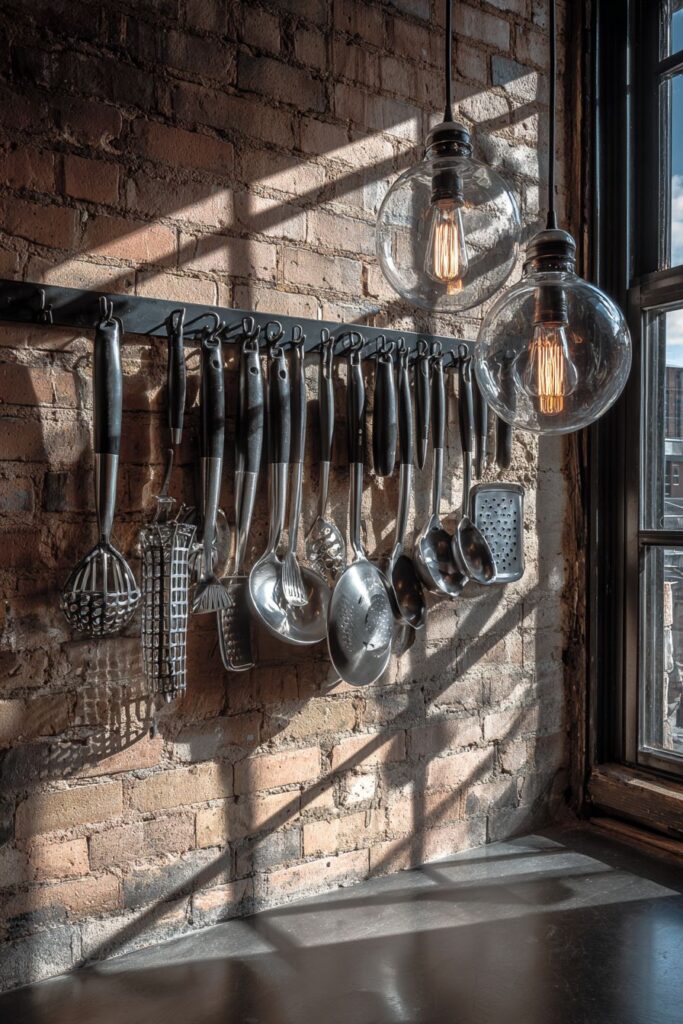
Key Design Tips:
- Choose mounting hardware that can handle the weight and stress of heavy professional tools
- Embrace the natural variations and imperfections in brick and metal surfaces as part of the aesthetic
- Position tools for maximum accessibility during cooking while maintaining visual balance across the wall
- Use warm lighting to soften harsh industrial elements and create comfortable living environments
- Select tools based on professional quality and performance rather than purely decorative considerations
8. Coastal Weathered Rope Handles
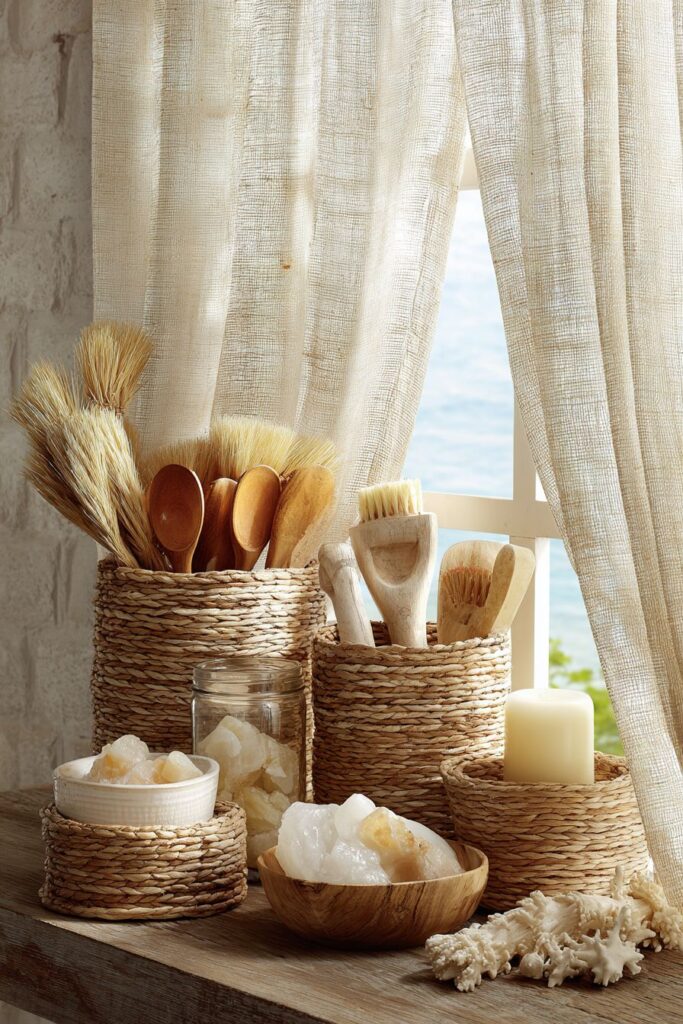
The serene beauty of coastal living finds perfect expression in kitchen utensils that celebrate natural materials and weathered textures, creating culinary environments that evoke the peace and simplicity of seaside life. Weathered rope handles and driftwood accents bring the organic irregularity of natural materials indoors, while woven seagrass baskets provide storage solutions that maintain the casual elegance essential to successful coastal design. This approach recognizes that the best coastal kitchens feel like natural extensions of their seaside environments rather than artificial recreations.
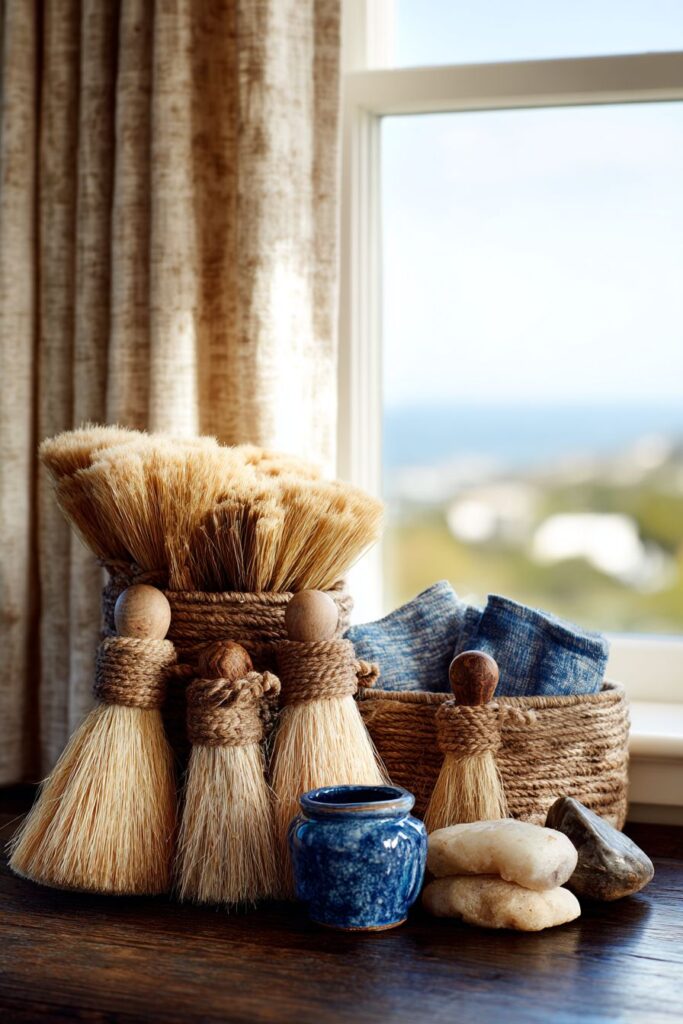
Natural bristle brushes showcase the traditional materials that coastal communities have relied upon for generations, their honest functionality and organic appearance fitting seamlessly into the overall design narrative. Carved wooden serving pieces demonstrate the hand-crafted quality that defines authentic coastal style, their smooth surfaces and gentle curves reflecting the patient work of traditional artisans. Sea glass-colored ceramic tools provide gentle color variation that echoes the palette of coastal environments without overwhelming the natural material foundation.
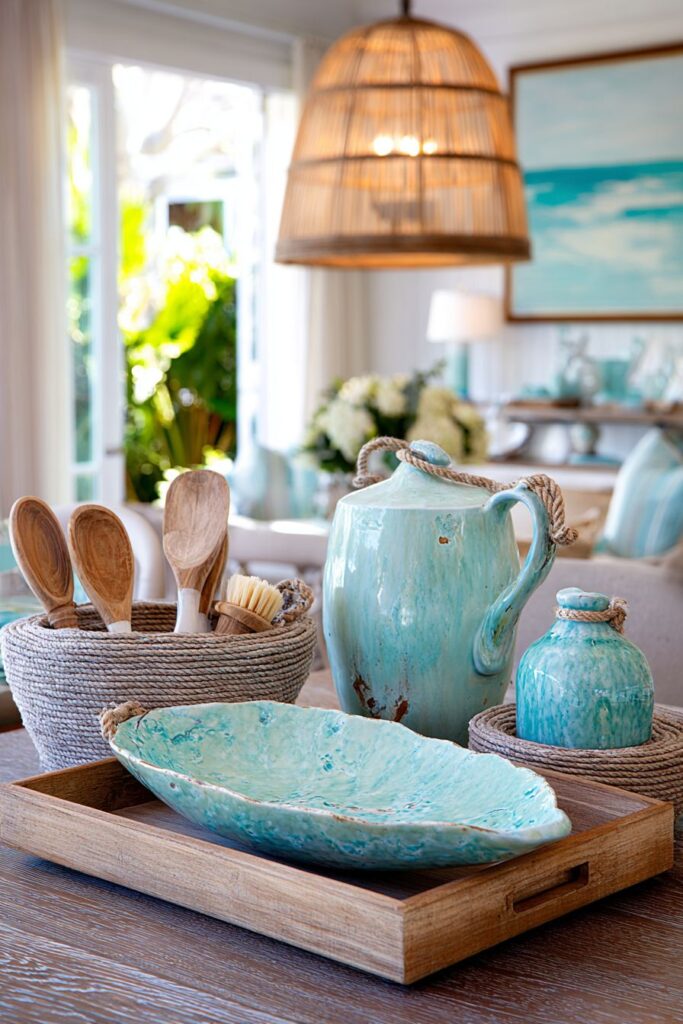
Soft ocean-inspired lighting mimics the quality of natural seaside ambiance, filtering through sheer linen curtains to create the diffused illumination that flatters natural materials while maintaining the relaxed atmosphere essential to coastal living. This lighting approach changes subtly throughout the day, creating the dynamic quality of natural light reflected from water surfaces. The gentle shadows and highlights that result from this lighting strategy emphasize texture and organic form rather than sharp geometric lines.
Organic textures play a central role in successful coastal design, providing visual and tactile interest while maintaining the connection to natural environments that defines the style. Beach-house functionality demands that tools perform reliably in humid, salt-laden environments while maintaining their aesthetic appeal over time.
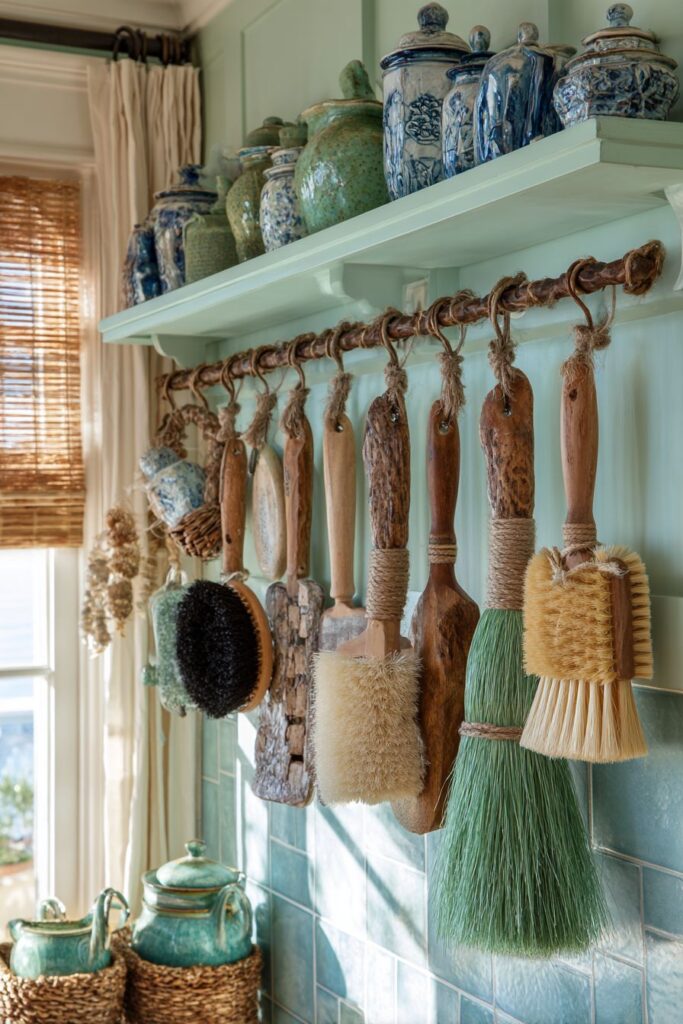
Key Design Tips:
- Choose materials that age gracefully in humid coastal environments and develop attractive patina over time
- Embrace natural color variations and organic irregularities as essential elements of authentic coastal style
- Position storage baskets and containers to allow air circulation and prevent moisture accumulation
- Include a mix of textures from smooth weathered wood to rough woven fibers for visual interest
- Select tools that function reliably in high-humidity environments while maintaining coastal aesthetic appeal
9. Luxury Marble and Brass Carousel
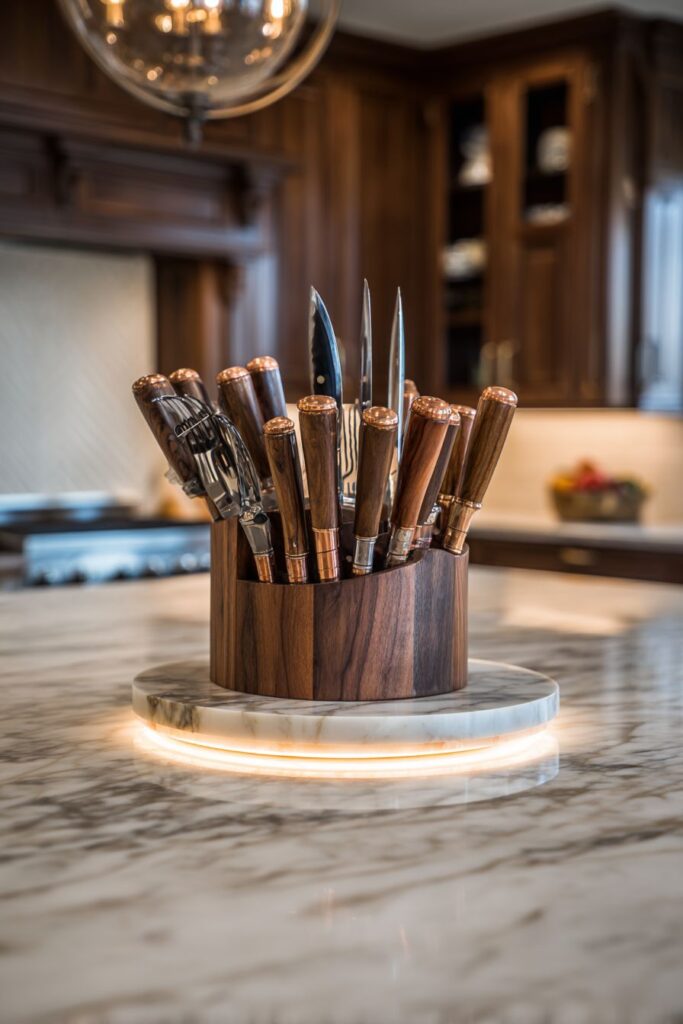
The pinnacle of kitchen luxury finds expression in sophisticated storage solutions that rival fine jewelry displays in their attention to material quality and presentation aesthetics. A marble and brass rotating carousel organizer transforms kitchen utensil storage into a ceremonial experience, celebrating the rituals of serious cooking through the presentation of premium tools. This approach recognizes that superior ingredients and techniques deserve equally superior implements, creating environments where every aspect of the culinary process receives appropriate reverence and attention.
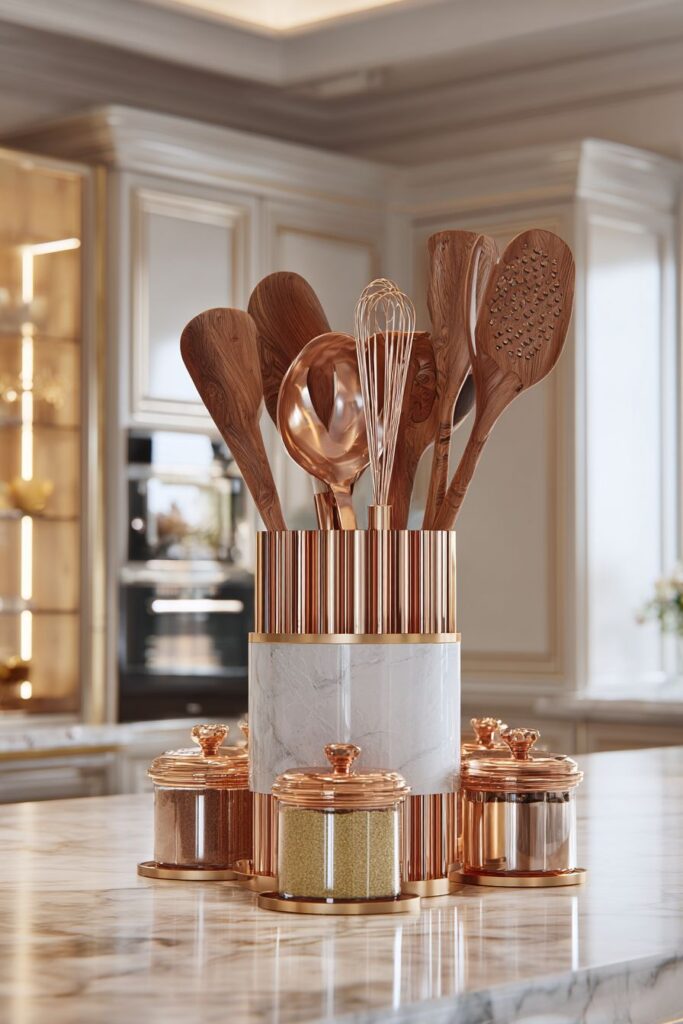
Italian olive wood handles showcase the natural beauty and superior performance characteristics that result from traditional craftsmanship and premium materials. The distinctive grain patterns and warm golden tones of properly aged olive wood provide both visual appeal and exceptional durability, improving with age and use rather than deteriorating. German stainless steel blades represent the pinnacle of metallurgical achievement, maintaining razor-sharp edges while resisting corrosion and staining that would compromise lesser materials.
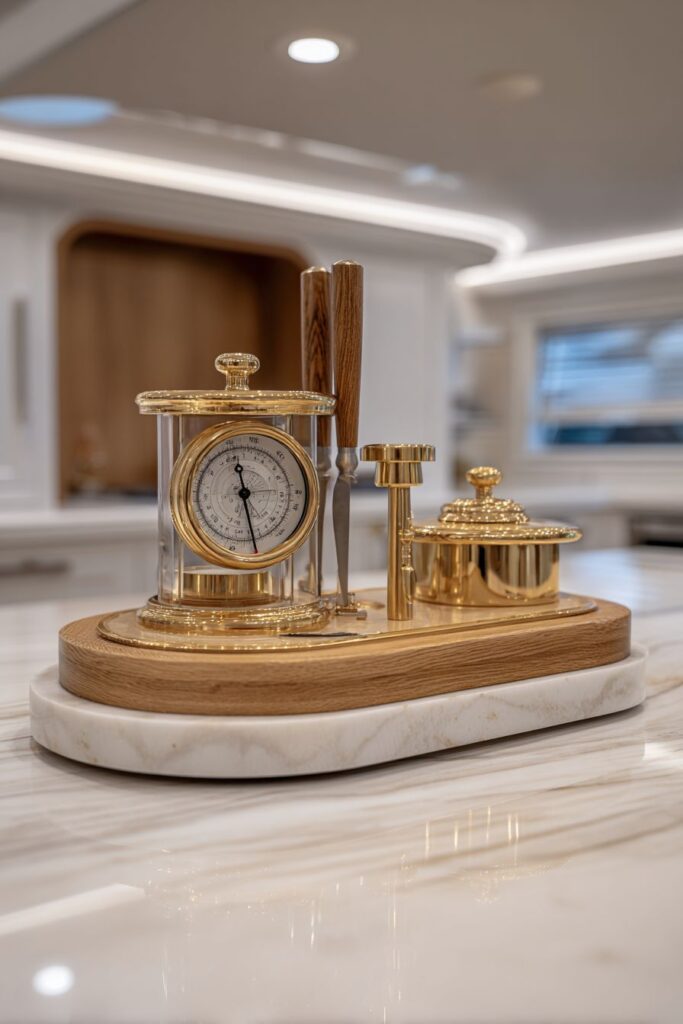
French copper finishing on measuring tools demonstrates the marriage of functional excellence with aesthetic sophistication that defines luxury kitchen design. The natural antimicrobial properties of copper, combined with its superior heat conductivity, make it the preferred choice of serious cooks while its warm reddish tones add richness and depth to the overall tool collection. The rotating carousel system ensures that every tool remains easily accessible while providing museum-quality display capabilities.
Recessed lighting creates elegant highlights across polished surfaces, emphasizing the quality of materials and craftsmanship while maintaining the sophisticated atmosphere essential to luxury kitchen environments. This lighting strategy showcases the tools as objects of beauty worthy of admiration while ensuring practical visibility during use. Sophisticated organization principles maintain practical accessibility without compromising the elevated aesthetic that defines luxury design.
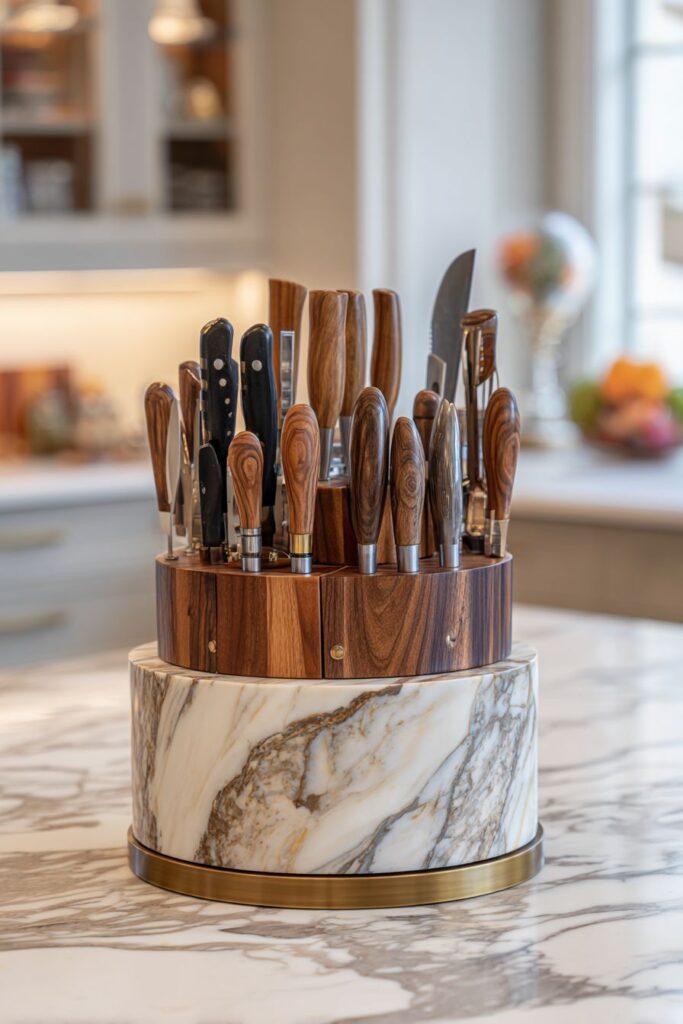
Key Design Tips:
- Invest in tools that combine superior performance with exceptional aesthetic appeal and longevity
- Position carousel systems for easy rotation while maintaining stability during tool selection and replacement
- Choose lighting that enhances material qualities without creating harsh glare on polished surfaces
- Maintain consistent material quality standards across all tools to preserve the luxury aesthetic
- Consider the weight and balance of rotating elements to ensure smooth operation over time
10. Japanese Zen Bamboo Blocks
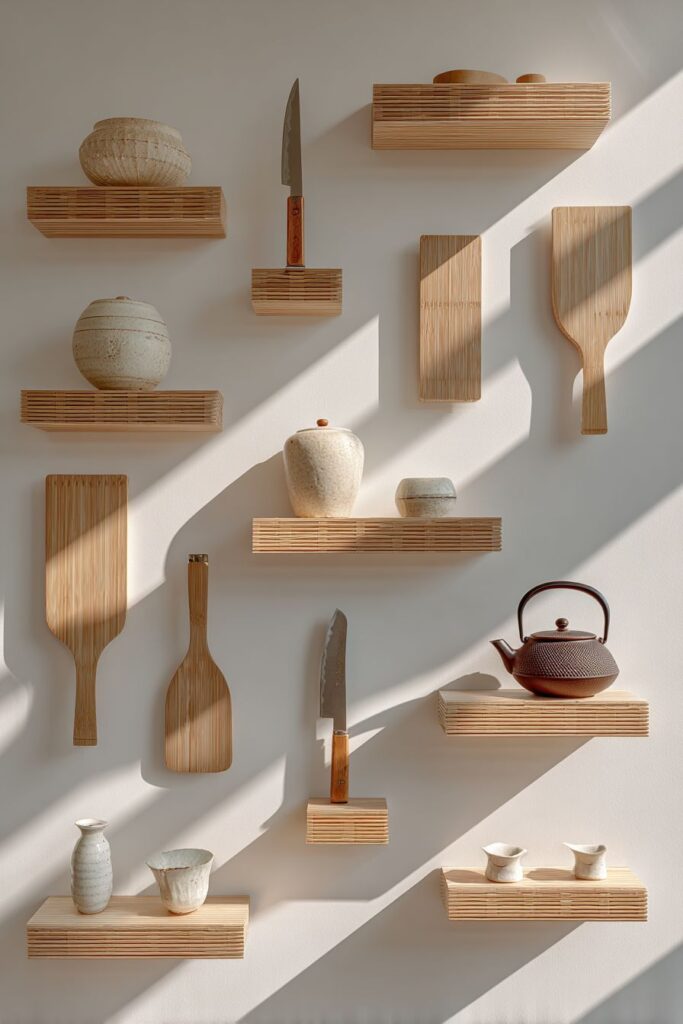
The profound simplicity of Japanese design philosophy transforms kitchen utensil storage into a meditation on the beauty of essential forms and the wisdom of purposeful reduction. Minimalist bamboo magnetic blocks arranged with zen-like precision create storage solutions that transcend mere functionality to become expressions of philosophical principles applied to daily life. This approach recognizes that the most profound beauty emerges from the careful elimination of unnecessary elements rather than the addition of decorative flourishes.
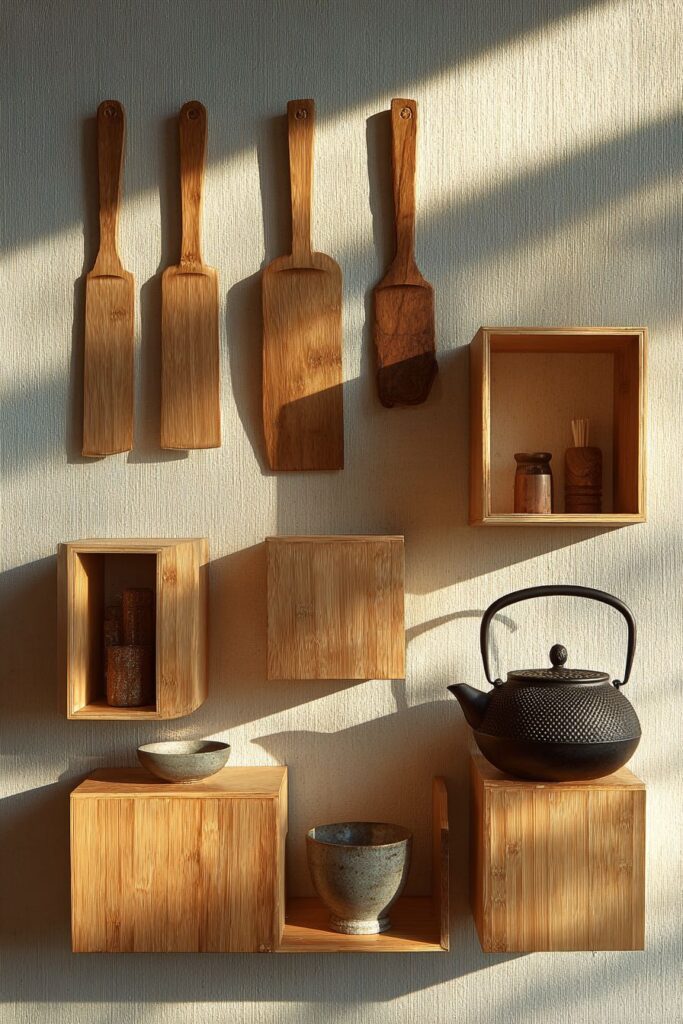
Traditional wooden rice paddles represent the deep connection between tool design and cultural food traditions, their specific shapes and proportions evolved through generations of use to achieve perfect functionality for their intended purposes. Ceramic-handled knives demonstrate the Japanese mastery of combining different materials to create superior performance while maintaining aesthetic harmony. Handcrafted iron tea utensils showcase the metalworking traditions that have elevated utilitarian objects to the level of fine art through patient attention to detail and proportion.
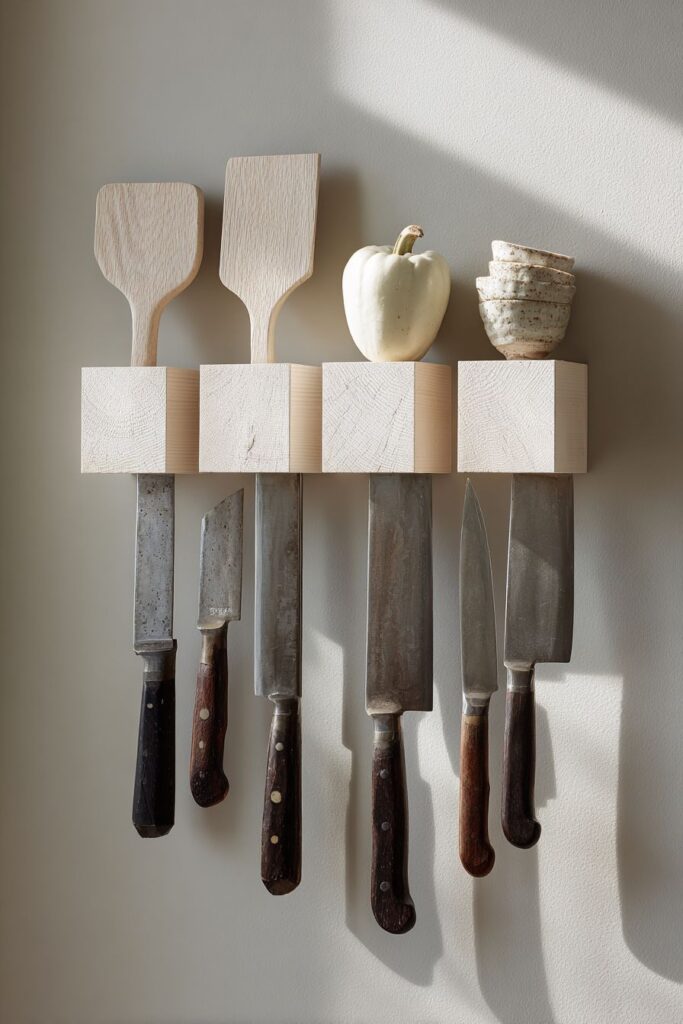
Soft natural lighting creates subtle shadows that emphasize clean lines and organic materials while maintaining the serene atmosphere essential to Japanese-inspired design. This lighting approach avoids harsh contrasts or dramatic effects in favor of gentle illumination that flatters natural textures and promotes contemplative calm. The interplay between light and shadow across simple geometric forms creates visual interest through subtlety rather than boldness.
The magnetic block system provides secure storage while maintaining the uncluttered appearance that defines successful minimalist design. Zen-like precision in arrangement reflects the Japanese principle that every object should have its proper place and that visual harmony emerges from thoughtful consideration of relationships between elements. Cultural elements connect contemporary kitchen design to timeless traditions while maintaining relevance for modern cooking needs.
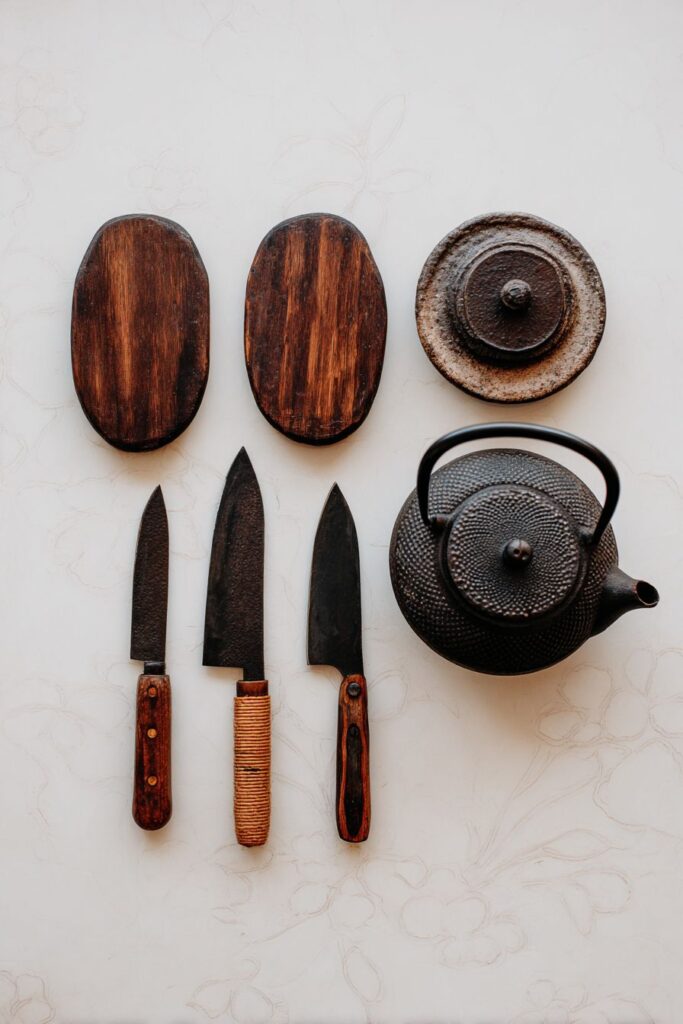
Key Design Tips:
- Arrange tools with careful attention to visual balance and spacing between elements
- Choose implements that serve essential functions without duplication or unnecessary complexity
- Position magnetic blocks to create pleasing geometric relationships while maintaining practical accessibility
- Embrace the natural aging and patina development that adds character to traditional materials
- Maintain consistent material quality and aesthetic standards across all tools in the collection
11. Rustic Cabin Log Holders
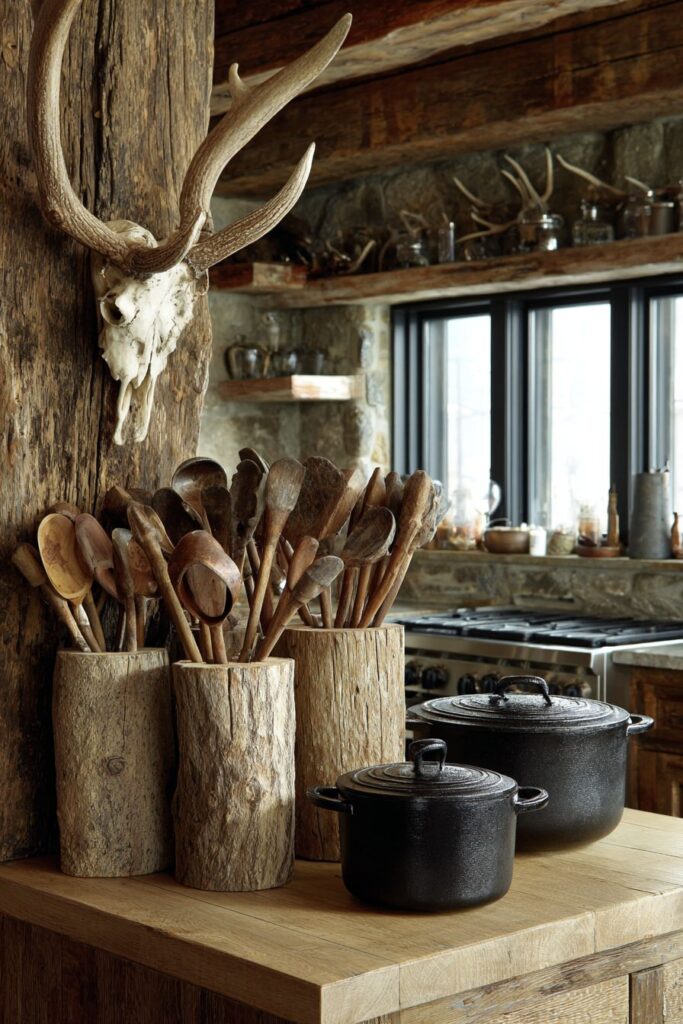
The authentic charm of wilderness living finds perfect expression in kitchen utensil storage that celebrates traditional craftsmanship and natural materials, creating culinary environments that feel like natural extensions of forest settings. Hand-hewn log holders showcase the irregular beauty of traditional woodworking techniques, their honest tool marks and natural variations telling stories of patient craftsmanship and respect for natural materials. Antler-mounted displays provide unique storage solutions that celebrate the hunting and gathering traditions that sustained woodland communities for generations.
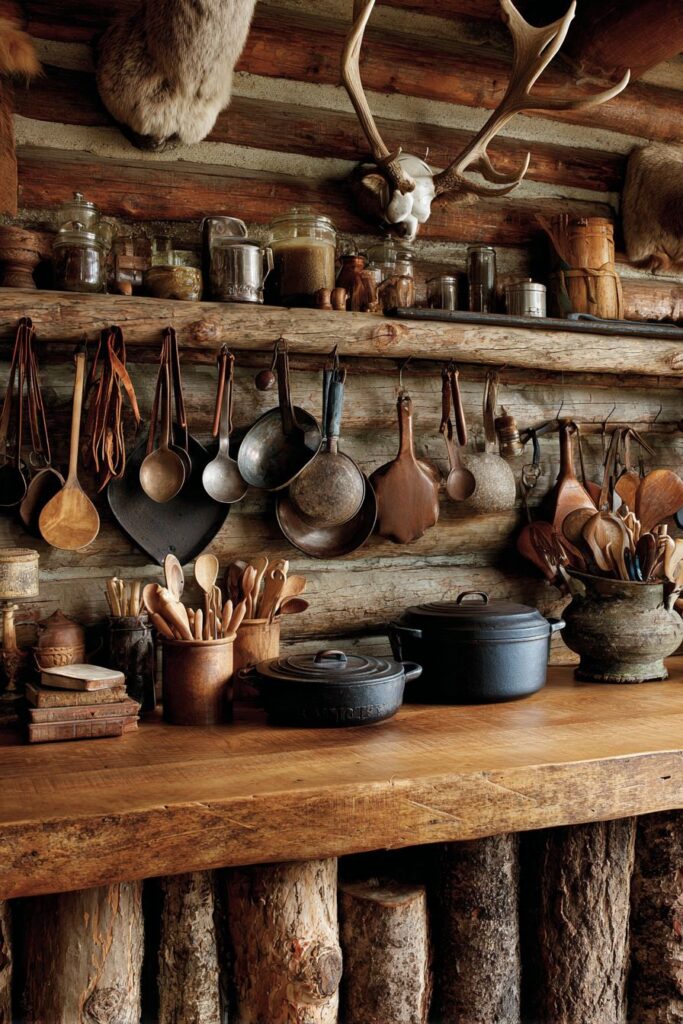
Carved horn spoons represent the ultimate expression of sustainable design, transforming natural materials that might otherwise be discarded into functional art objects that improve with age and use. Cast iron Dutch oven tools demonstrate the substantial construction and superior performance characteristics necessary for serious outdoor cooking while maintaining the authentic appearance that defines wilderness style. Leather-wrapped handles with natural patina provide comfortable grips while contributing to the overall narrative of traditional materials and time-honored construction techniques.

Warm firelight and natural daylight combine to create the authentic atmosphere that defines successful cabin design, highlighting the rich textures and natural variations that make handcrafted objects so appealing. This lighting approach changes dramatically throughout the day and seasons, creating dynamic displays that maintain visual interest while celebrating the connection to natural rhythms. The interplay between artificial and natural light sources mirrors the dual nature of cabin life, balancing comfort with authenticity.
Authentic wilderness textures provide visual and tactile richness that cannot be replicated through artificial means, connecting contemporary cooks to the food traditions that sustained earlier generations in challenging environments. Handcrafted functionality ensures that tools perform reliably while maintaining the aesthetic appeal that makes them worthy of display rather than concealment.
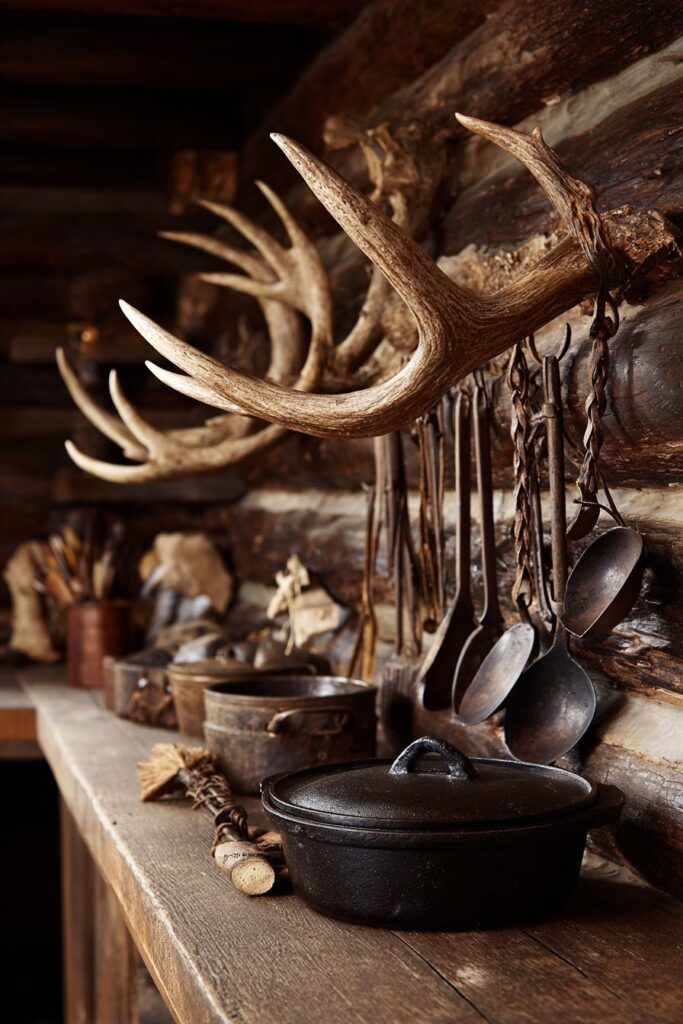
Key Design Tips:
- Embrace natural variations in wood grain, antler shape, and leather patina as essential design elements
- Choose mounting locations that can support the substantial weight of traditional materials and construction
- Position displays near both artificial and natural light sources to create dynamic illumination throughout the day
- Include tools that function reliably for both indoor and outdoor cooking applications
- Allow natural aging processes to enhance rather than diminish the overall aesthetic appeal
12. Mid-Century Teak and Brass Geometry
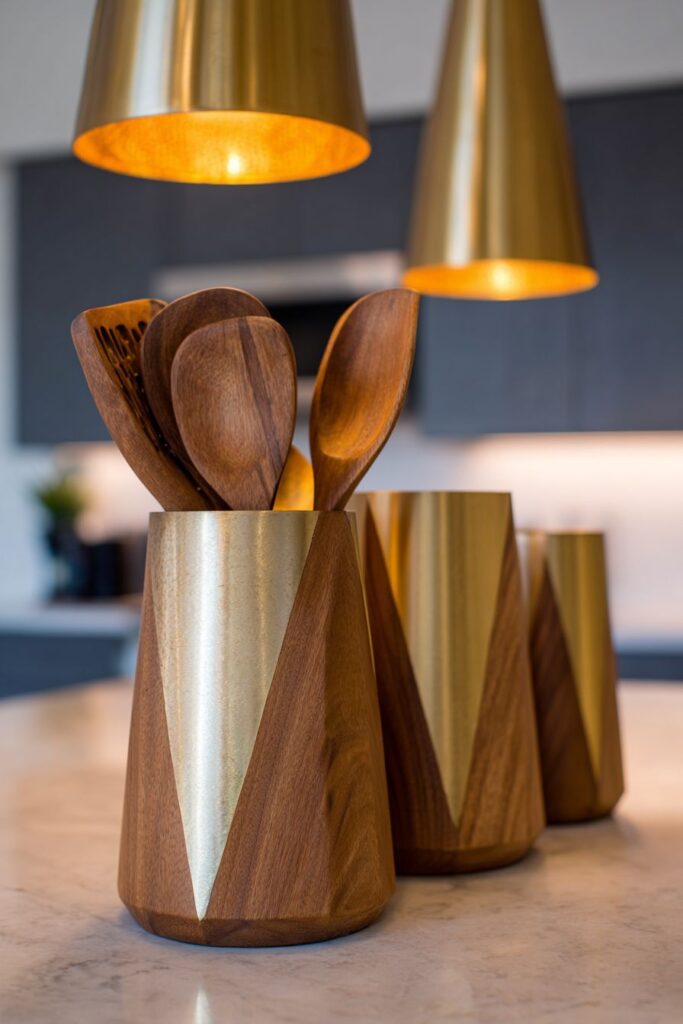
The sophisticated restraint of mid-century modern design philosophy creates kitchen utensil storage that celebrates geometric precision while maintaining the warm organic elements that prevent sterile appearances. Teak and brass organizational systems with clean geometric patterns demonstrate the era’s commitment to functional beauty and the belief that everyday objects should reflect thoughtful design principles. This approach recognizes that superior design transcends temporary trends to create timeless environments that remain relevant across decades.
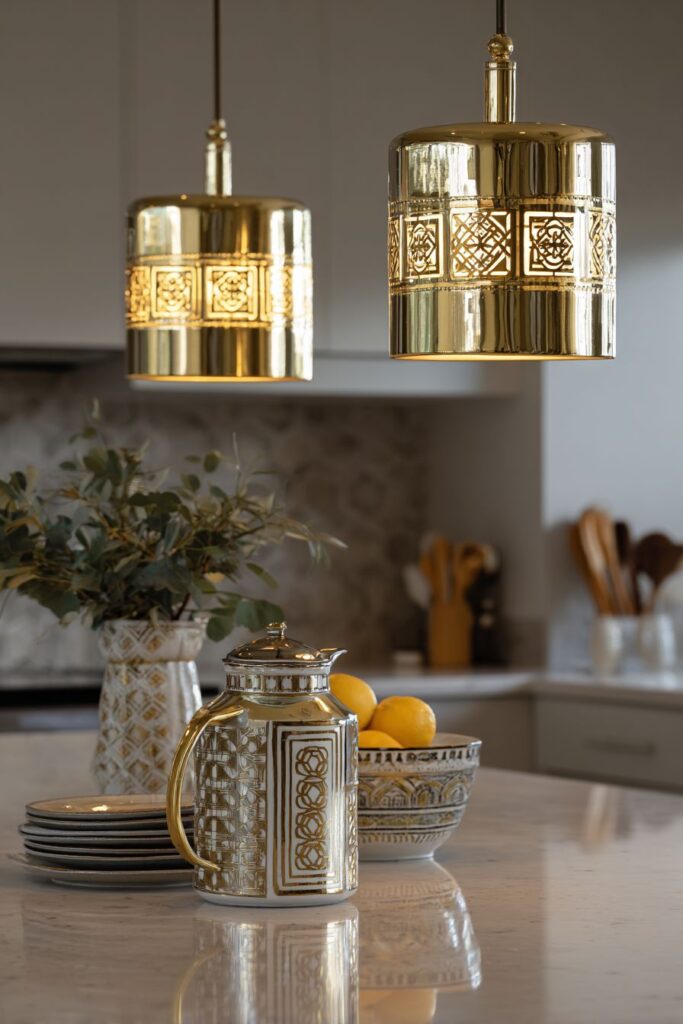
Scandinavian wood-handled tools showcase the period’s embrace of natural materials combined with industrial production techniques to create objects that were both affordable and beautiful. Atomic-era serving pieces reflect the optimistic spirit of their time while maintaining the functional excellence that made them worthy of preservation and continued use. Period-appropriate ceramic implements in distinctive glazes and forms provide color and texture variation while maintaining the cohesive aesthetic that defines successful mid-century collections.
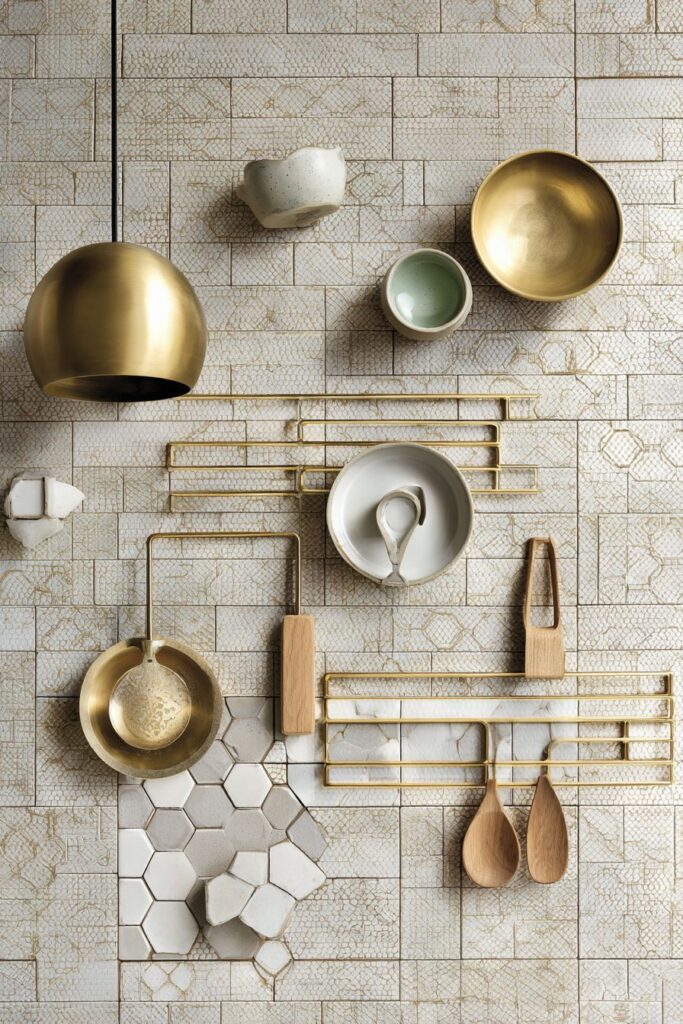
Soft pendant lighting with brass accents creates warm reflections across authentic materials while maintaining the sophisticated atmosphere that defines mid-century modern interiors. This lighting strategy emphasizes the geometric patterns and clean lines that characterize the style while providing the warm illumination necessary for comfortable living environments. The interplay between brass fixtures and brass organizational elements creates visual continuity that unifies the overall design.
The geometric organization systems reflect the period’s fascination with mathematical relationships and proportional harmony, creating storage solutions that function as sculptural elements while maintaining complete practical functionality. Clean retro aesthetic principles demand that every element serve both functional and visual purposes, eliminating unnecessary decoration in favor of essential beauty. Functional design principles ensure that organization systems work as efficiently today as they did when originally conceived.
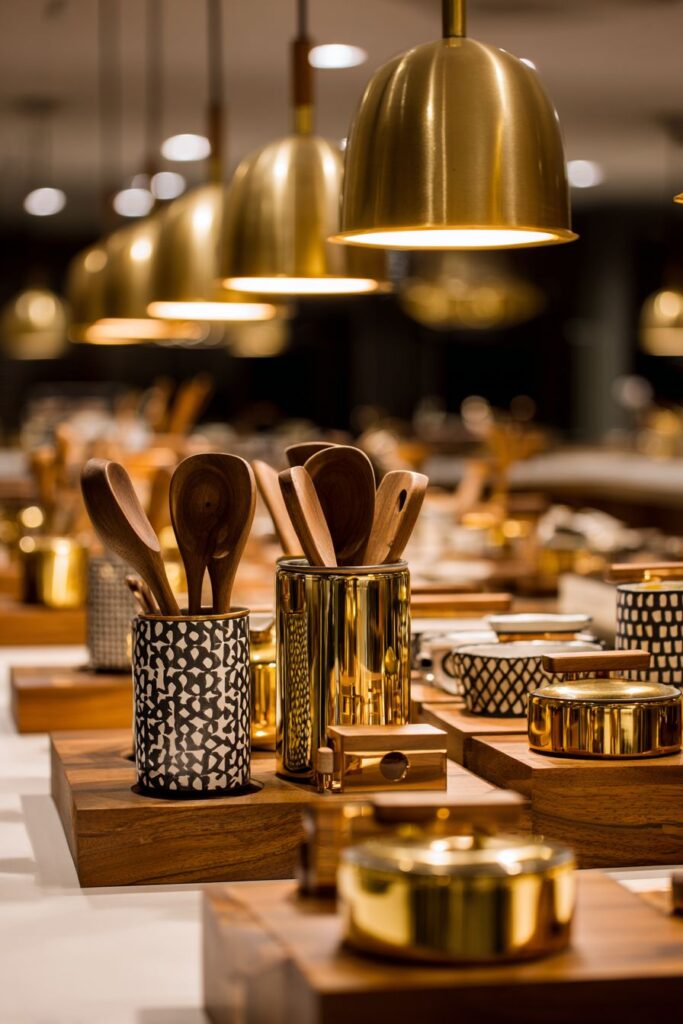
Key Design Tips:
- Maintain consistent proportional relationships between organizational elements and stored tools
- Choose authentic materials and finishes that reflect genuine mid-century manufacturing techniques and aesthetics
- Position geometric elements to create pleasing mathematical relationships and visual rhythm
- Include both restored vintage pieces and high-quality contemporary interpretations for complete collections
- Use lighting that enhances geometric patterns while maintaining the warm atmosphere essential to livable design
13. Mediterranean Artisanal Ceramics
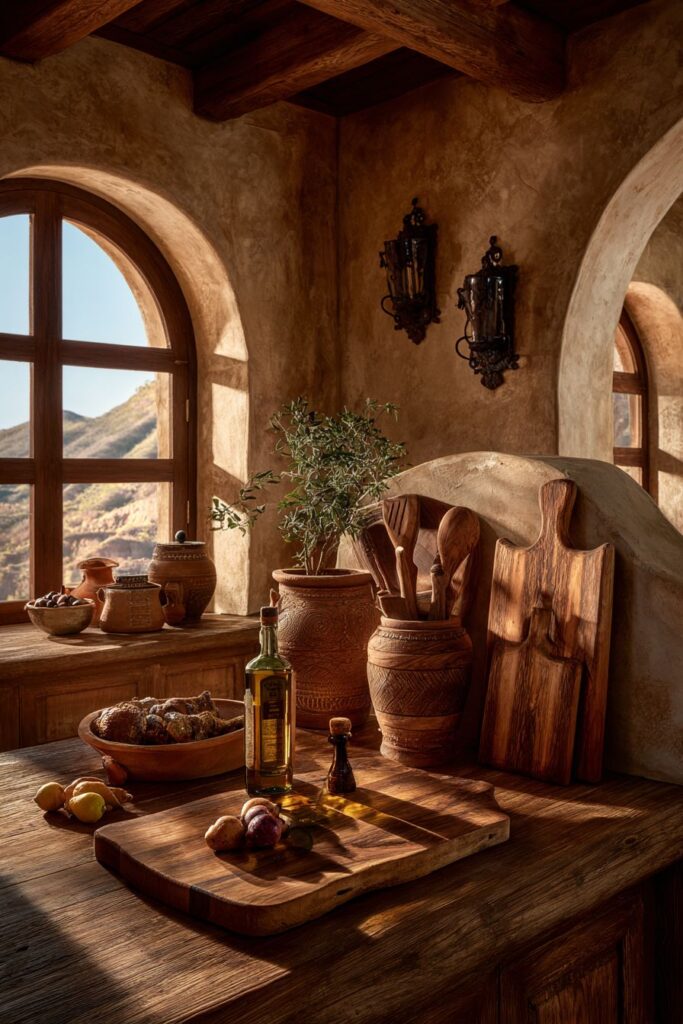
The sun-drenched warmth of Mediterranean design philosophy transforms kitchen utensil storage into celebrations of artisanal craftsmanship and regional material traditions, creating environments that evoke the relaxed elegance of coastal European villages. Hand-painted ceramic containers and wrought iron wall mounts showcase the traditional crafts that have flourished in Mediterranean regions for centuries, their irregular surfaces and vibrant glazes reflecting the human touch that makes handmade objects so appealing. This approach recognizes that the most beautiful kitchens emerge from authentic cultural expressions rather than artificial stylistic imitations.
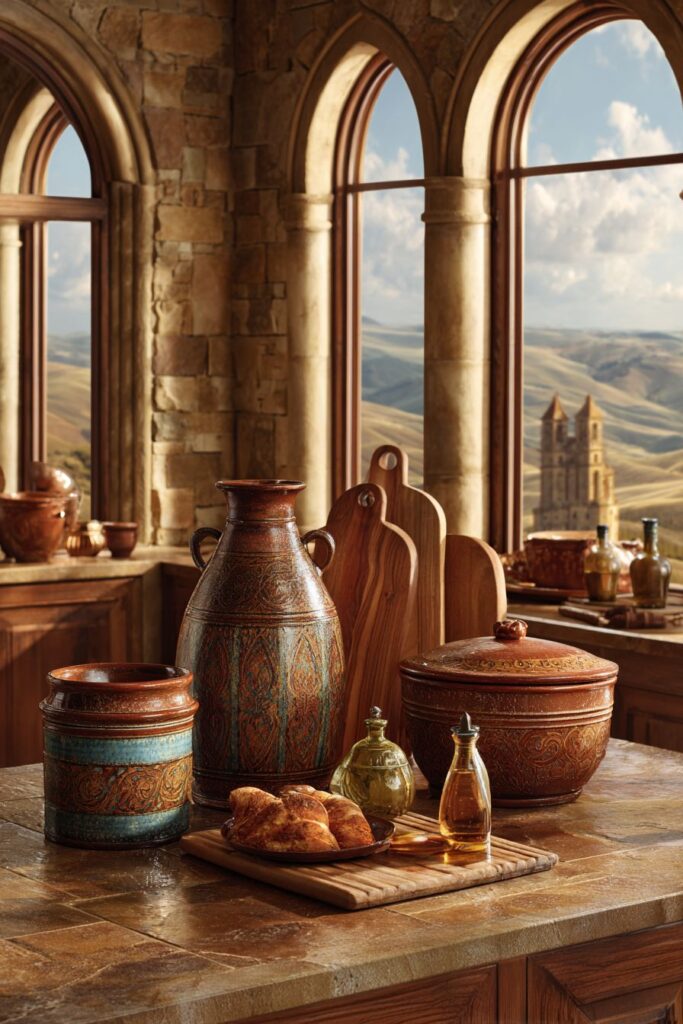
Olive wood cutting boards demonstrate the deep connection between local materials and regional food traditions, their distinctive grain patterns and natural oils making them superior choices for food preparation while contributing to the overall aesthetic narrative. Terracotta serving pieces provide the warm earth tones and organic textures that define Mediterranean style, their porous surfaces improving with age and use. Traditional brass measuring tools with oxidized patinas showcase the metalworking traditions that created objects designed to last generations while developing increasing beauty through time and use.
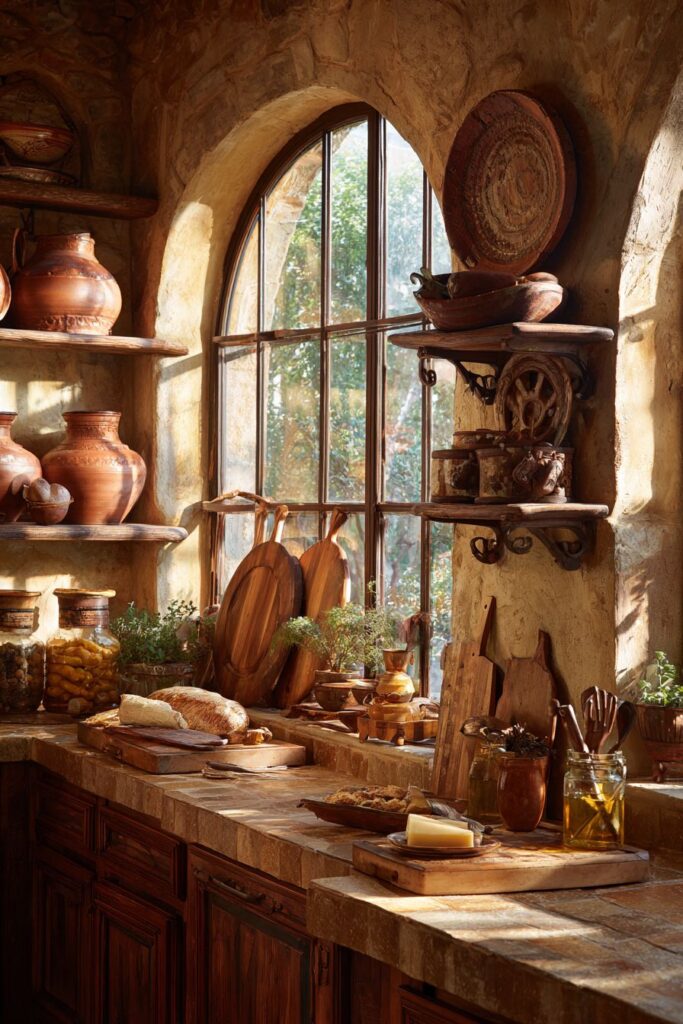
Natural sunlight through arched windows creates the warm golden tones that bring Mediterranean ceramics and metals to life, highlighting the artisanal textures and hand-applied glazes that make each piece unique. This lighting approach changes throughout the day, creating the dynamic quality that keeps handmade objects visually interesting while maintaining the connection to natural rhythms that defines Mediterranean living. The interplay between light and textured surfaces creates shadow patterns that emphasize the three-dimensional qualities of artisanal work.
Authentic European countryside charm permeates every aspect of this storage philosophy, from the selection of traditional materials to the casual arrangements that suggest tools are valued for daily use rather than mere display. Time-honored functionality ensures that traditional forms continue to serve contemporary cooking needs while maintaining the cultural connections that give Mediterranean style its distinctive character and enduring appeal.
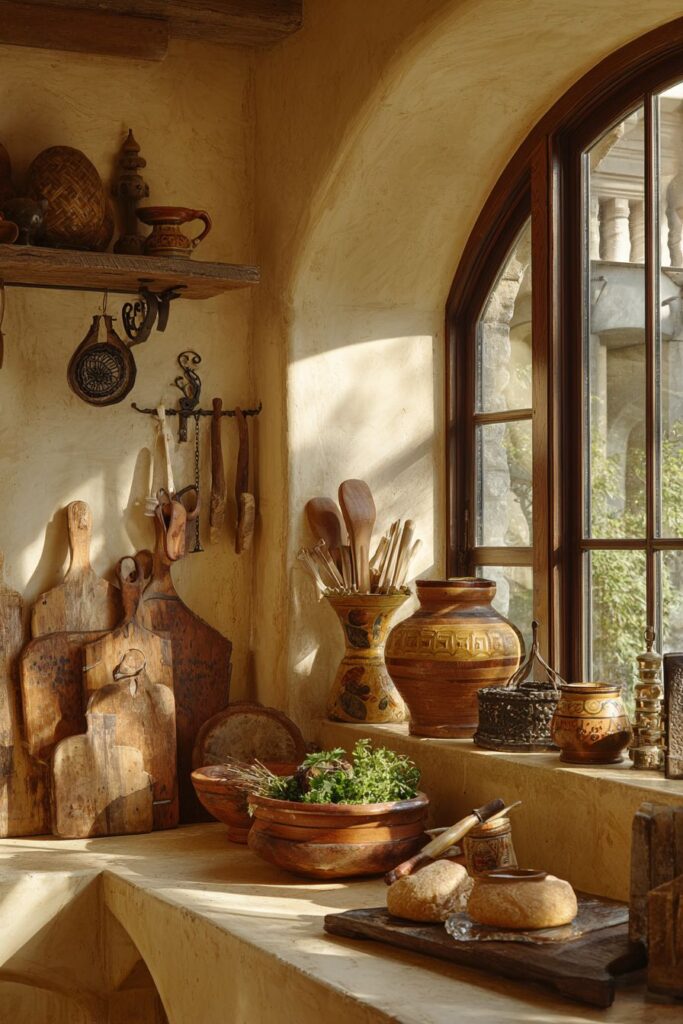
Key Design Tips:
- Choose ceramics with visible brush strokes and irregular glazes that showcase their handmade origins
- Position collections near windows to take advantage of natural light variations throughout the day
- Mix different ceramic traditions and glazing techniques to create visual richness while maintaining warm color harmony
- Include both decorative and functional pieces to create the layered complexity that defines authentic Mediterranean style
- Allow natural aging and patina development to enhance rather than compromise the overall aesthetic appeal
14. Smart Kitchen Technology Integration
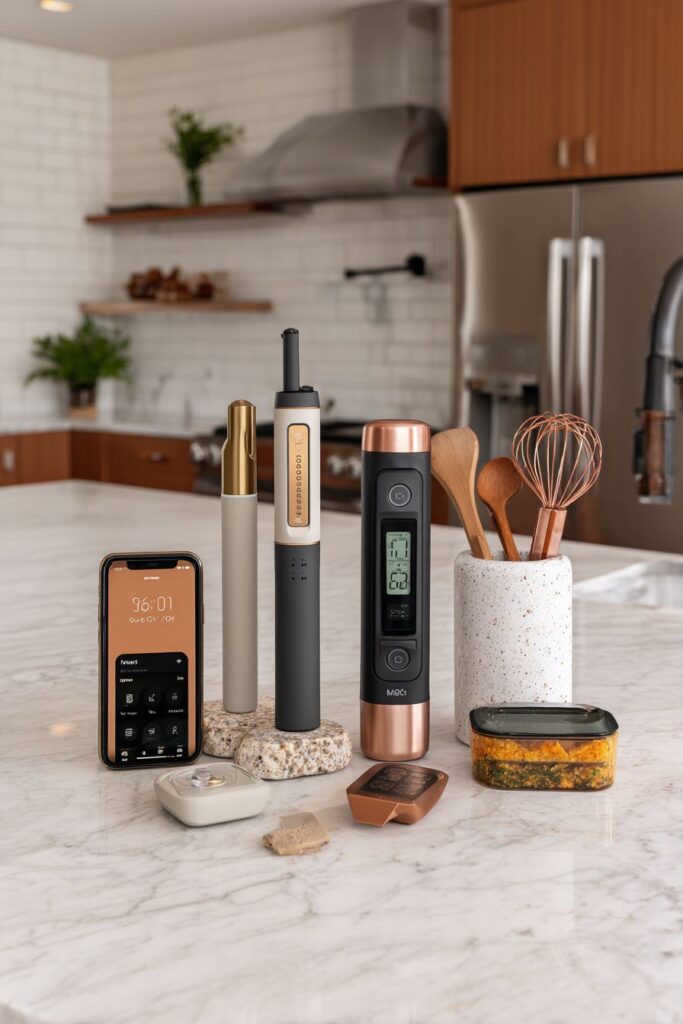
The cutting-edge intersection of culinary tradition and technological innovation creates kitchen environments that seamlessly blend time-honored cooking techniques with contemporary digital capabilities, demonstrating how thoughtful integration can enhance rather than replace fundamental cooking skills. Integrated technology displays and USB charging stations for digital tools represent the evolution of kitchen design to accommodate the devices that increasingly support serious cooking endeavors. This approach recognizes that modern culinary excellence often depends on precise temperature control, timing, and measurement that digital tools can provide.
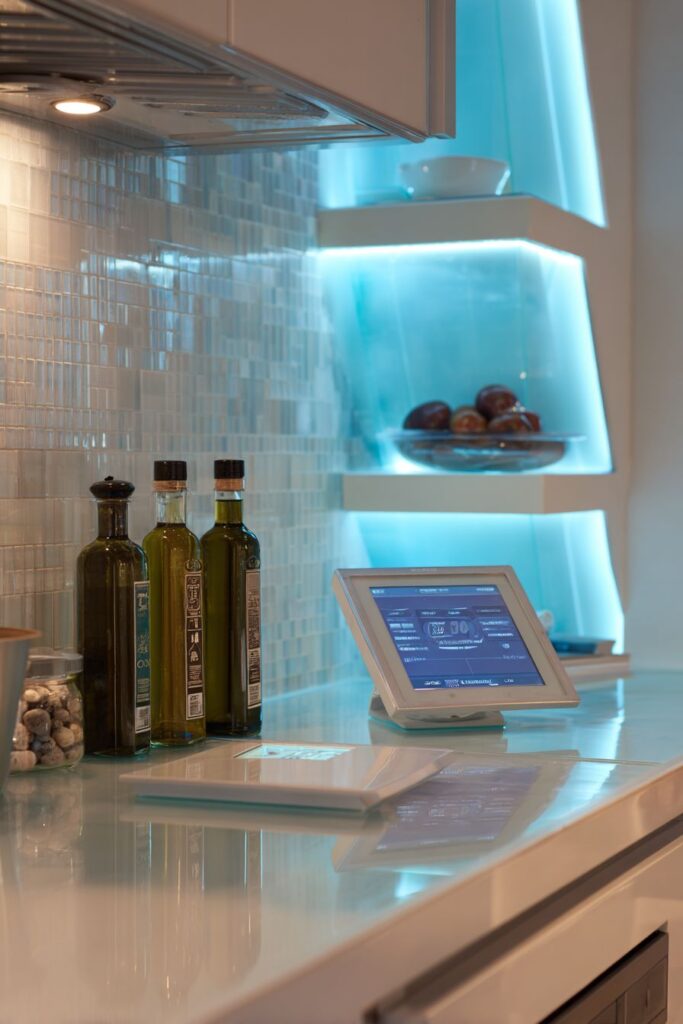
Precision digital scales demonstrate how technology can improve traditional techniques without replacing the fundamental skills that define good cooking, providing accuracy levels that support both everyday cooking and professional-quality baking. App-connected thermometers eliminate the guesswork from protein cookery while maintaining the hands-on approach that makes cooking satisfying and educational. Sleek silicone implements with clean geometric forms bridge the gap between traditional tools and contemporary materials, offering superior performance characteristics while maintaining aesthetic compatibility with high-tech environments.
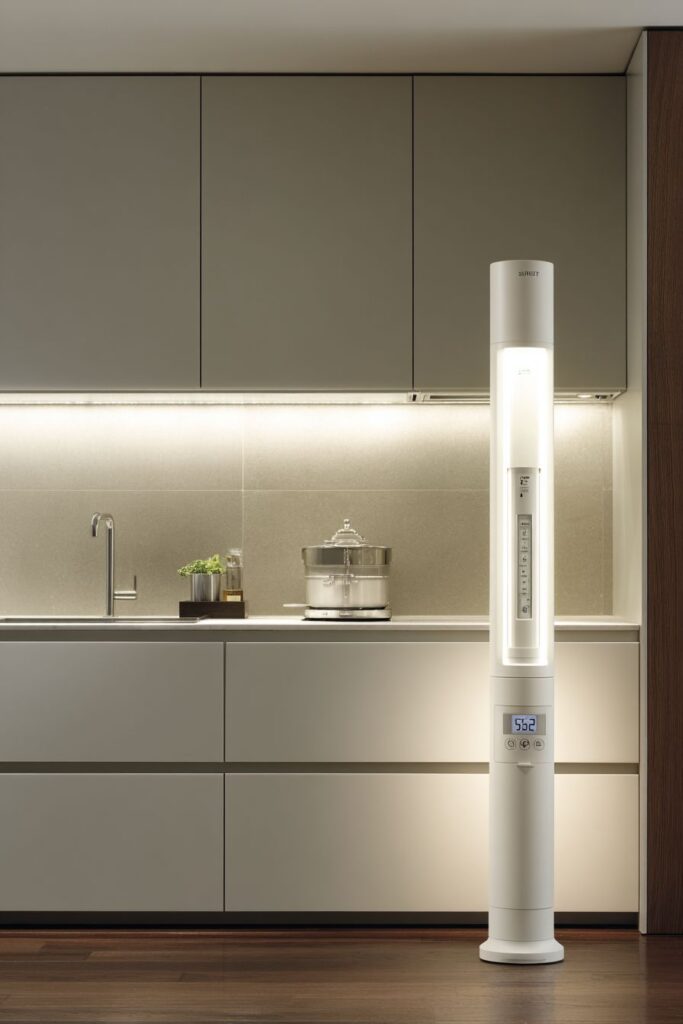
Cool LED lighting creates the futuristic ambiance that complements technological integration while providing the accurate color rendering necessary for proper food preparation and presentation. This lighting strategy supports both human visual needs and digital device displays, creating environments where traditional and technological tools work together harmoniously. The precise control capabilities of LED systems allow for customization based on specific cooking tasks and time-of-day preferences.
The integration of technology into traditional kitchen design requires careful consideration of both functional and aesthetic factors to avoid creating environments that feel more like laboratories than cooking spaces. Seamless integration principles ensure that technological elements enhance rather than dominate the overall design while maintaining the human-centered focus that makes kitchens comfortable and inviting. Traditional cooking functionality remains paramount, with technology serving as a supporting element rather than a replacement for fundamental culinary skills and intuition.
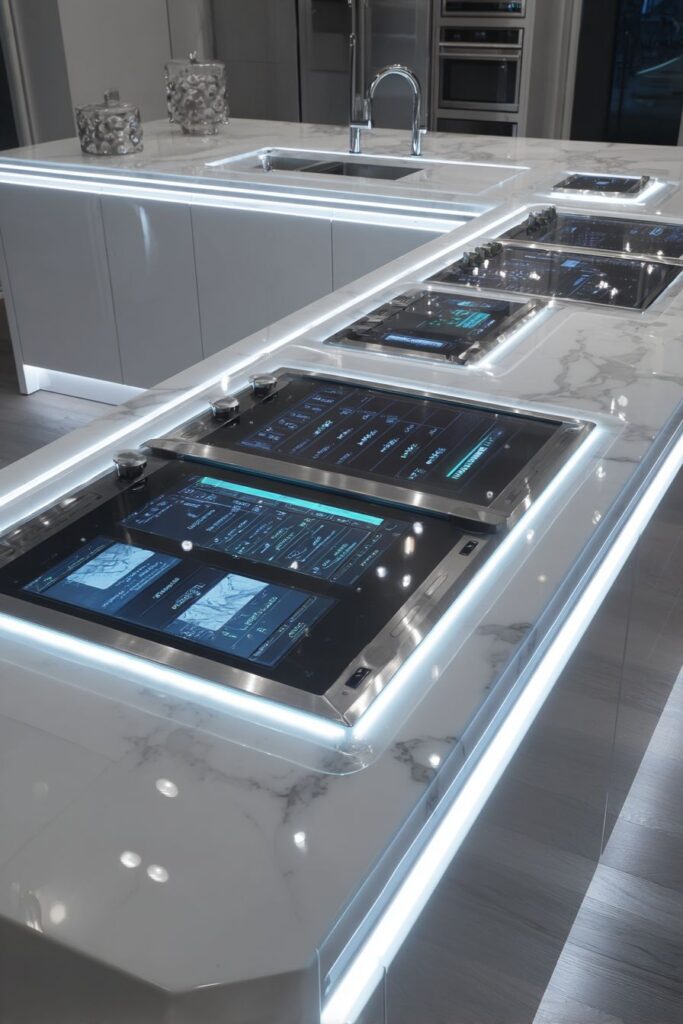
Key Design Tips:
- Position charging stations and power sources to minimize visual clutter while maintaining device accessibility
- Choose technological tools that complement rather than compete with traditional cooking methods and aesthetics
- Maintain consistent design language between digital devices and traditional tools through material and color coordination
- Include adequate lighting that supports both human vision and digital device displays
- Plan for future technological updates without requiring complete design overhauls or major renovations
15. Bohemian Macrame Hanging Systems
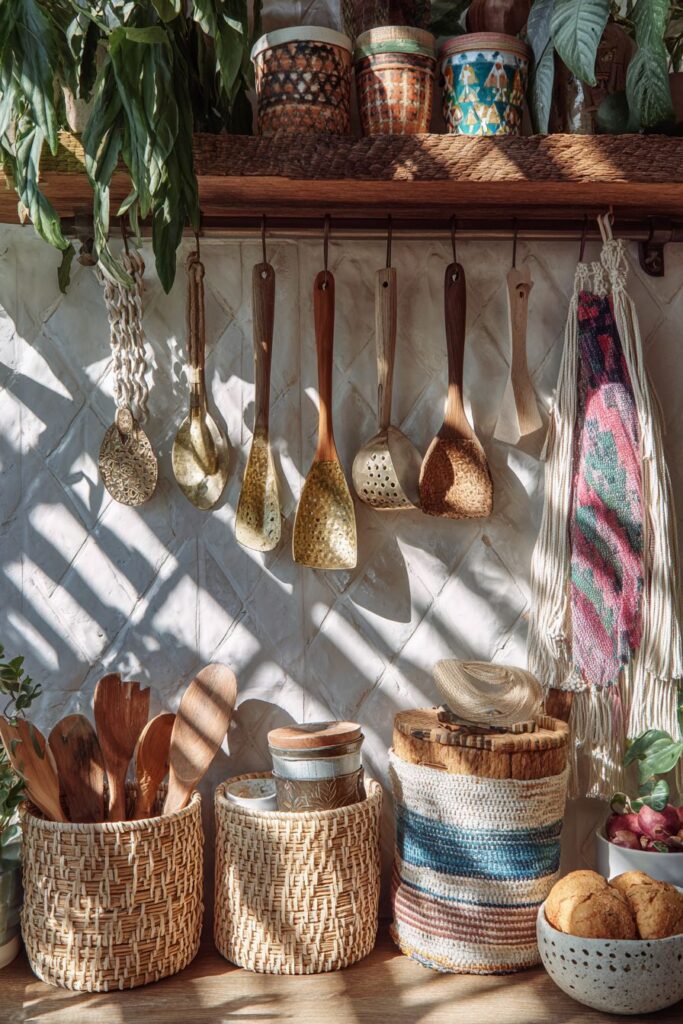
The free-spirited creativity of bohemian design philosophy transforms kitchen utensil storage into artistic expressions that celebrate handcrafted beauty and individual creativity, creating environments that feel more like artist studios than conventional cooking spaces. Macrame hanging organizers showcase the textile arts that have experienced renewed appreciation for their ability to combine function with artistic expression. Vintage woven baskets with colorful textile accents provide storage solutions that reflect global craft traditions while maintaining the eclectic spirit that defines successful bohemian interiors.
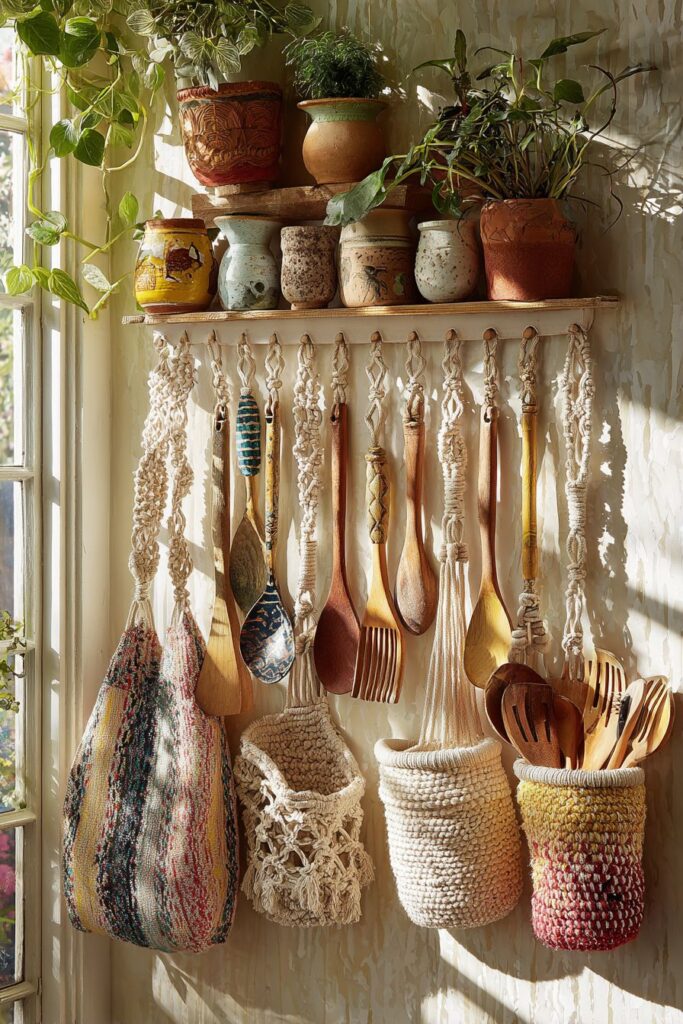
Hand-painted wooden spoons demonstrate the bohemian commitment to unique, one-of-a-kind objects that reflect individual creativity and artistic vision rather than mass-produced uniformity. Brass serving pieces with intricate patterns showcase the metalworking traditions from around the world that contribute to the global aesthetic that defines bohemian style. Ceramic tools in earth-tone glazes provide color and texture variation while maintaining the natural material connections that ground bohemian design in organic rather than artificial sources of inspiration.
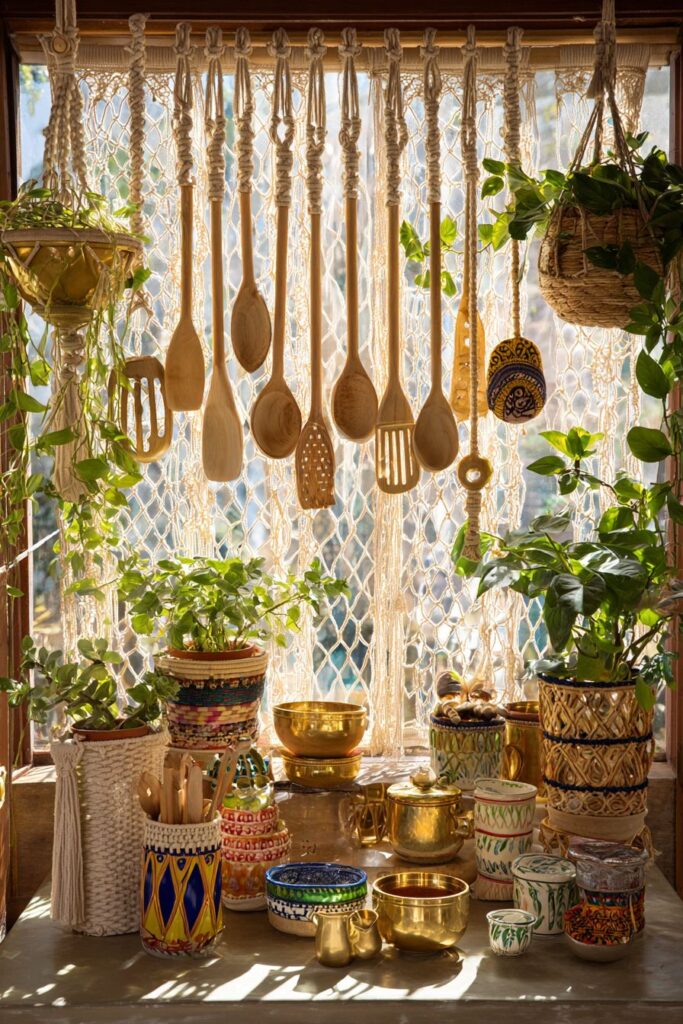
Warm natural lighting filters through hanging plants, creating the dappled shadows and organic light patterns that enhance the connection to natural elements while providing the dynamic illumination that keeps eclectic collections visually interesting. This lighting approach changes throughout the day as plants move and light sources shift, creating the ever-changing environment that reflects the bohemian appreciation for natural rhythms and seasonal variations. The interplay between artificial and natural elements creates the layered complexity that defines successful bohemian interiors.
Free-spirited aesthetic principles encourage mixing different cultural traditions, time periods, and artistic approaches to create unique environments that reflect individual personality rather than prescribed design rules. Artistic functionality ensures that creative expression enhances rather than compromises practical cooking capabilities, creating spaces that support both culinary creativity and artistic expression in daily life.
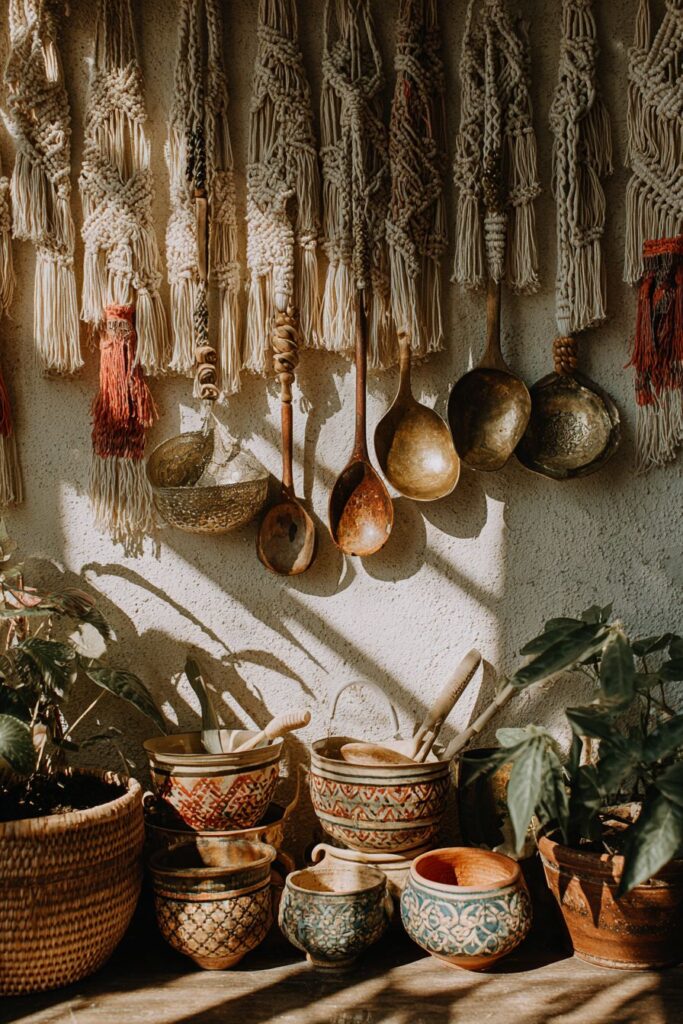
Key Design Tips:
- Mix different fiber arts techniques and cultural traditions to create visually rich and culturally diverse collections
- Position hanging elements at varying heights to create dynamic visual rhythm and accommodate different tool sizes
- Choose tools that reflect artistic individuality while maintaining practical functionality for serious cooking
- Include elements from multiple cultural traditions to create the global aesthetic that defines authentic bohemian style
- Allow collections to evolve organically over time rather than attempting to create complete schemes all at once
16. Professional Chef’s Commercial Grade
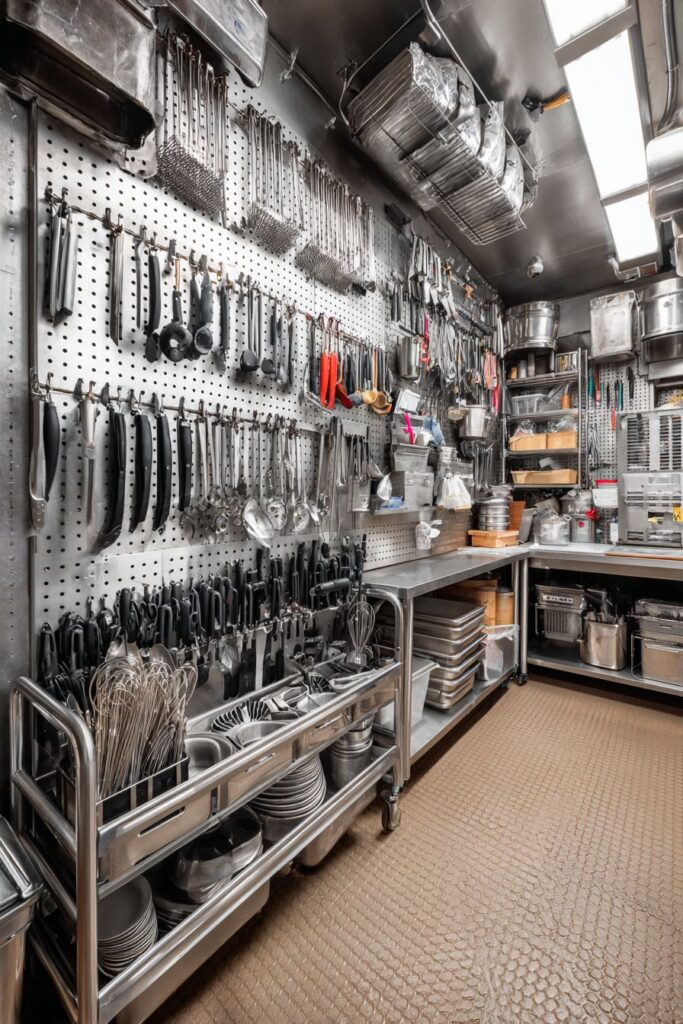
The uncompromising standards of professional culinary environments create kitchen utensil storage that prioritizes performance, durability, and efficiency above all other considerations, demonstrating how serious cooking demands tools that can withstand intensive daily use while maintaining precision and reliability. Stainless steel magnetic walls and rolling cart systems provide the flexibility and accessibility that professional cooking environments require while maintaining the sanitary standards essential to food safety. This approach recognizes that home cooks who take their craft seriously deserve the same quality tools that professional chefs rely upon daily.
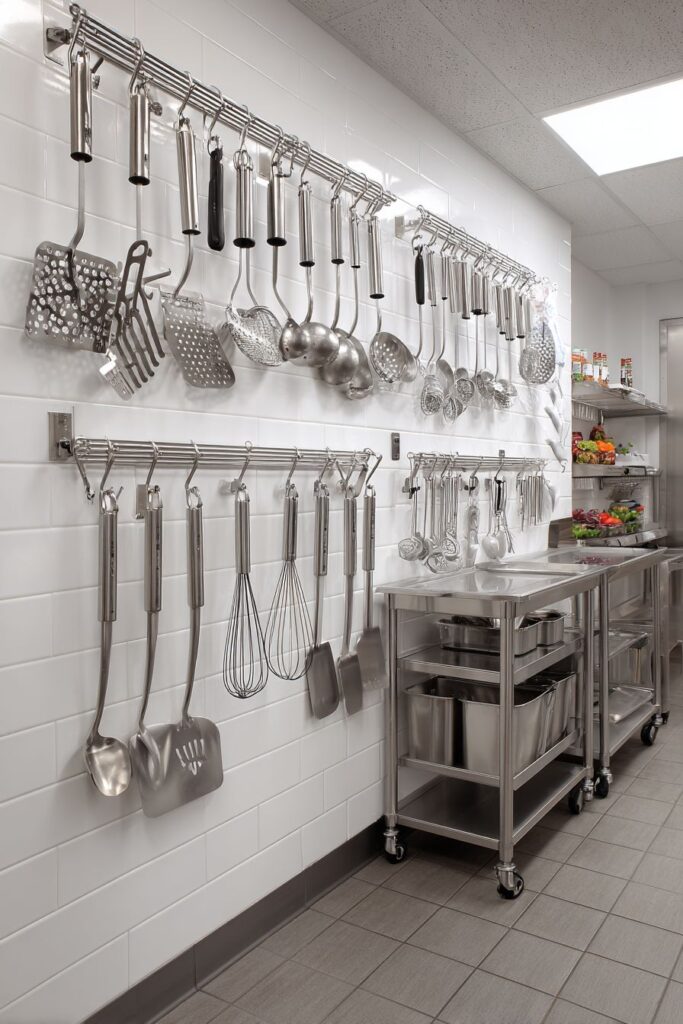
Precision measuring tools showcase the exacting standards that separate professional cooking from casual food preparation, providing the accuracy levels necessary for consistent results in both everyday cooking and complex baking applications. Heavy-duty mixing implements with ergonomic handles demonstrate the attention to human factors that makes professional tools superior choices for serious home cooks who spend significant time in food preparation. Specialized preparation utensils provide the specific functionality necessary for advanced techniques while maintaining the durability standards that justify their higher initial investment.
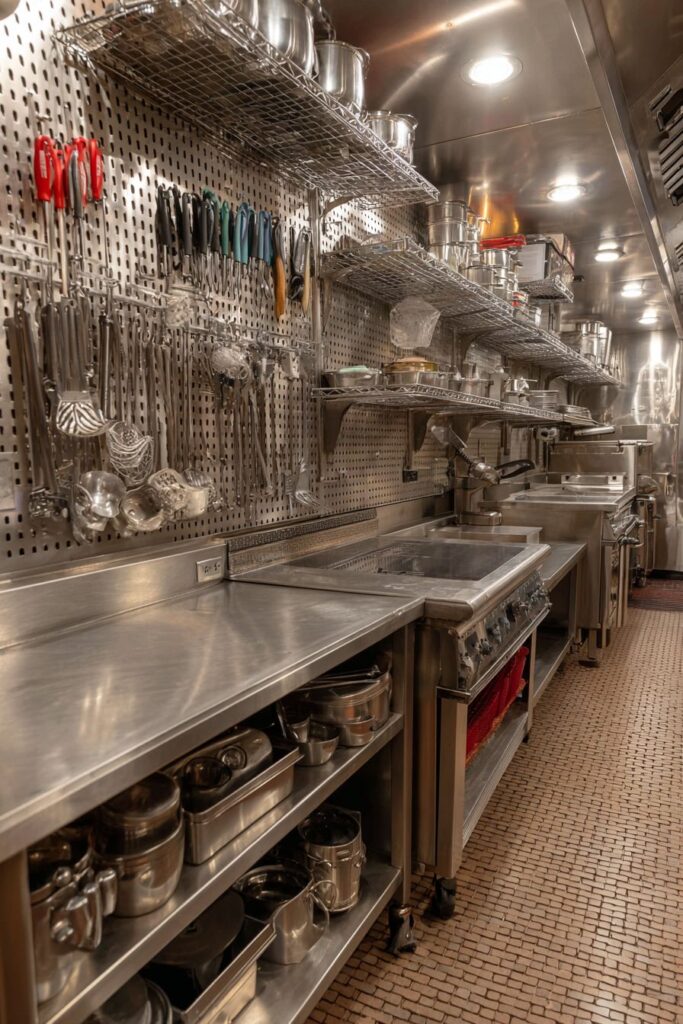
Bright task lighting illuminates functional workspaces with the intensity and color accuracy necessary for proper food preparation, ensuring that ingredients can be properly evaluated and cooking progress accurately monitored. This lighting approach eliminates the shadows and color distortions that can compromise food safety and preparation quality while providing the visual clarity necessary for precision work. The consistent illumination levels support both detailed prep work and general cooking activities.
The focus on serious culinary functionality eliminates purely decorative elements in favor of tools that contribute measurably to cooking performance and efficiency. Restaurant-quality organization systems ensure that every tool has its designated place while remaining instantly accessible during the intense activity periods that characterize serious cooking sessions. This organizational philosophy reflects professional kitchen wisdom accumulated through decades of high-volume food service experience.
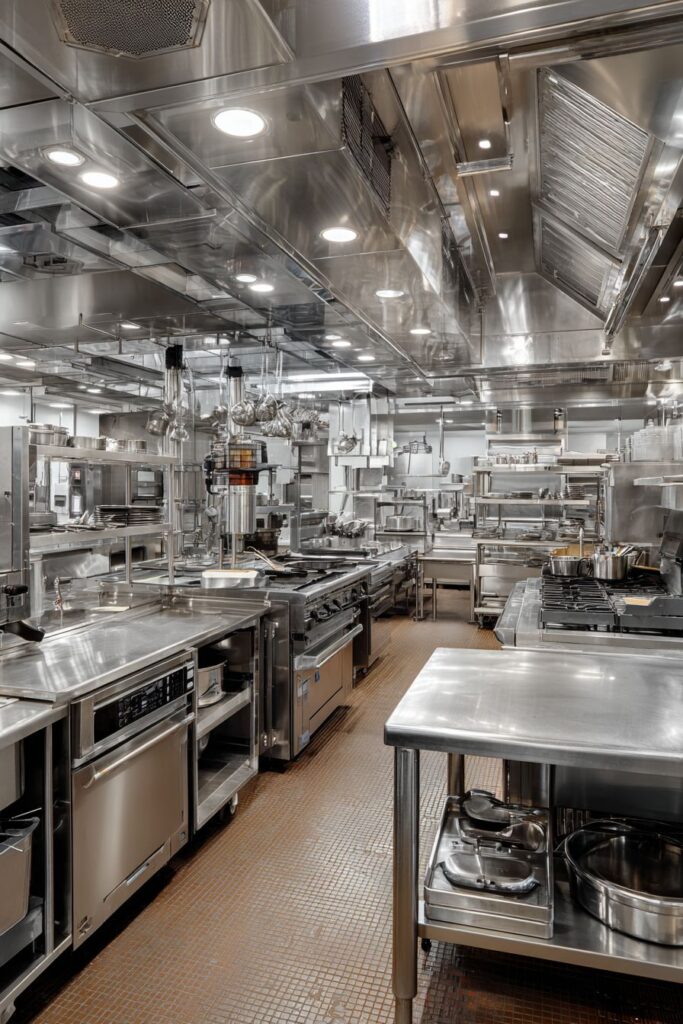
Key Design Tips:
- Invest in tools that meet professional standards for durability, performance, and safety rather than choosing based solely on price
- Organize tools based on workflow patterns and frequency of use rather than purely aesthetic considerations
- Position storage systems to minimize movement and maximize efficiency during intensive cooking sessions
- Choose materials and finishes that can withstand frequent cleaning and sanitization without degradation
- Include specialized tools for specific techniques rather than relying on multi-purpose implements that compromise performance
17. Vintage 1950s Pyrex Collection

The optimistic spirit of mid-20th century American domesticity finds perfect expression in kitchen utensil collections that celebrate the design innovations and color palettes that defined an era of unprecedented prosperity and household modernization. Original Pyrex containers and chrome-finished holders showcase the period’s embrace of new materials and manufacturing techniques that promised to make housework easier and more enjoyable while maintaining the aesthetic standards that made everyday objects sources of pride and pleasure. This approach recognizes that vintage design represents more than mere nostalgia, embodying genuine innovations that remain relevant for contemporary cooking needs.
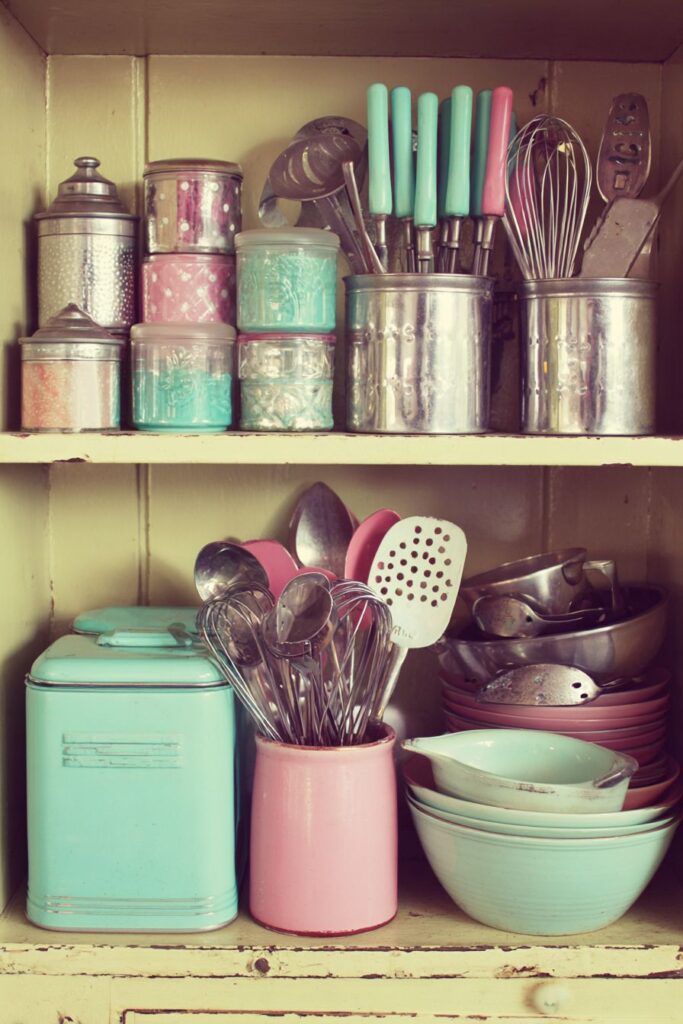
Bakelite-handled tools demonstrate the period’s fascination with synthetic materials that offered superior performance characteristics while enabling new aesthetic possibilities impossible with traditional materials. Aluminum measuring cups represent the democratization of professional-quality tools, making restaurant-grade functionality accessible to home cooks while contributing to the overall design narrative. Enameled serving pieces in authentic mint green and pink tones provide the signature color palette that immediately identifies genuine 1950s design while offering practical advantages including stain resistance and easy cleaning.
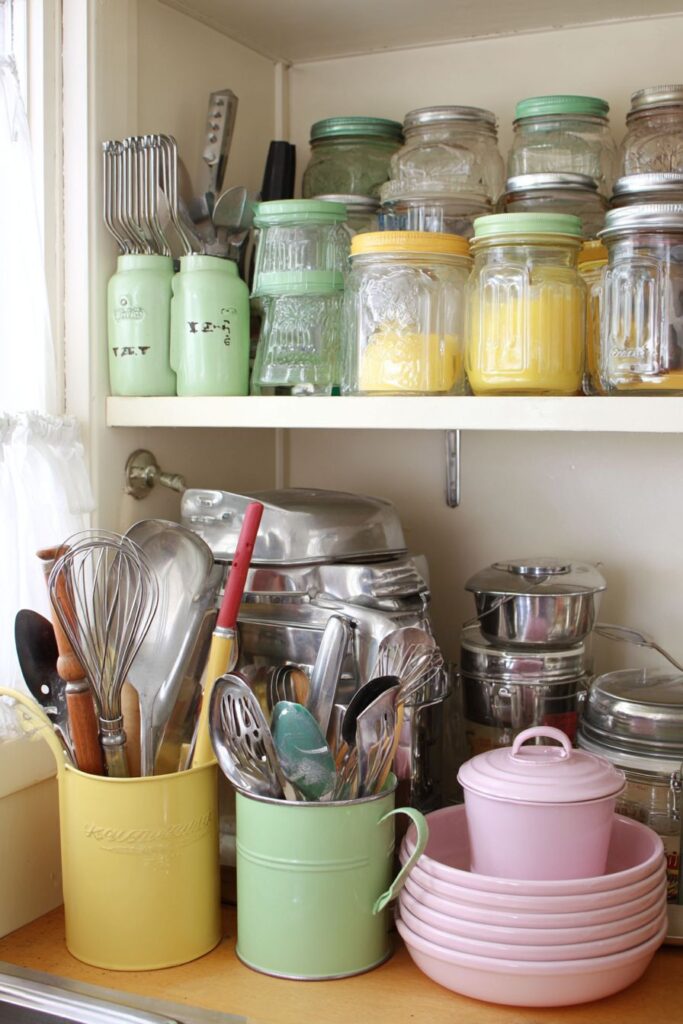
Soft natural lighting recreates the nostalgic atmosphere of mid-20th century domesticity while highlighting the chrome finishes and glossy surfaces that characterized the era’s embrace of modern materials and manufacturing techniques. This lighting approach emphasizes the optimistic brightness that defined 1950s kitchen design while showcasing the reflective qualities of period-appropriate materials. The interplay between natural light and polished surfaces creates the cheerful atmosphere that made these kitchens symbols of American prosperity and domestic contentment.
Period-accurate colors play a crucial role in maintaining authenticity, with the distinctive pastel palette reflecting the era’s departure from earlier earth tones in favor of synthetic hues that celebrated technological advancement. The careful coordination of mint green, pink, and chrome elements creates visual harmony while maintaining the bold color confidence that characterized post-war design optimism. Historical functionality ensures that vintage tools continue to perform reliably while providing tangible connections to the domestic innovations that transformed American home life.

Key Design Tips:
- Authenticate vintage pieces carefully to ensure period accuracy and avoid reproduction items that lack historical integrity
- Maintain consistent color coordination using only authentic 1950s palette choices for visual cohesion
- Position chrome elements to take advantage of natural light reflection without creating harsh glare
- Include original packaging and documentation when possible to preserve historical context and value
- Balance functional vintage tools with display pieces to create comprehensive period collections
18. Zero-Waste Sustainable Materials
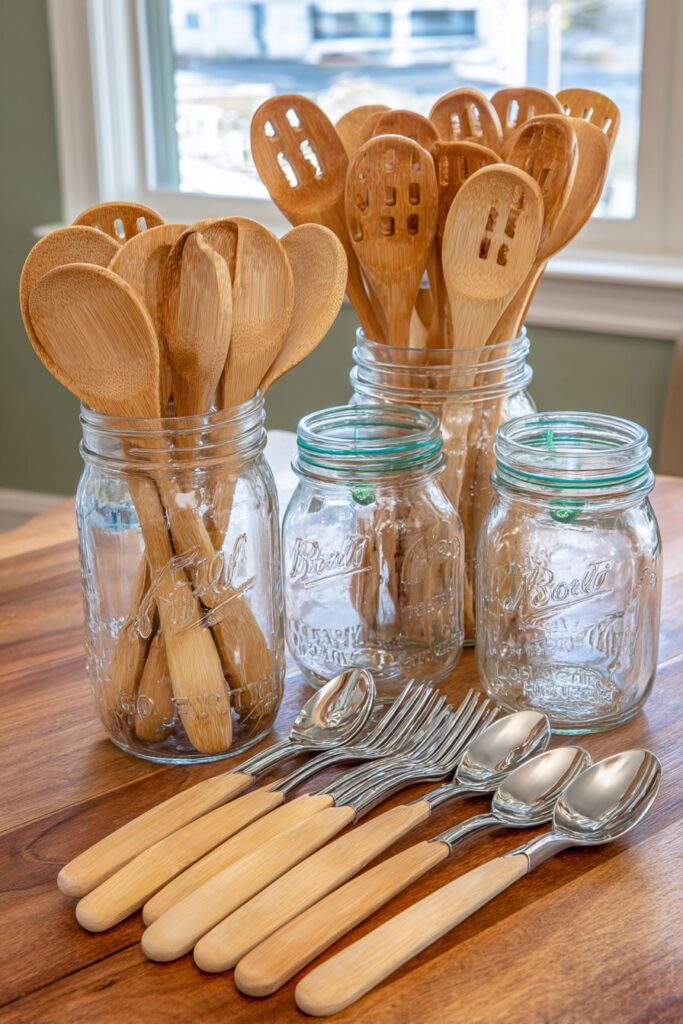
The growing environmental consciousness of contemporary society finds expression in kitchen utensil collections that prioritize sustainability, durability, and minimal environmental impact while maintaining the performance standards necessary for serious cooking endeavors. Sustainable kitchen utensils made from bamboo, recycled stainless steel, and compostable materials demonstrate how environmental responsibility can enhance rather than compromise culinary functionality. Repurposed mason jars provide charming storage solutions that give new life to containers that might otherwise enter waste streams while maintaining practical accessibility and visual appeal.
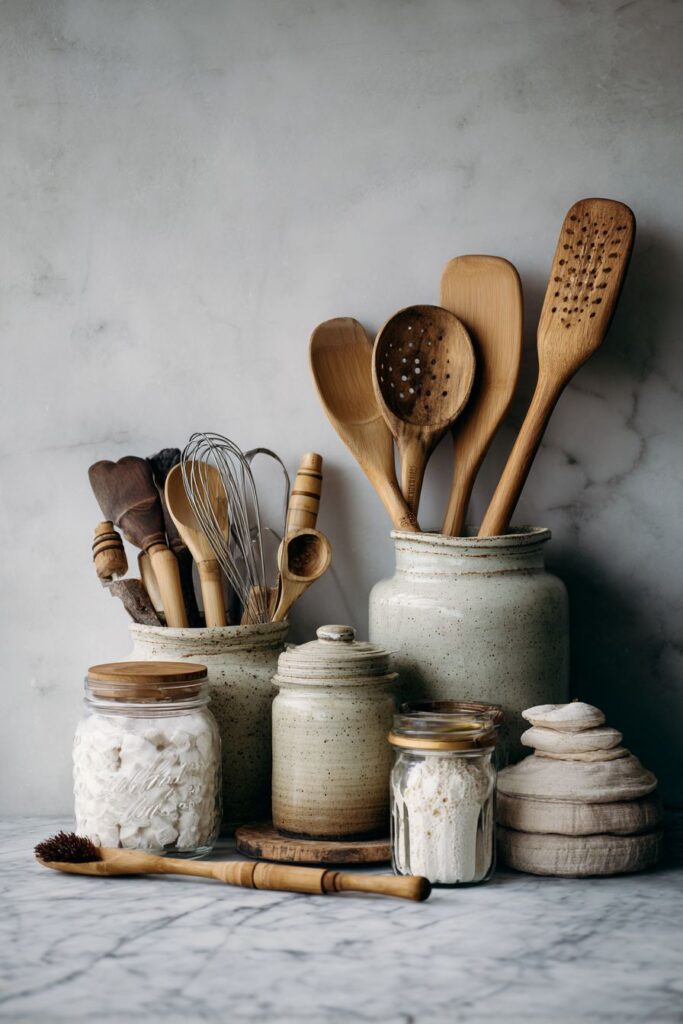
Eco-friendly collections emphasize durability and environmental responsibility through careful material selection and construction techniques that prioritize longevity over disposability. The natural finishes and minimal packaging approach reduce environmental impact while celebrating the inherent beauty of sustainable materials that improve with age and use. Bamboo utensils offer rapid renewability and natural antimicrobial properties while providing the warm aesthetic appeal that makes sustainable choices attractive rather than merely virtuous.
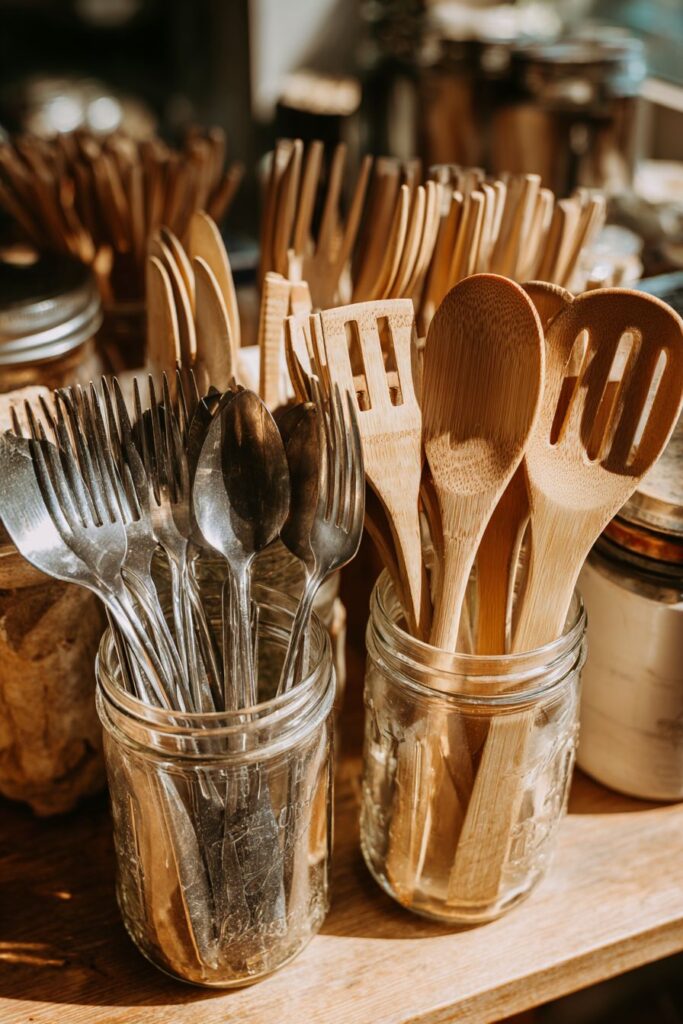
Soft natural lighting highlights organic textures and sustainable design choices while maintaining the connection to natural systems that defines environmentally conscious living. This lighting approach emphasizes the beauty of materials that have been chosen for their minimal environmental impact while providing the practical illumination necessary for efficient cooking. The celebration of natural textures and honest construction reflects the environmental movement’s appreciation for authentic rather than artificial beauty.
Environmental consciousness permeates every aspect of tool selection and organization, from the choice of renewable materials to the elimination of excessive packaging and synthetic finishes. Green living solutions demonstrate how practical environmental choices can enhance daily life while reducing ecological footprint through thoughtful consumption and waste reduction strategies.
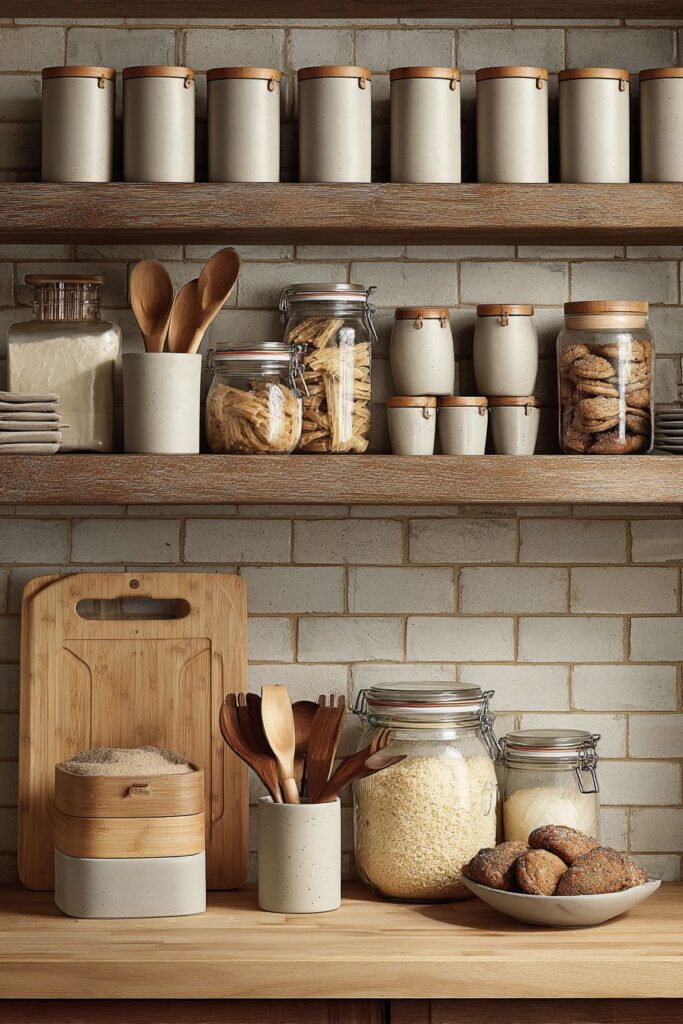
Key Design Tips:
- Research material sourcing and manufacturing processes to ensure genuine sustainability rather than superficial green marketing
- Choose tools designed for long-term durability rather than short-term convenience to minimize replacement frequency
- Repurpose existing containers and storage solutions before purchasing new organizational systems
- Support companies that demonstrate genuine environmental commitment through transparent practices and certifications
- Maintain and care for sustainable tools properly to maximize their lifespan and minimize waste generation
19. Compact RV Mobile Living
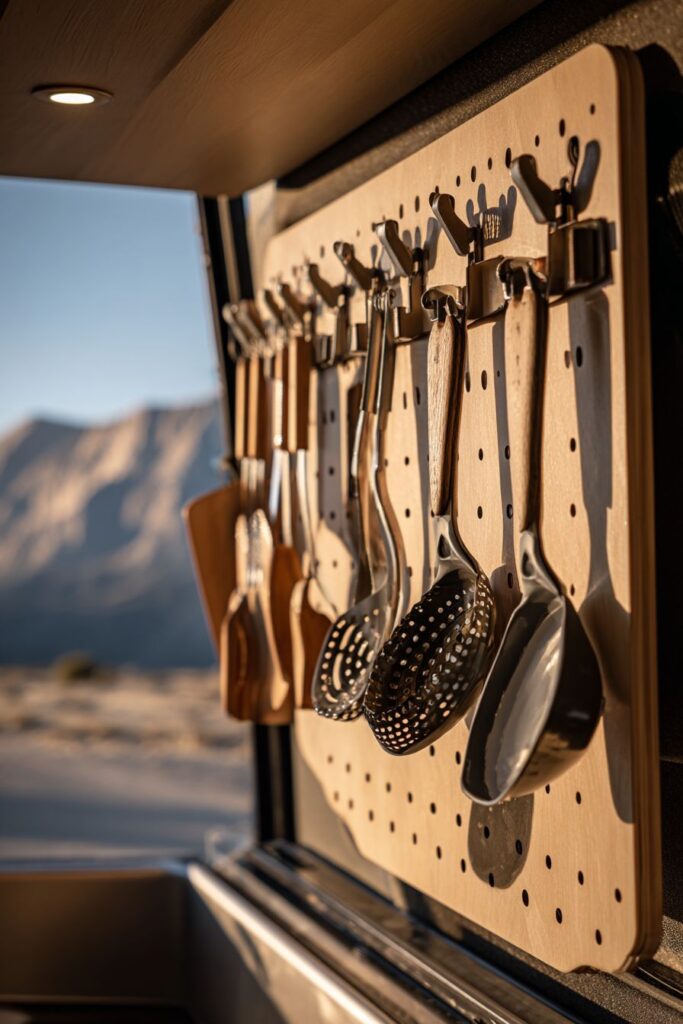
The unique challenges of mobile living transform kitchen utensil storage into exercises in space optimization and weight management while maintaining the functionality necessary for satisfying cooking experiences on the road. Magnetic kitchen utensil holders and collapsible tools designed specifically for mobile living demonstrate how thoughtful engineering can maximize utility while minimizing space requirements. The space-efficient approach requires careful consideration of every tool’s multiple functions and storage requirements to create comprehensive cooking capabilities within severely limited space constraints.
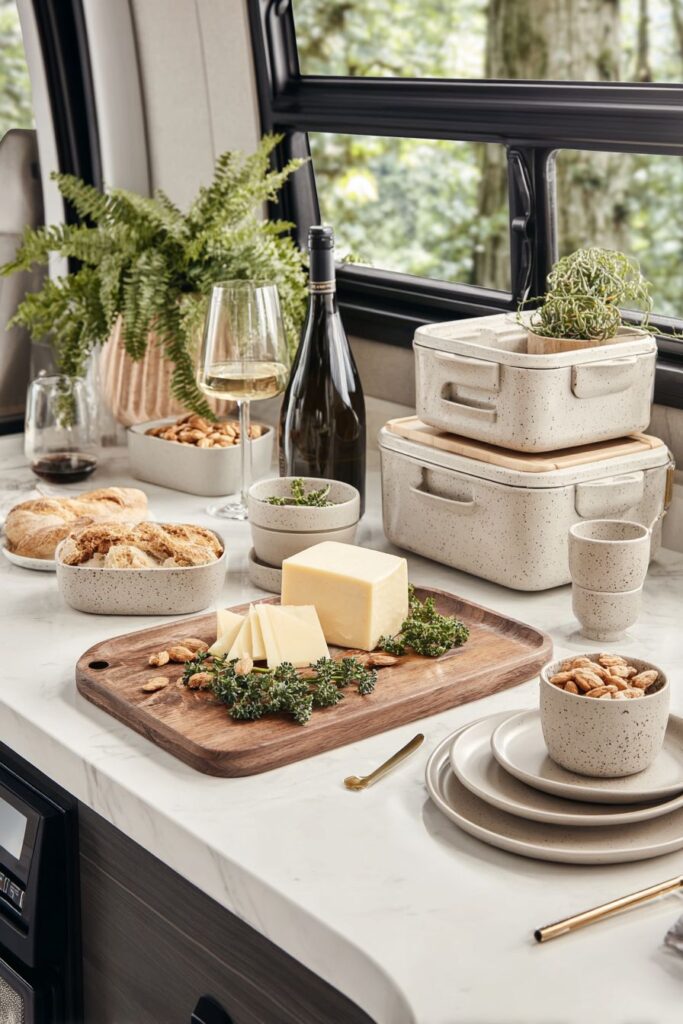
Nesting bowls and folding measuring cups exemplify the design innovations that make mobile cooking practical without sacrificing culinary capabilities or safety standards. Multi-purpose implements that serve several functions reduce the total tool count while maintaining the versatility necessary for varied cooking styles and ingredient availability. Secure storage solutions become essential considerations when tools must remain organized during travel while remaining easily accessible during cooking activities.
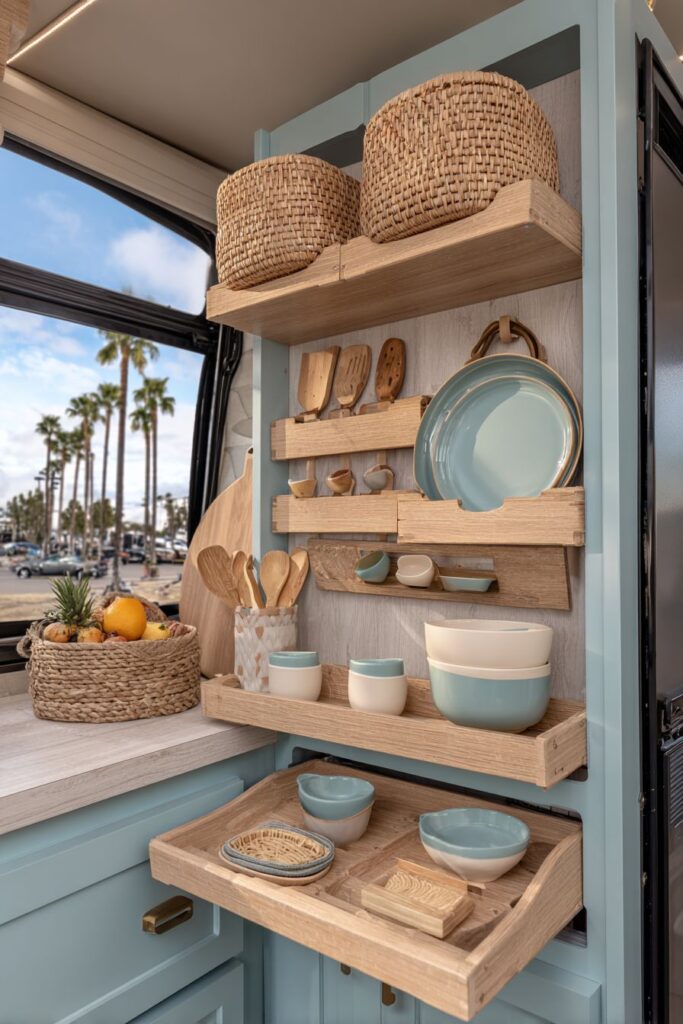
Natural daylight through small windows creates the cozy interior ambiance that makes compact spaces feel comfortable rather than cramped while providing adequate illumination for food preparation activities. This lighting approach must work efficiently with limited electrical capacity while maintaining the visual clarity necessary for safe cooking practices. The careful balance between natural and artificial lighting sources creates functional cooking environments within the constraints of mobile electrical systems.
Clever space optimization requires innovative storage solutions that maximize vertical space utilization while maintaining accessibility during the cooking process. Nomadic lifestyle functionality demands tools that perform reliably under varying conditions while maintaining compact storage profiles that don’t compromise living space quality. Travel considerations include weight distribution, secure mounting, and resistance to vibration damage during transit.
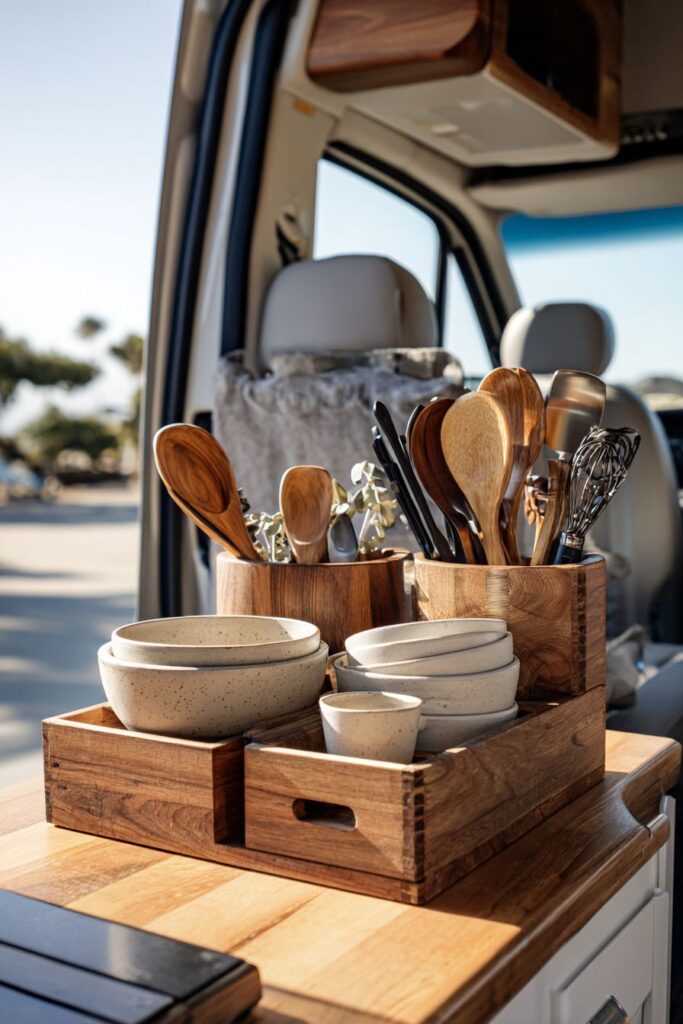
Key Design Tips:
- Prioritize multi-functional tools that serve several purposes rather than single-use specialty implements
- Secure all storage systems to prevent movement during travel while maintaining accessibility during cooking
- Choose lightweight materials that don’t compromise performance while minimizing vehicle weight penalties
- Plan storage based on frequency of use with most common tools in most accessible locations
- Include backup power considerations for any electrical tools or charging requirements
20. Gourmet Baking Specialized Tools
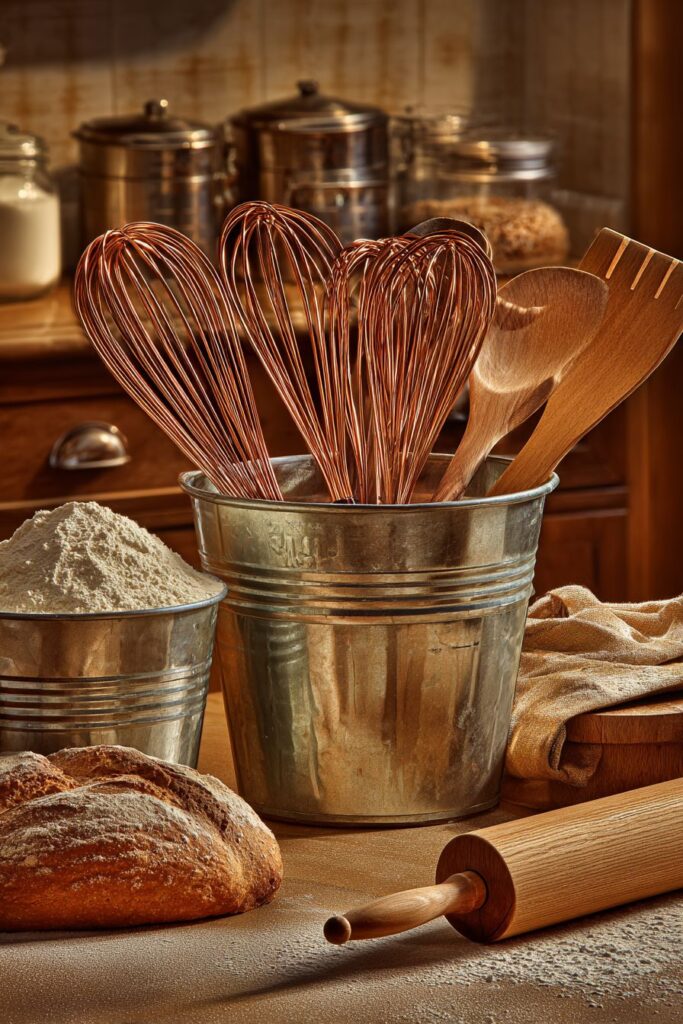
The exacting requirements of serious baking transform kitchen utensil storage into celebrations of specialized craftsmanship and traditional techniques that have been refined through generations of professional practice. Vintage French flour bins and wooden tool caddies provide authentic storage solutions that honor the European baking traditions while maintaining the accessibility necessary for frequent use. This approach recognizes that serious baking requires tools designed specifically for the unique challenges of working with flour, sugar, and other baking ingredients that demand precision and cleanliness.
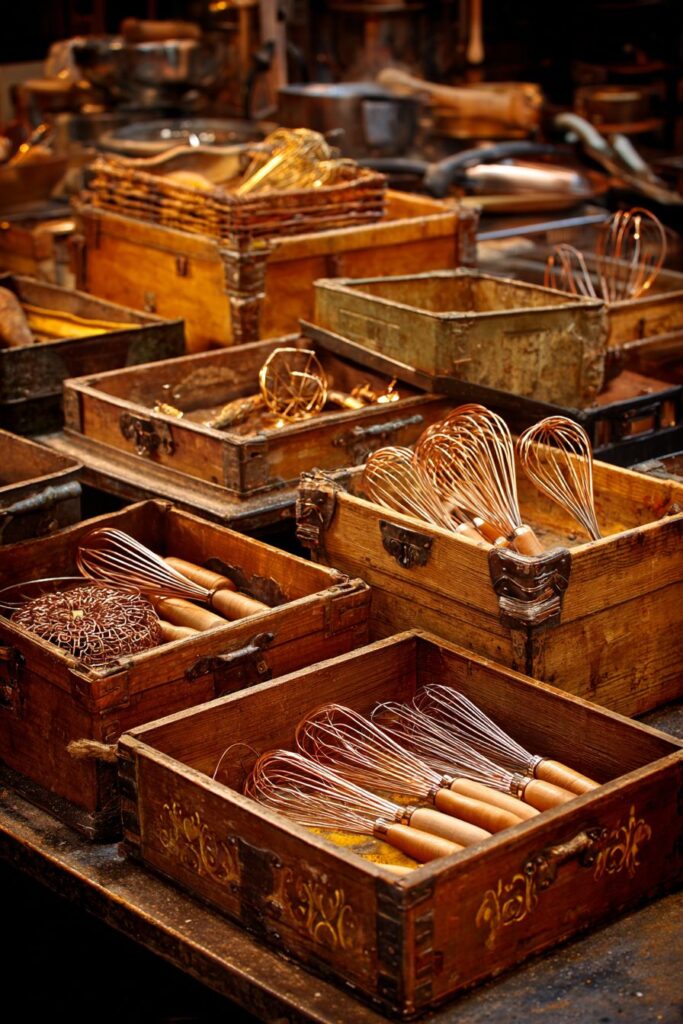
Hand-turned rolling pins showcase the traditional woodworking techniques that create tools superior to mass-produced alternatives through careful attention to weight distribution, surface texture, and ergonomic considerations. Precision measuring tools eliminate the guesswork that can ruin baking projects while maintaining the classic aesthetics that connect contemporary bakers to centuries of culinary tradition. Traditional whisks with copper details provide superior performance characteristics through careful material selection and construction techniques while contributing to the overall aesthetic narrative of serious baking commitment.
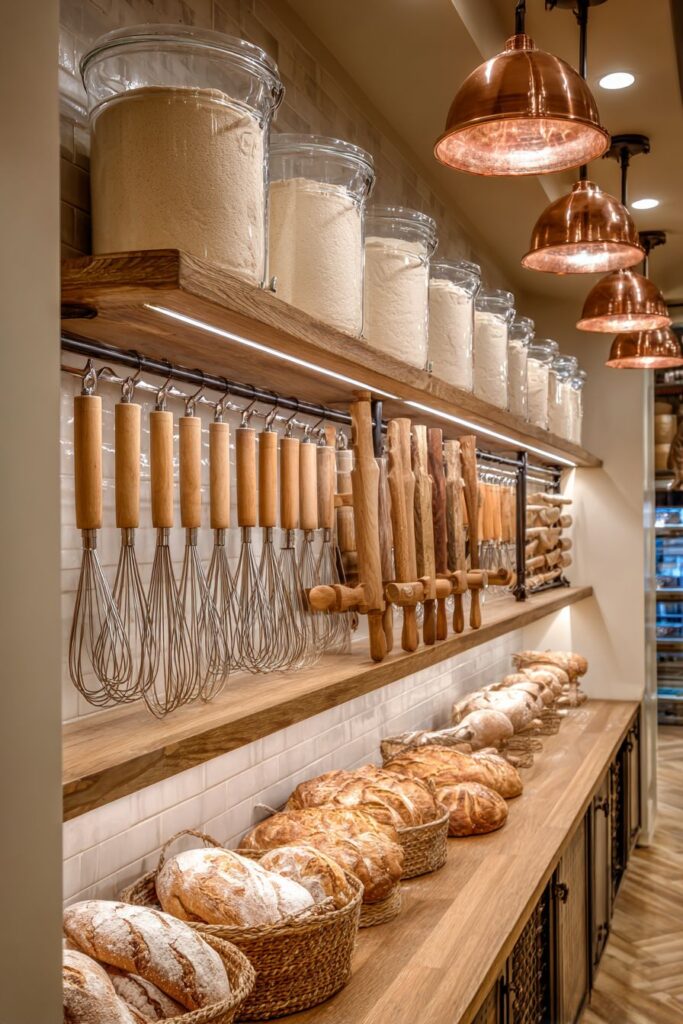
Warm golden lighting highlights flour dust and well-used surfaces, creating the authentic bakery atmosphere that reflects the serious nature of baking as both craft and art form. This lighting approach emphasizes the working nature of the tools while maintaining the romantic appeal that makes baking such a satisfying creative pursuit. The interplay between warm lighting and traditional materials creates the inviting atmosphere that makes baking spaces feel like natural gathering places for family and friends.
Serious baking focus requires tools that meet professional standards for accuracy, durability, and performance while maintaining the aesthetic appeal that makes them worthy of display rather than concealment. Traditional craftsmanship ensures that tools will continue to perform reliably while developing the patina and character that makes well-used baking implements so appealing and personally meaningful.
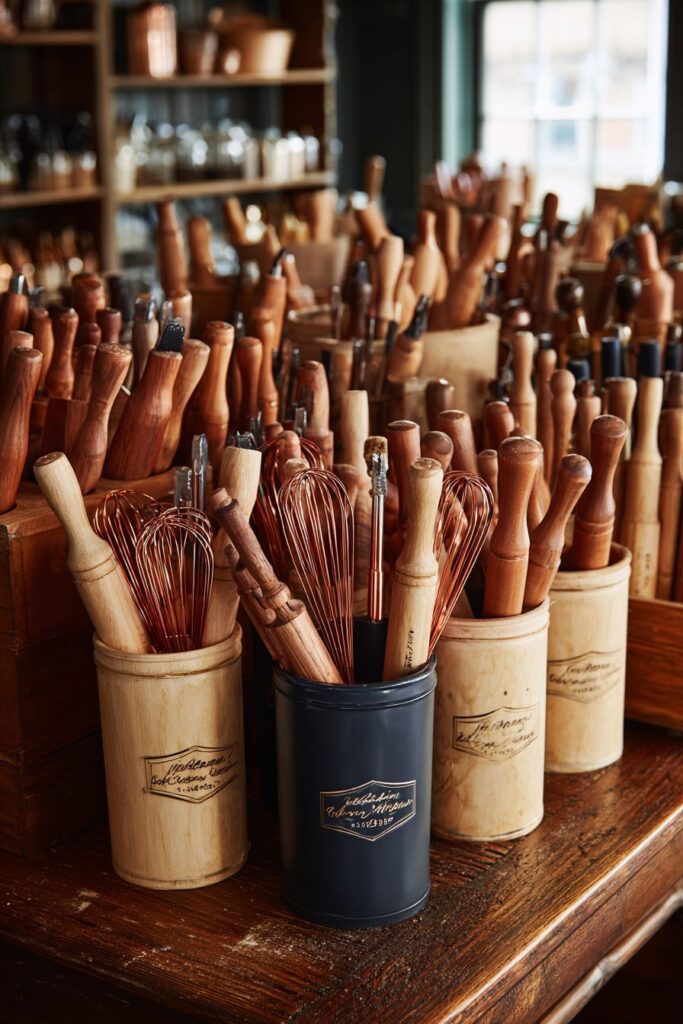
Key Design Tips:
- Invest in tools that meet professional baking standards for accuracy and consistency rather than choosing based on price alone
- Organize tools based on baking workflow patterns with measuring tools, mixing implements, and shaping tools grouped logically
- Choose storage solutions that protect tools from flour dust and moisture while maintaining easy accessibility
- Include both vintage pieces with proven performance history and contemporary tools that meet modern standards
- Position lighting to minimize shadows during detailed baking work while maintaining the warm atmosphere that makes baking enjoyable
Why These Kitchen Utensil Designs Represent the Best in Culinary Organization
The twenty kitchen utensil design concepts presented in this comprehensive guide represent the pinnacle of culinary organization excellence because they successfully balance functional performance with aesthetic appeal while addressing the diverse needs of contemporary cooking enthusiasts. Each approach demonstrates how thoughtful tool selection and intelligent storage solutions can transform ordinary kitchen implements into inspiring design elements that enhance both cooking performance and overall kitchen atmosphere. These best kitchen utensil displays prove that superior organization goes far beyond mere tidiness to encompass the creation of environments that inspire culinary creativity and support serious cooking endeavors.
The magnetic wall organization systems featured in modern kitchen designs represent breakthrough thinking in space utilization and tool accessibility, eliminating the frustration of cluttered drawers while creating dynamic visual displays that celebrate the inherent beauty of well-designed cooking implements. Professional-grade stainless steel and copper utensil collections demonstrate how superior materials improve both performance and longevity while contributing to sophisticated aesthetic environments that reflect serious culinary commitments. The integration of warm pendant lighting with metallic surfaces creates ever-changing visual displays that transform functional storage into artistic installations worthy of admiration.
Farmhouse ceramic crock storage solutions prove that traditional approaches remain relevant for contemporary needs while providing the warmth and character that make kitchens feel like the heart of the home rather than sterile work environments. The vintage-inspired collections featuring wooden spoons with natural grain variations and antique copper measuring implements create tangible connections to culinary heritage while providing superior performance characteristics that justify their continued use in modern cooking applications.
Scandinavian drawer organization systems utilizing sustainable bamboo dividers represent the perfect marriage of environmental consciousness with functional excellence, demonstrating how ecological responsibility can enhance rather than compromise kitchen organization effectiveness. The precision compartmentalization achievable through custom drawer systems eliminates wasted space while maintaining the visual harmony that defines successful minimalist design approaches.
Contemporary floating shelf displays with integrated LED strip lighting showcase how modern technology can enhance traditional storage concepts without overwhelming the overall design aesthetic. The artisanal wooden cutting boards and hand-forged serving implements featured in these displays prove that handcrafted quality remains superior to mass-produced alternatives while contributing to the sophisticated atmosphere that defines contemporary kitchen design excellence.
Vertical space maximization solutions address the real-world challenges of small-space living without compromising cooking functionality or aesthetic appeal, proving that intelligent design can overcome even severe spatial limitations. The multi-tier storage systems and collapsible tool collections demonstrate how engineering innovation can support serious cooking endeavors within compact urban environments while maintaining the visual appeal necessary for comfortable daily living.
French country copper collections and Mediterranean artisanal ceramics represent the timeless appeal of regional design traditions that have evolved through centuries of practical use while maintaining distinctive cultural characteristics that provide authentic aesthetic foundations. These time-honored approaches prove that the best kitchen designs emerge from genuine cultural expressions rather than artificial stylistic impositions, creating environments that feel authentic rather than contrived.
Industrial loft aesthetics and smart kitchen technology integration demonstrate how contemporary design can honor functional priorities while maintaining the sophisticated edge that defines urban living environments. The commercial-grade tool collections and precision digital instruments featured in these approaches prove that serious cooking performance often requires professional-quality implements that bring restaurant capabilities to home kitchen environments.
Luxury marble and brass carousel systems and Japanese zen bamboo displays represent opposite ends of the aesthetic spectrum while sharing common commitments to material quality and organizational excellence that transcend stylistic preferences. These approaches prove that successful kitchen utensil organization depends more on thoughtful consideration of functional relationships than on adherence to specific design rules or cultural traditions.
The comprehensive range of approaches presented in this guide ensures that every cooking enthusiast can find organizational solutions that match their specific needs, aesthetic preferences, and spatial constraints while maintaining the performance standards necessary for serious culinary endeavors. From sustainable zero-waste collections to professional chef commercial-grade systems, each approach demonstrates proven strategies for creating kitchen environments that support both cooking excellence and design sophistication.
Conclusion
The exploration of these twenty distinctive kitchen utensil design approaches reveals that successful culinary organization transcends mere functionality to encompass the creation of inspiring environments that celebrate the art and craft of cooking while supporting the practical needs of contemporary home chefs. Each design philosophy presented demonstrates unique solutions to the universal challenges of kitchen organization while maintaining the aesthetic integrity that transforms cooking spaces into the heart of the home.
The key insight emerging from this comprehensive analysis is that the best kitchen utensil collections successfully balance multiple considerations: functional performance that supports serious cooking endeavors, aesthetic appeal that enhances overall kitchen design, material quality that ensures longevity and reliability, and organizational systems that maintain accessibility while preventing clutter. Whether embracing the rustic charm of farmhouse ceramics, the sophisticated precision of Scandinavian minimalism, or the cutting-edge integration of smart technology, successful approaches share common commitments to thoughtful tool selection and intelligent storage solutions.
The diversity of successful organizational strategies proves that there is no single correct approach to kitchen utensil design, but rather a rich palette of possibilities that can be adapted to individual needs, preferences, and constraints. From compact RV solutions that maximize every square inch to luxury carousel systems that celebrate premium materials and craftsmanship, each approach offers valuable insights that can inform and inspire readers to create their own ideal culinary environments.
The investment in quality kitchen utensils and thoughtful organization systems pays dividends far beyond their initial cost through improved cooking performance, enhanced kitchen aesthetics, and the daily satisfaction that comes from working with beautiful, well-designed tools in thoughtfully organized spaces. The kitchen utensil collections and storage solutions explored in this guide represent more than mere functional necessities – they embody the tools and environments that transform cooking from chore to craft, making every culinary experience an opportunity for creativity, satisfaction, and genuine pleasure in the art of nourishing ourselves and those we love.
